Last updated: 22nd August 2022
We decided to explore the Portuguese island of Madeira – one of Europe’s few sub-tropical destinations. It used to have a reputation as an island for golden oldies, but things have changed thanks in part to being the home of Cristiano Ronaldo. In this blog post, we’ll show you the 10 best things to do in Funchal if you’re staying for a week as we did in Funchal plus some other highlights of Madeira island. Or if you’re short on time watch our Madeira travel video above for a quick taster.
Table of Contents
About Madeira
Madeira is a small island in the middle of the Atlantic Ocean just 350 miles off the North West coast of Africa. It’s the largest of the Portuguese Madeiran Archipelago of 4 islands, 35 miles long by 16 miles wide. Madeira is famous for its green volcanic peaks, flowers, hiking trails and Madeira wine.
Described as “The garden of the Atlantic” because of the island’s lush vegetation and exotic flowers that bloom all year. Part of Madeira is a UNESCO World Heritage Site because it has the world’s largest surviving laurel (Laurissilva) forest that used to cover a large part of Europe millions of years ago.
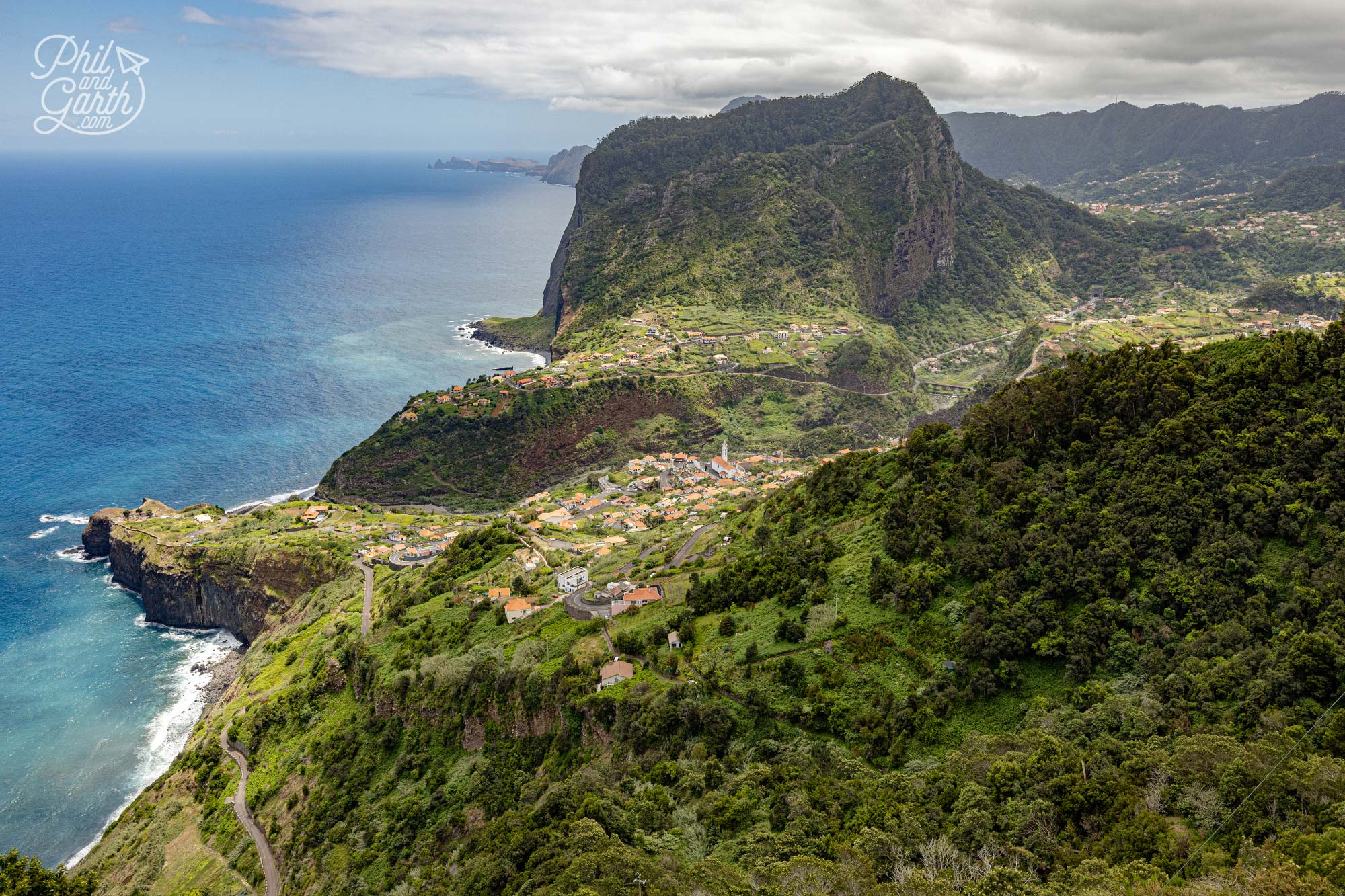
Madeira – The garden of the Atlantic
The island is actually the top of an extinct volcano which rises 6,000 metres from the ocean bed. Unlike other volcanic islands further south like Lanzarote or Tenerife which are dry and have a desert heat climate, Madeira is lush and green. That’s because Madeira has a mild subtropical climate making it an ideal destination all year round with average temperatures of 25ºC in the summer and 19ºC in the winter. Madeira’s mountainous terrain creates many different microclimates, so there are no extremes of hot or cold temperatures. The south is warm and sheltered where you’ll find the majority of hotels in Madeira’s capital city, Funchal. Farmers use the sunny south coast to grow bananas all year round, whilst the north of the island is wetter and windier. The interior of the island is much more wild and mountainous and loved by hikers.
Madeira is not really the place to go for a beach holiday as most of the island’s beaches are made of pebbles, however, there are a couple of man-made sandy beaches to be found (Calheta & Machico).
About Funchal – Madeira’s Capital City
Funchal is Madeira’s capital city best known for its gardens, harbour and spectacular New Year’s eve fireworks shows. Funchal is built on the slopes of a natural amphitheatre which leads to the natural deep harbour where many cruise ships dock for the night. The city can get very busy when a few cruise ships are in port.
What struck us is how green and lush Funchal is with banana plantations dotted around the city and all the flowers in full bloom. It’s also incredibly clean and reminded us a little of spotless Singapore. Funchal is named after fennel (funcho) which used to grow here when the Portuguese first discovered the island in 1419.
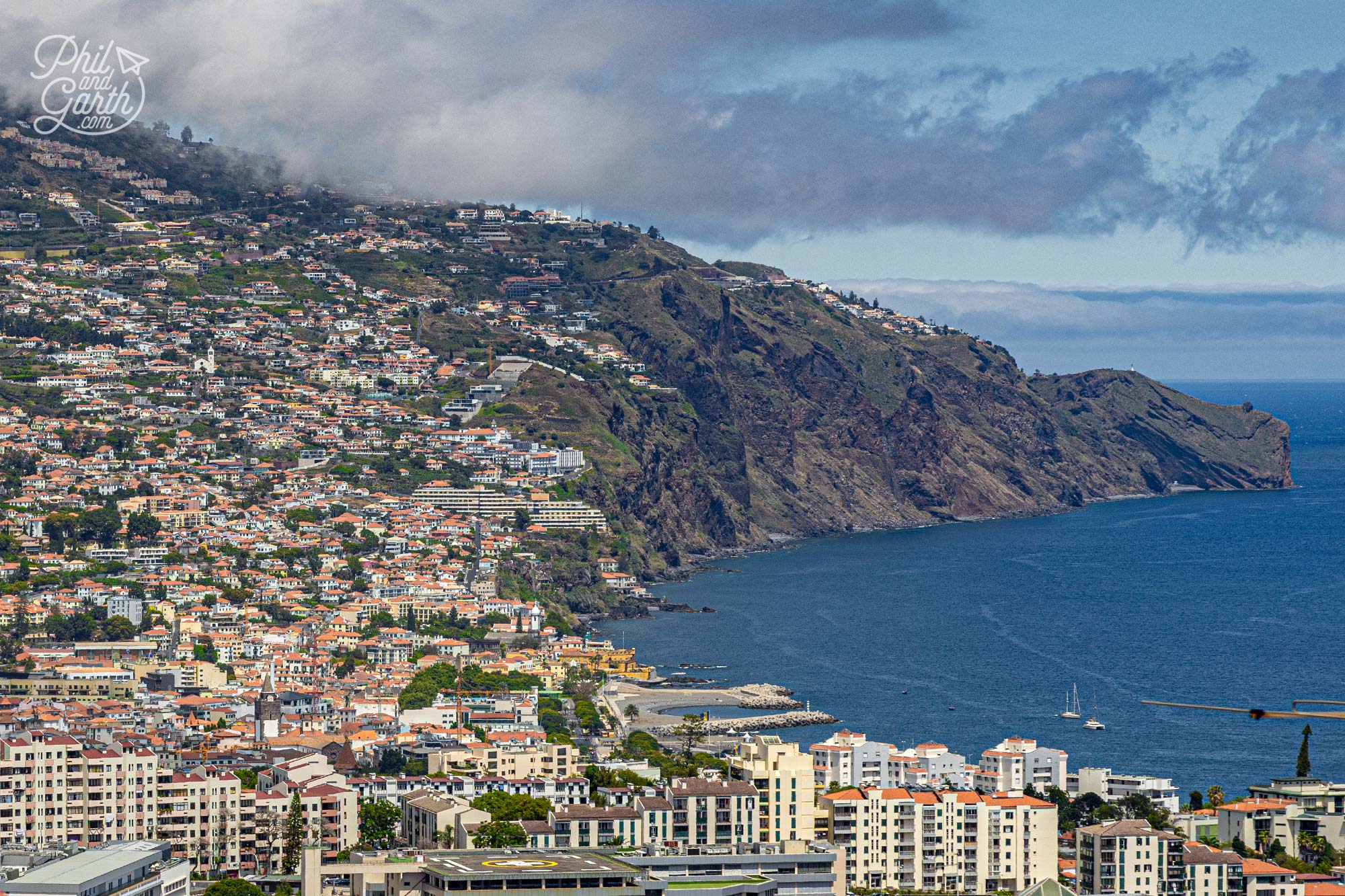
Funchal is built on the slopes of a natural amphitheatre
Wandering around the streets there’s lots of colonial Portuguese architecture and along the seafront promenade are nice open-air bars and restaurants, it all feels and looks very cosmopolitan. The main street, Avenida Arriaga is lined with tall jacaranda trees which have distinctive purple flowers that bloom in April. Funchal is a sleepy city by day and there’s virtually no crime making it safe to visit day and night.
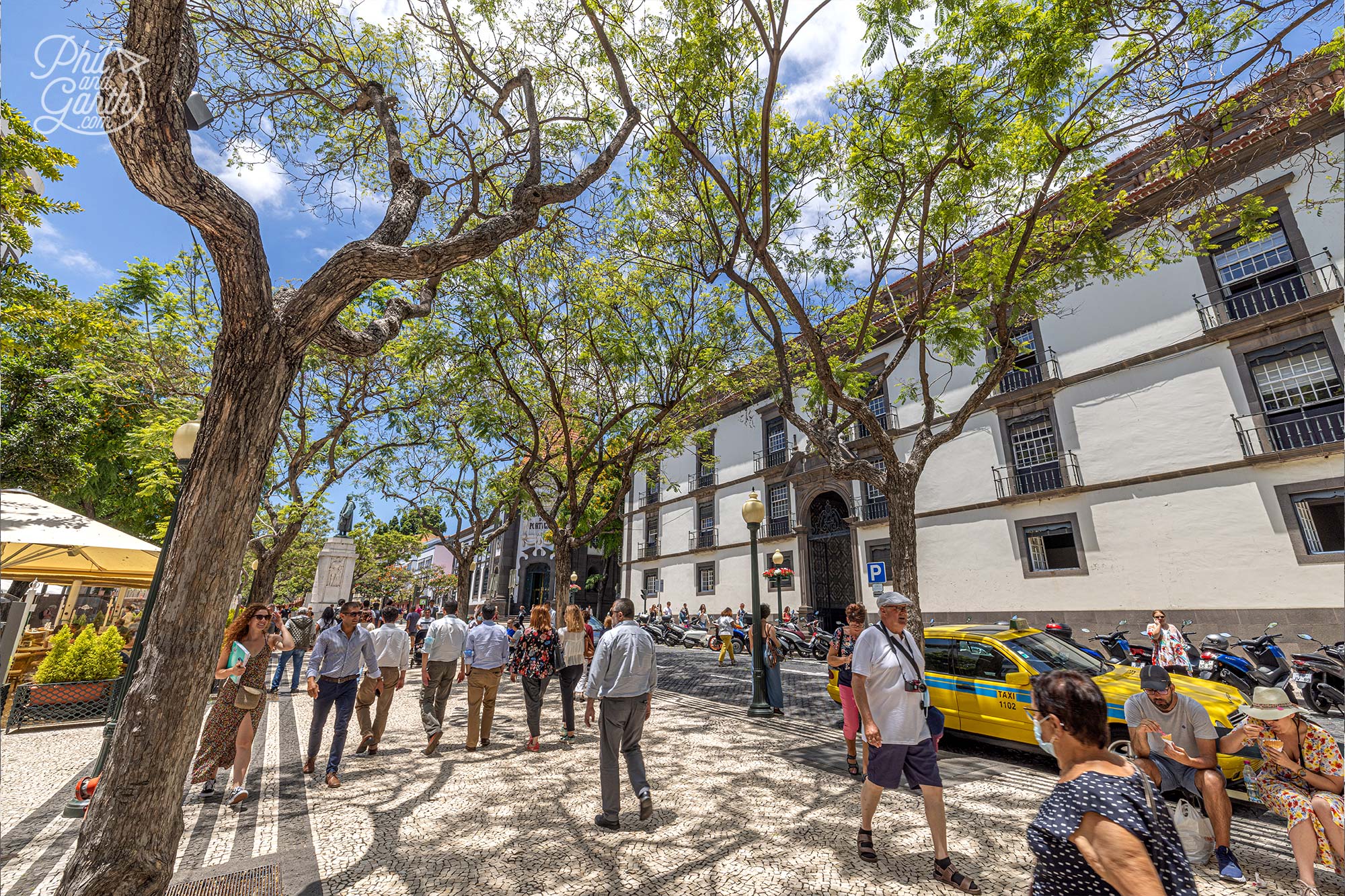
The pretty Avenida Arriaga, Funchal
Funchal is also home to the famous footballer, Cristiano Ronaldo. They love him here, so much that they renamed the airport after him and even built a statue and a museum (Museu CR7) dedicated to him. Try not to cringe when you see the Ronaldo statue with his bulge that people like to touch and rub!
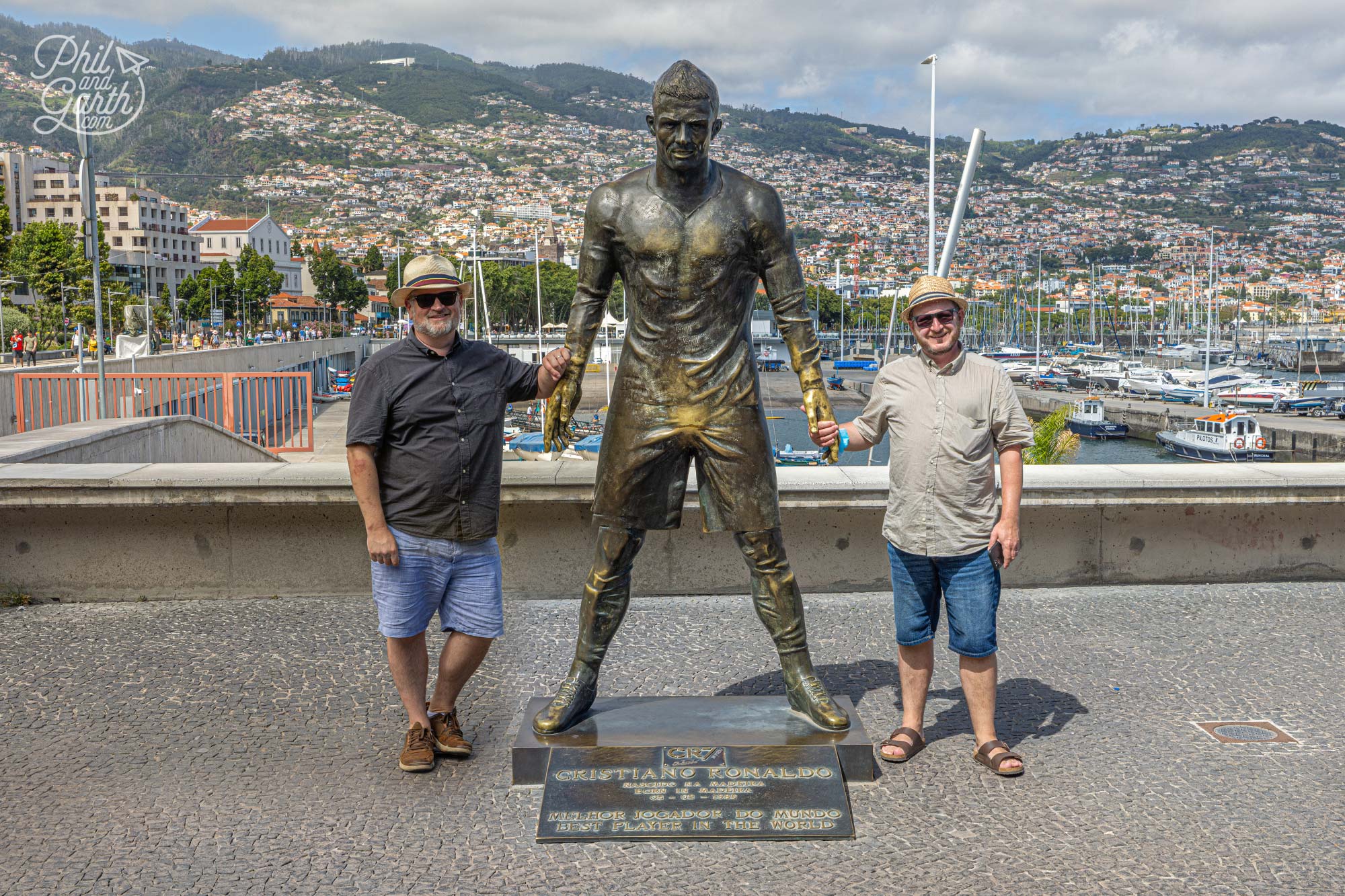
Phil and Garth with Cristiano Ronaldo outside the museum
10 Great Things to do in Funchal, Madeira
1. Funchal’s Old Town (Zona Velha)
The best part of Funchal is the small Old Town (Zona Velha) is like a little version of Barcelona in Spain – bags of character with cobbled streets, shops, charming squares and lots of cafes, bars and restaurants. Check out some key buildings like the gothic style Cathedral which dates back to the Portuguese Age of Discovery from the 16th century.
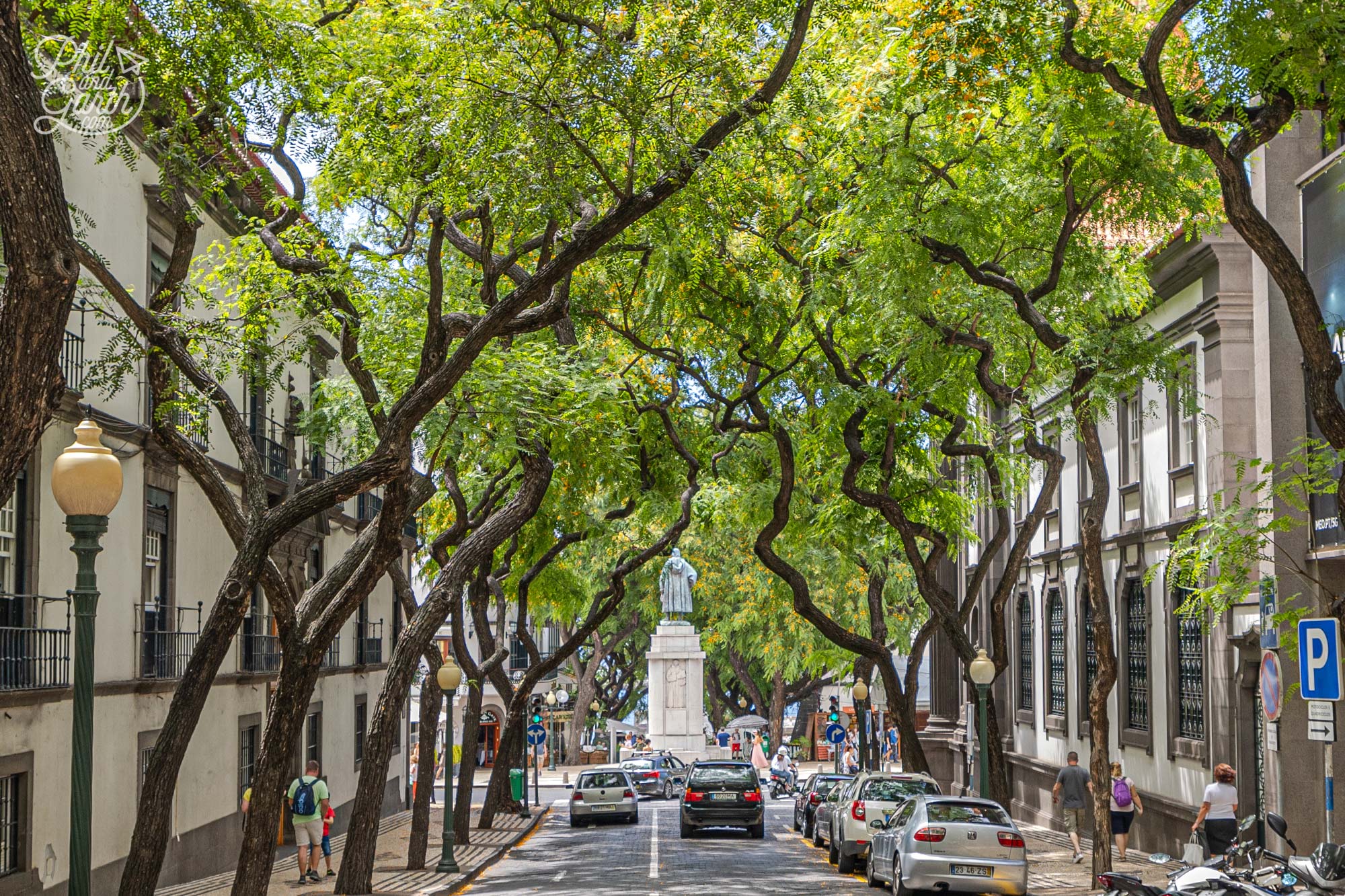
Funchal’s lovely tree lined streets
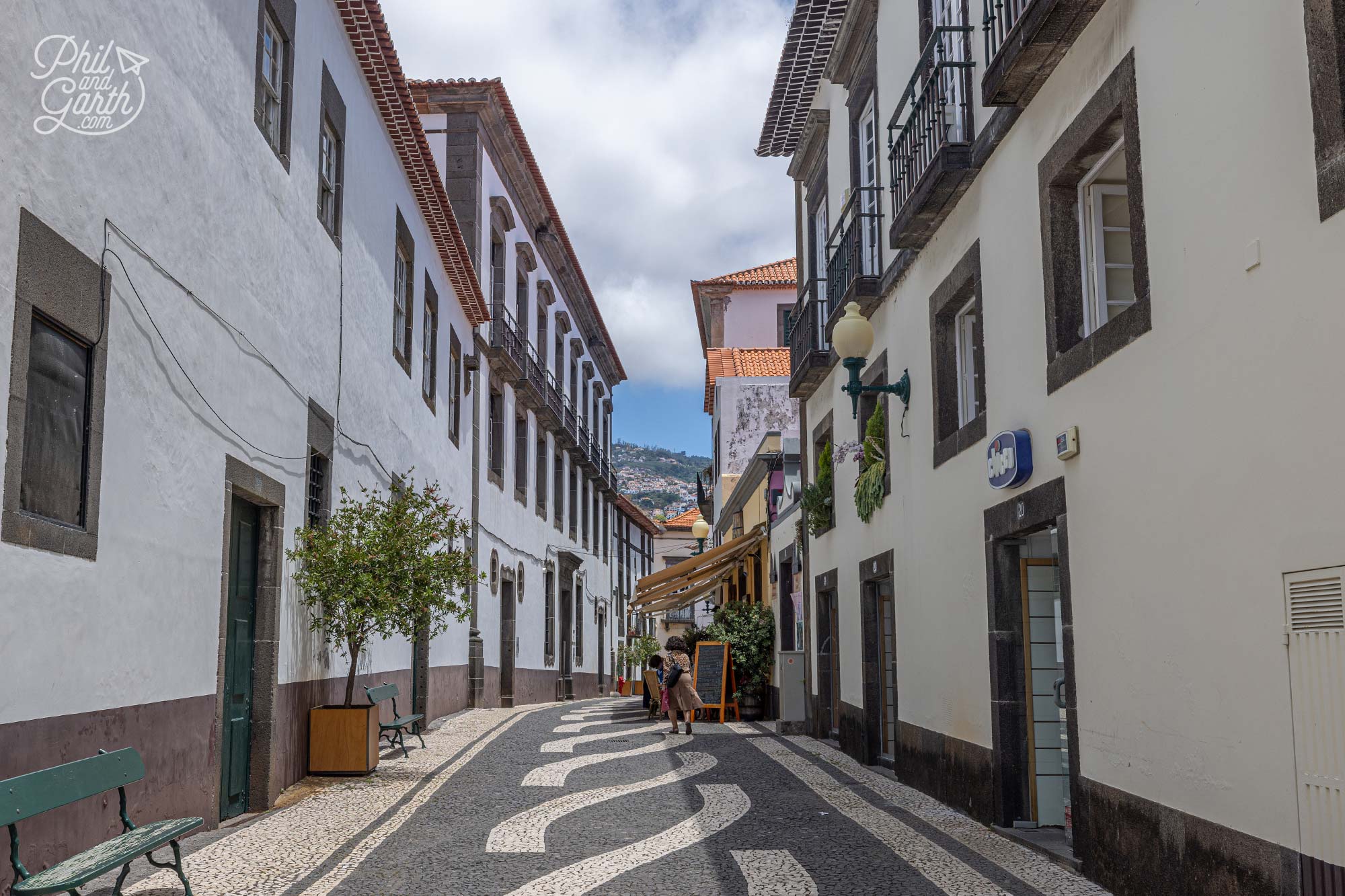
Exploring the back street’s of Funchal’s old town
Garth loved all the chequerboard mosaic patterned pavements called ‘calçada’. Designs are black and white and use white limestone and black volcanic rock. The semi-circular patterned square outside the impressive 18th-century town hall and Igreja do Colégio church is the most impressive.
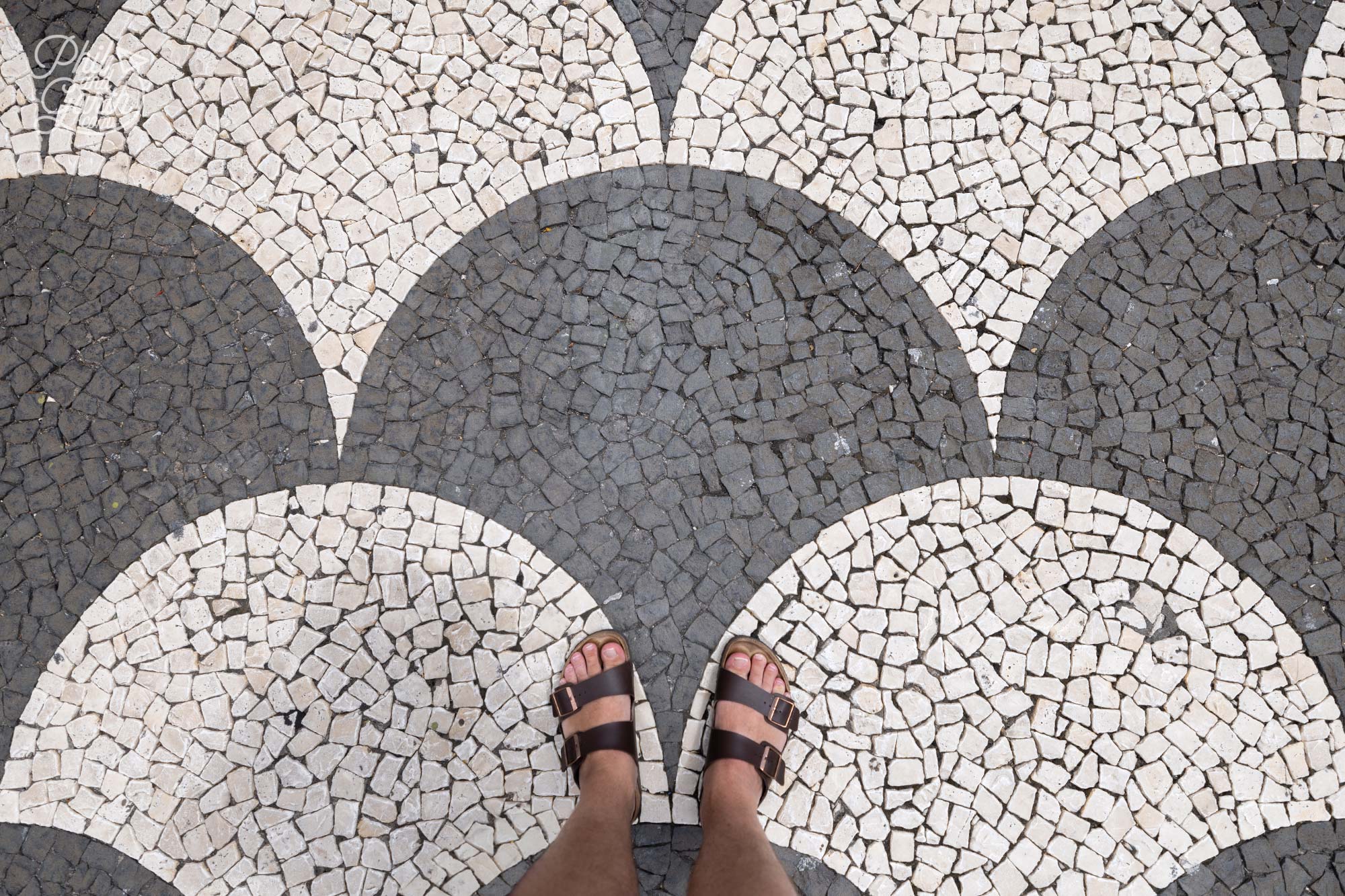
Funchal’s mosaic pavements are called ‘calçada’
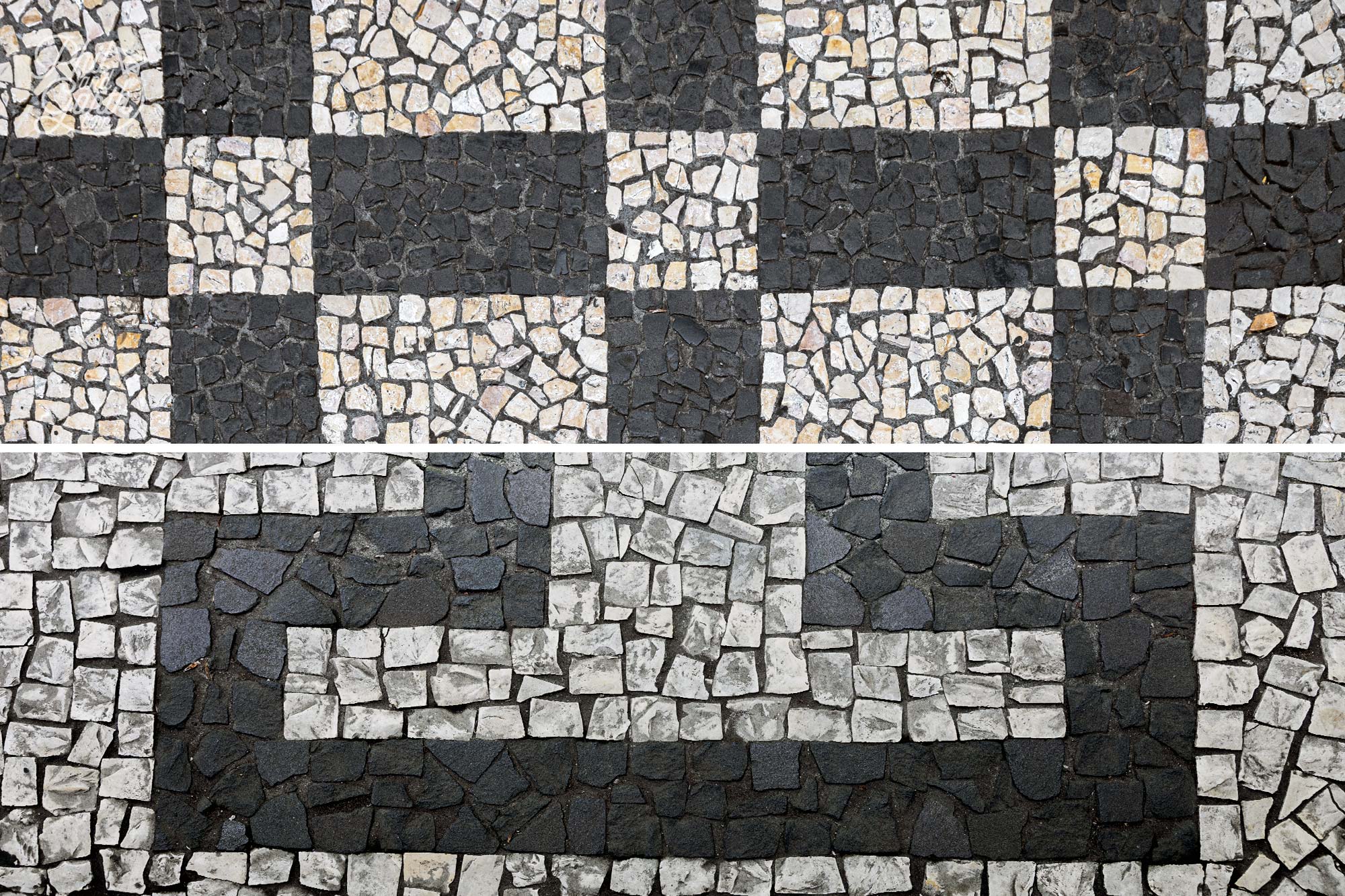
You’ll discover lots of different chequerboard patterns all over Funchal
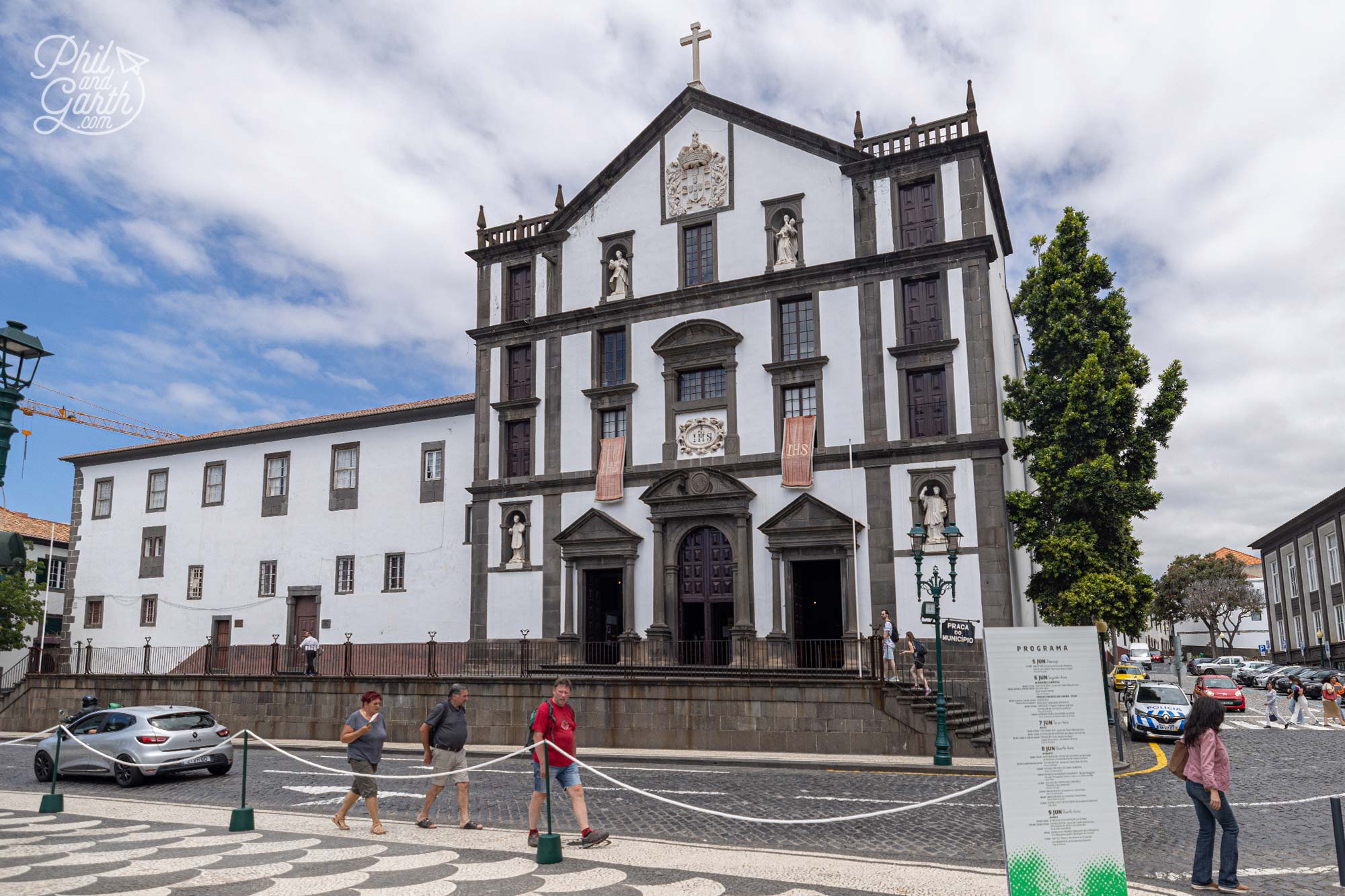
Igreja do Colégio church, Funchal
If you fancy trying the best ‘Pastel de nata’ – Portugal’s signature crispy and gooey custard tart treat (which Garth loves!) the best place to buy one is from Fábrica Santo Antonio. We loved this bakery and bought some biscuits and a tin as a souvenir to take home.
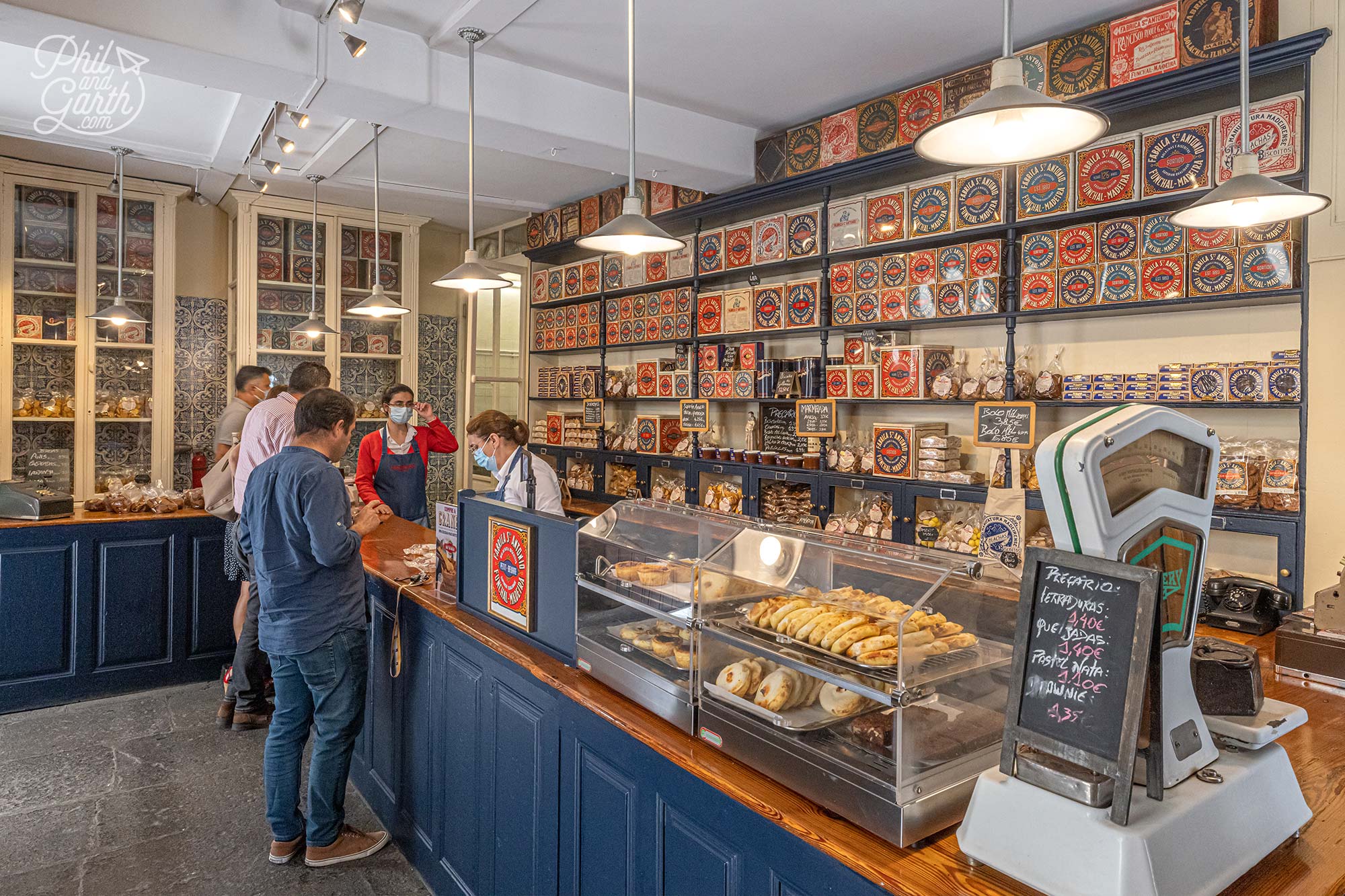
Fábrica Santo Antonio bakery for sweet treats – we loved this place!
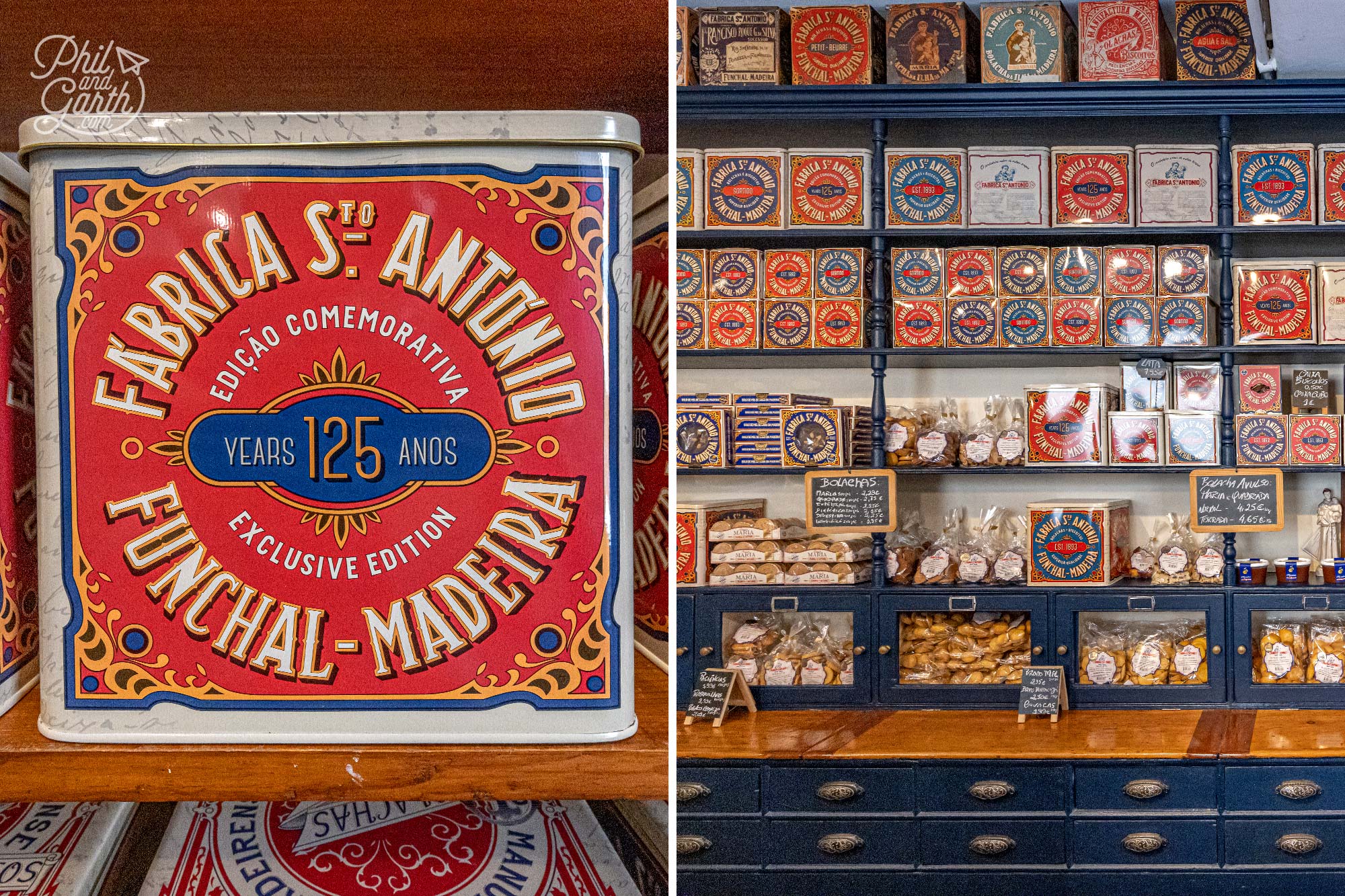
The designs of their biscuit tins are lovely
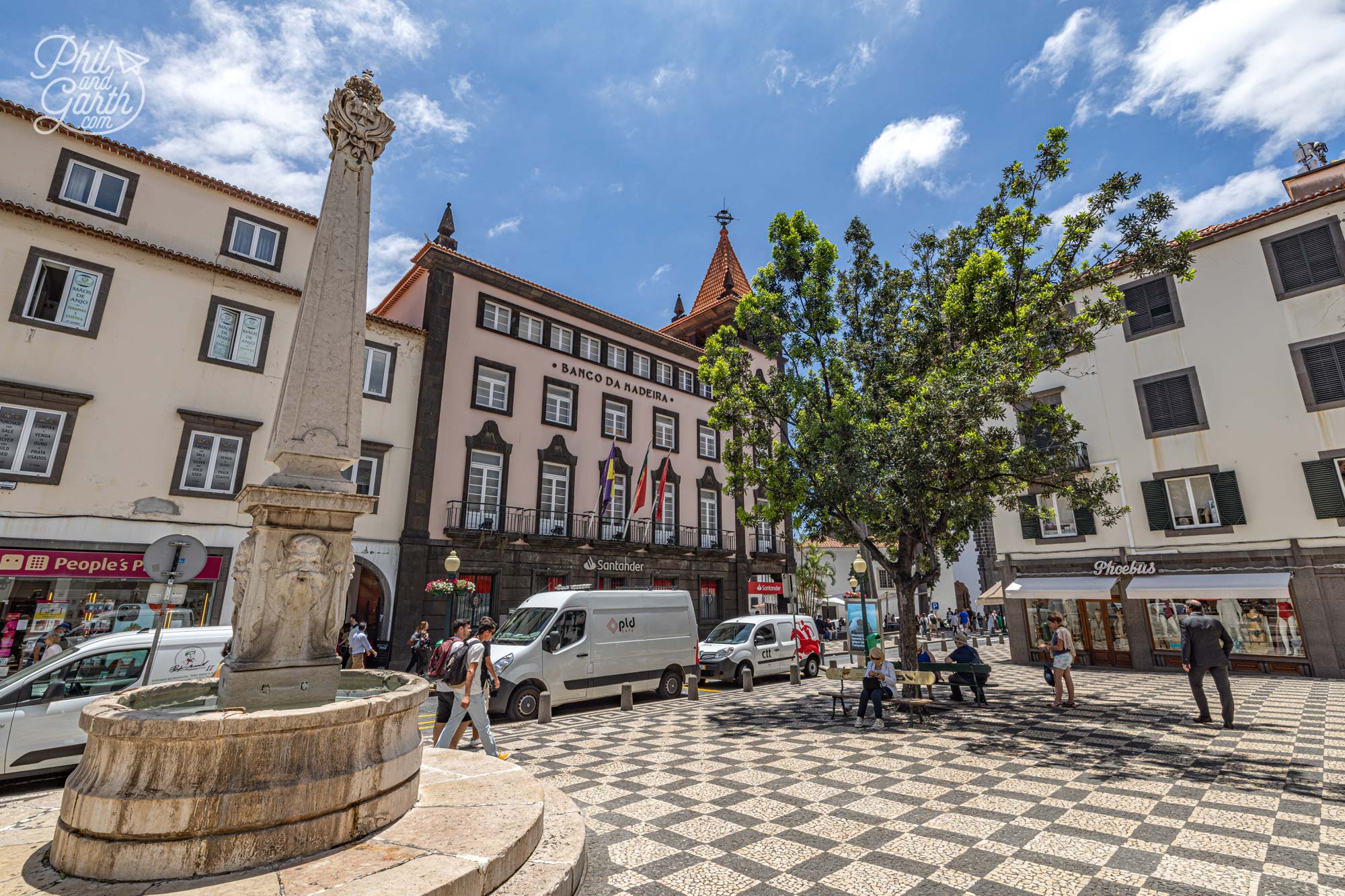
Loads of shopping opportunities Funchal
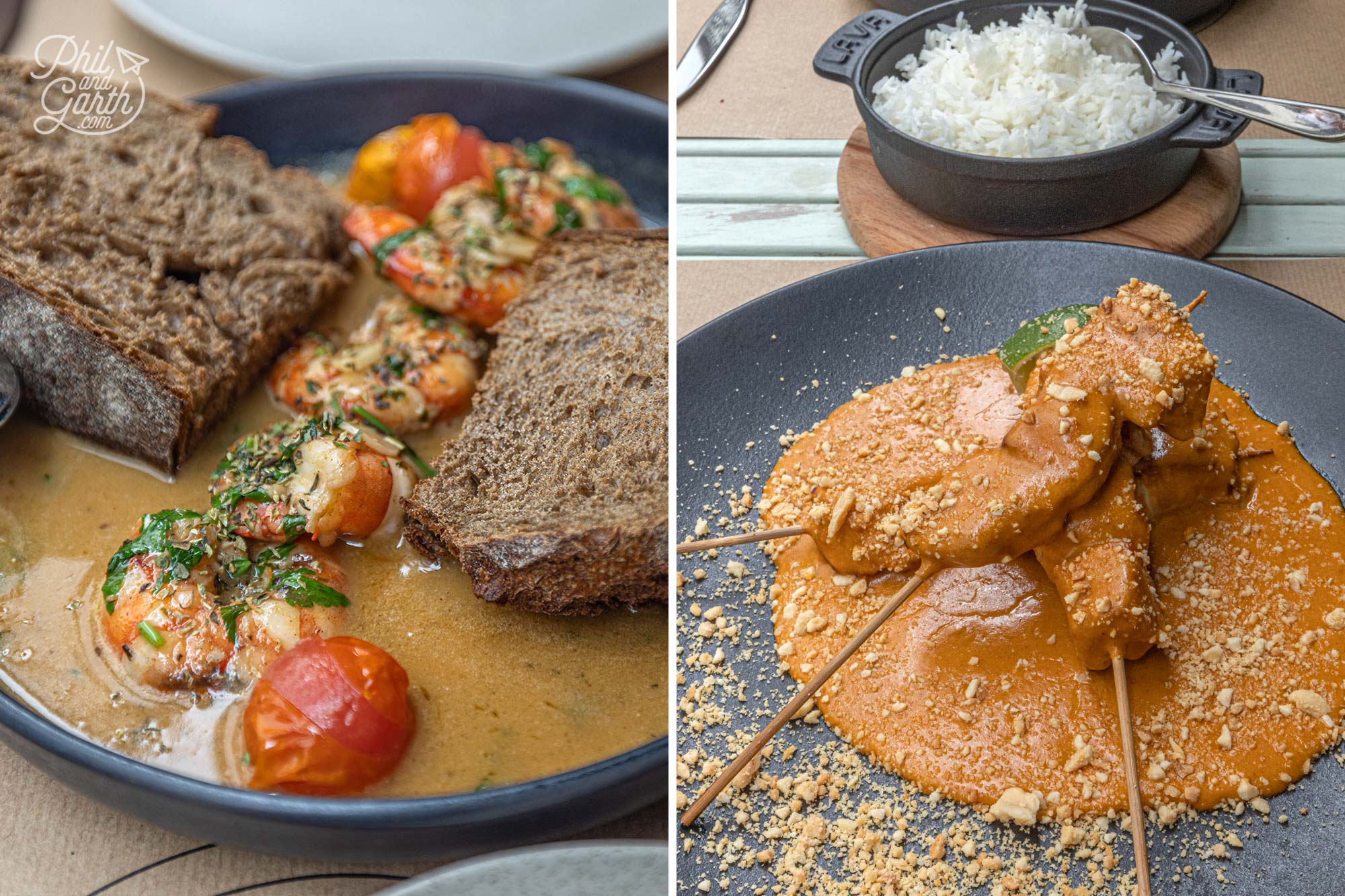
We discovered an exceptional restaurant called Terra
2. Painted Doors Street Art of Rua De Santa Maria
In the middle of the Old Town is a collection of street art called the “Painted Doors Project”. Running down Funchal’s oldest cobblestone street, Rua Santa Maria are over 200 brightly painted doors. Local artists have brought back to life disused doorways and turned them into colourful works of art. Garth loves street art and was expecting something a little bit special as we saw in Wynwood, Miami. Here the street art is more naive and simple but there are a handful of stand-out pieces. Check out the Painted Doors Project website for more information.
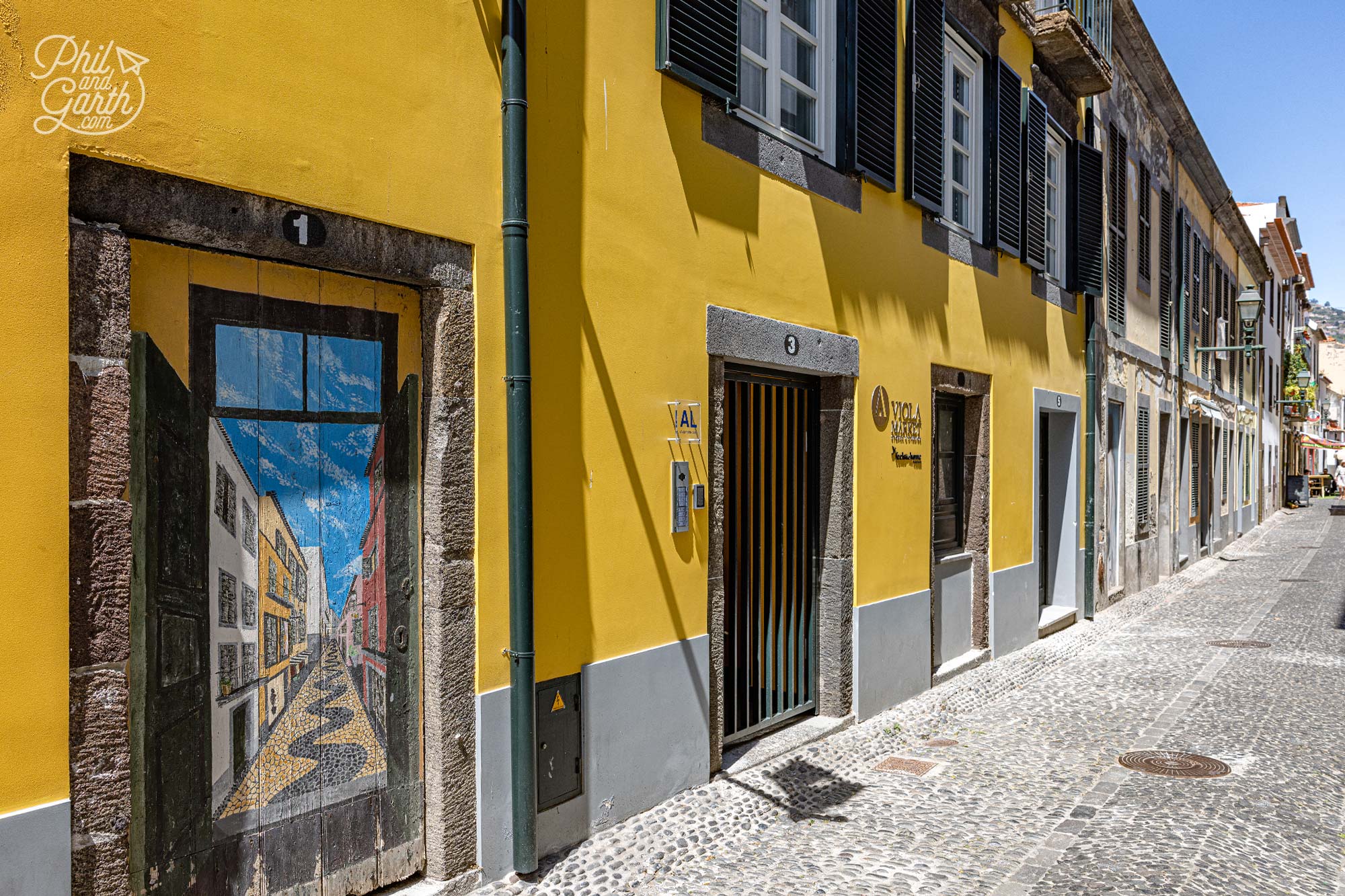
200 painted doors line the streets of Rua Santa Maria
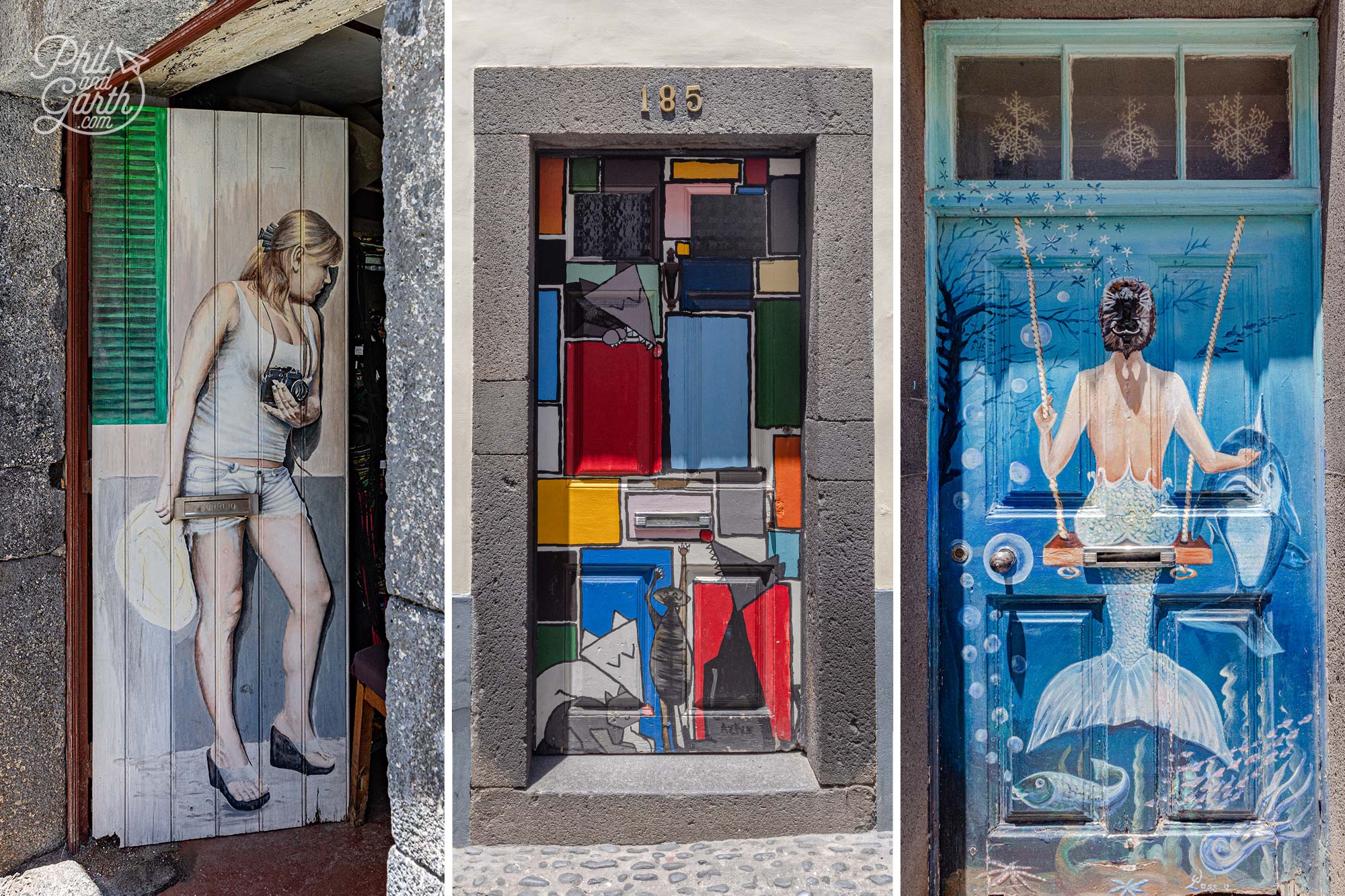
The painted doors project began in 2010
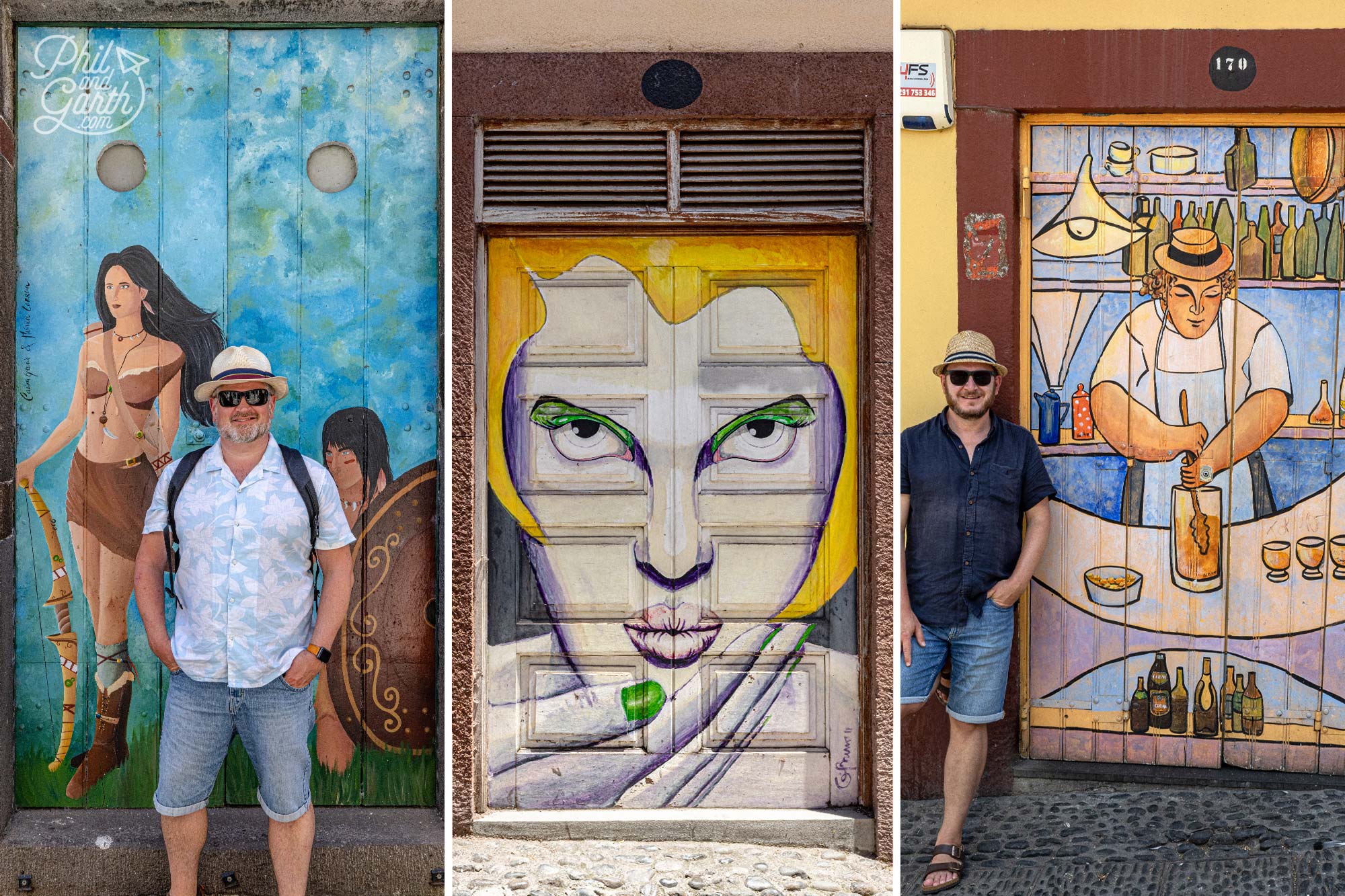
So many old doorways turned into colourful works of art
This street is packed with restaurants and bars, so expect lots of restaurant staff to try to entice you in, but a simple “no thank you” works. Apparently, this area can get congested with tourists when cruise ships are berthed. We stopped for lunch at the Madeira Story Centre and ate traditional skewered chicken called Espetada, the portions here are enormous! They also have rooftop seating if you don’t fancy sitting on the busy street, but we enjoyed all the people-watching.
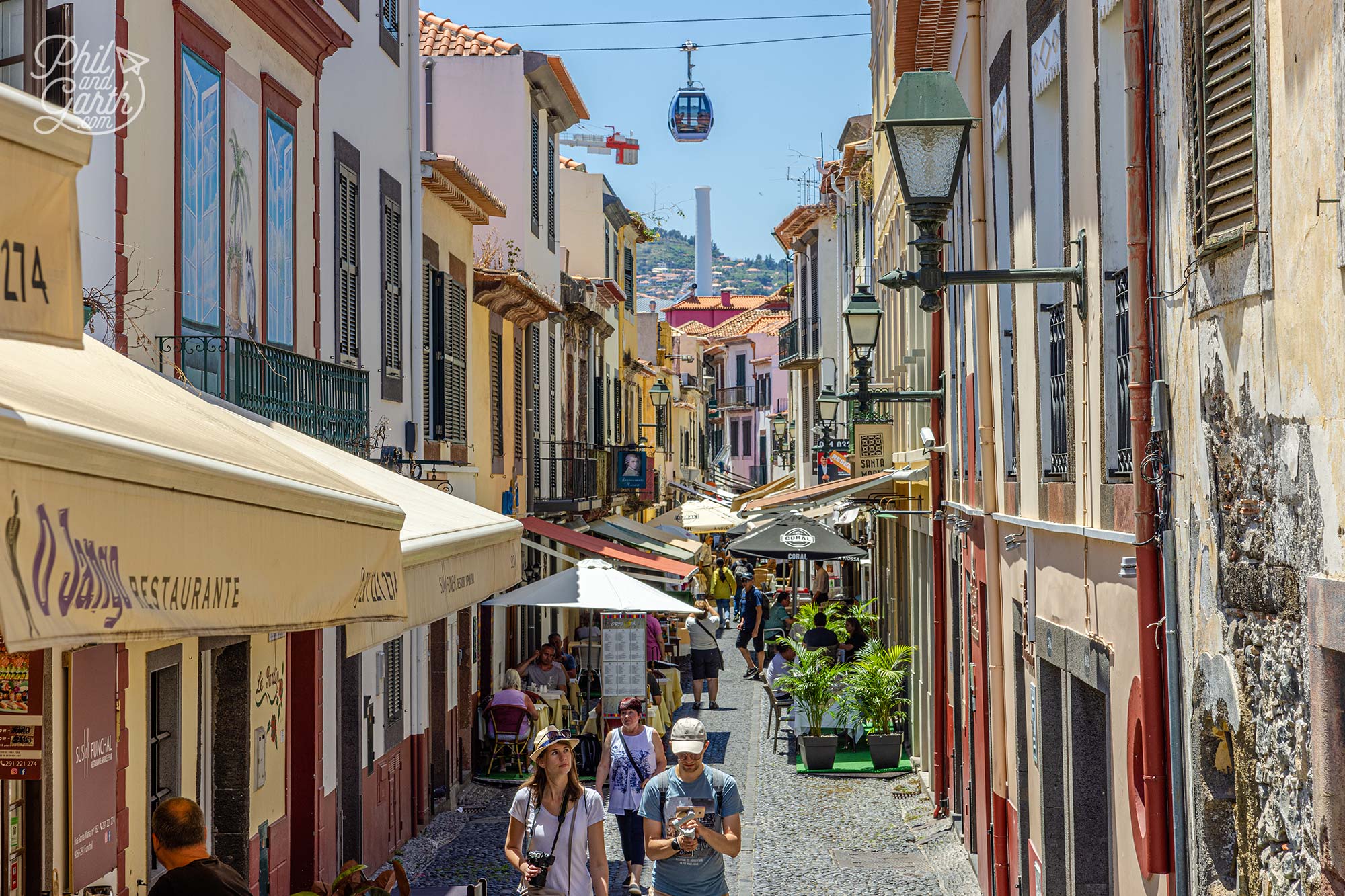
Rua De Santa Maria is packed with restaurants and bars
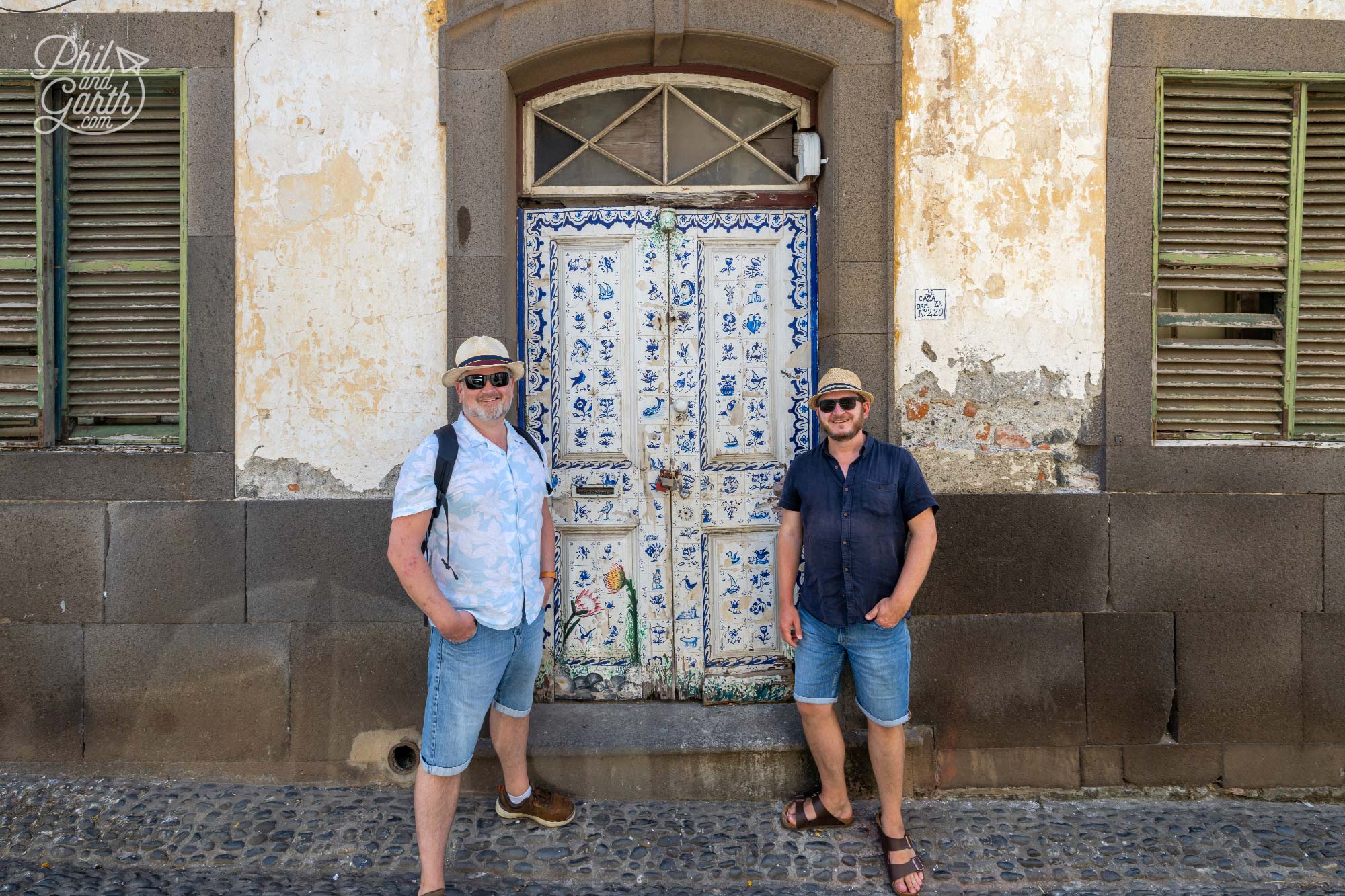
Phil and Garth on Rua Santa Maria
3. Mercado dos Lavradores – Funchal Farmer’s Market
We love visiting a market for exotic sights, sounds and smells so we checked out the locally loved farmer’s market called Mercado dos Lavradores built in 1940. Inside is a riot of colour and fragrances from the flowers, fruits and vegetable stalls. Phil noticed there are many different varieties of passion fruit for sale, the purple passion fruit is Madeira’s most grown variety on the island. Some of the vendors are quite pushy asking you to buy things or try samples of fruit and dates, however, they are polite.
The produce is beautifully presented in immaculate displays, which are great for photos! and reminded us of the perfect displays of fruit in Goa, India. Check out the huge panels of ‘azulejos‘ tiles that decorate the entrance.
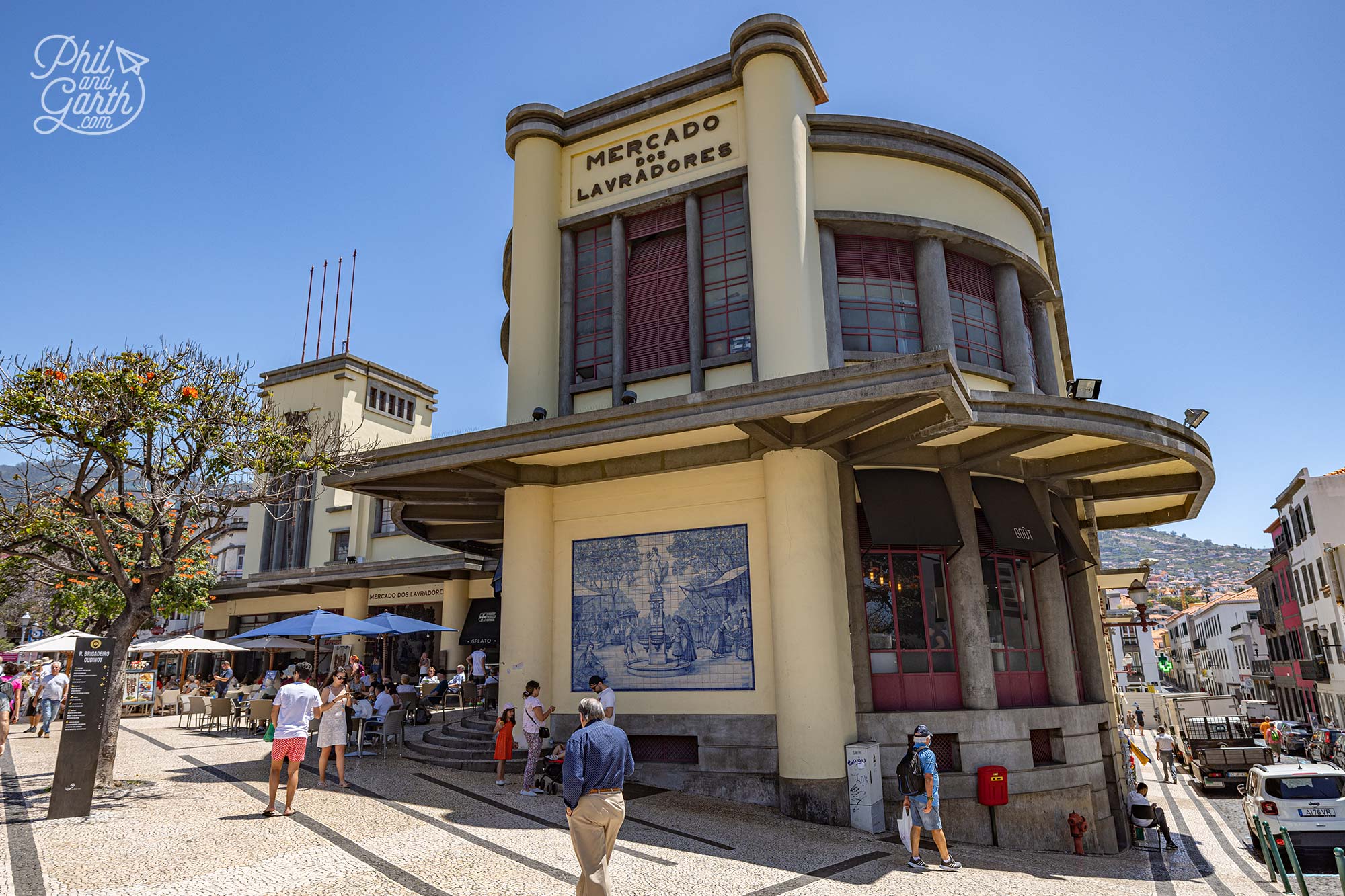
This grand Art Deco building was built in 1940 intended as the base for the city’s supply of goods
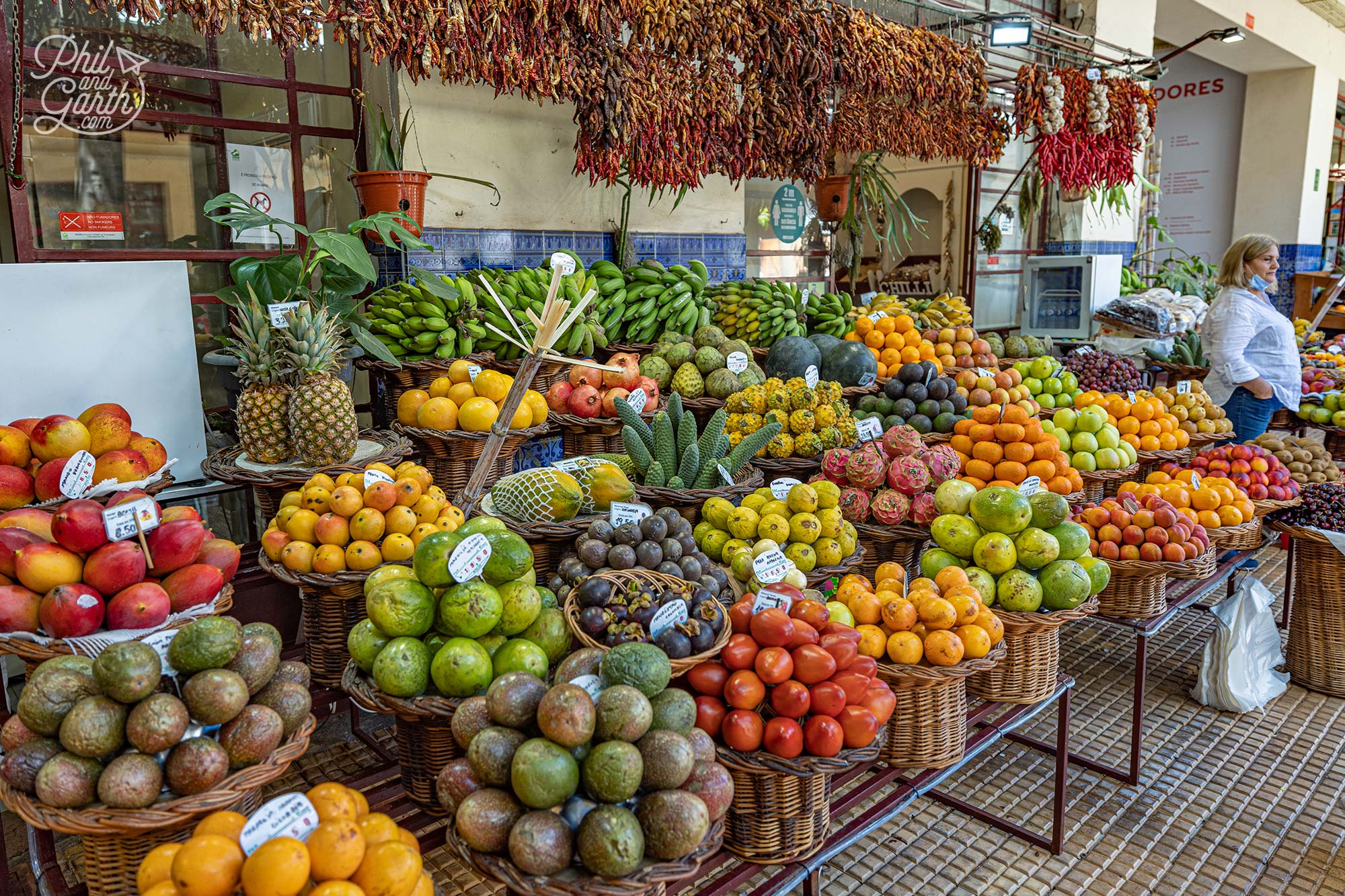
The colours, sounds and smells are great inside Mercado dos Lavradores
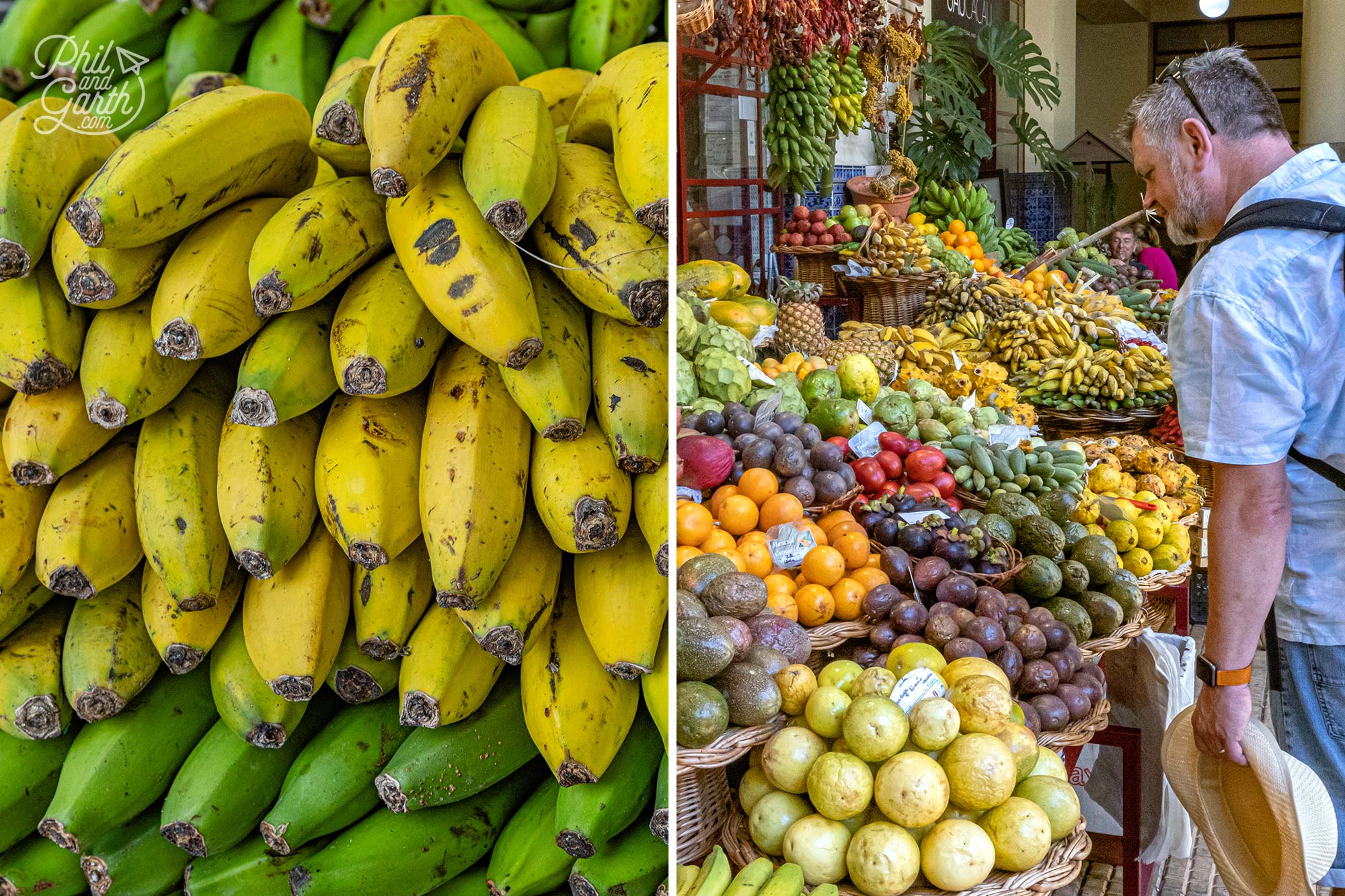
There’s lots of varieties of passion fruit grown on Madeira, purple passion fruit is most associated with the island
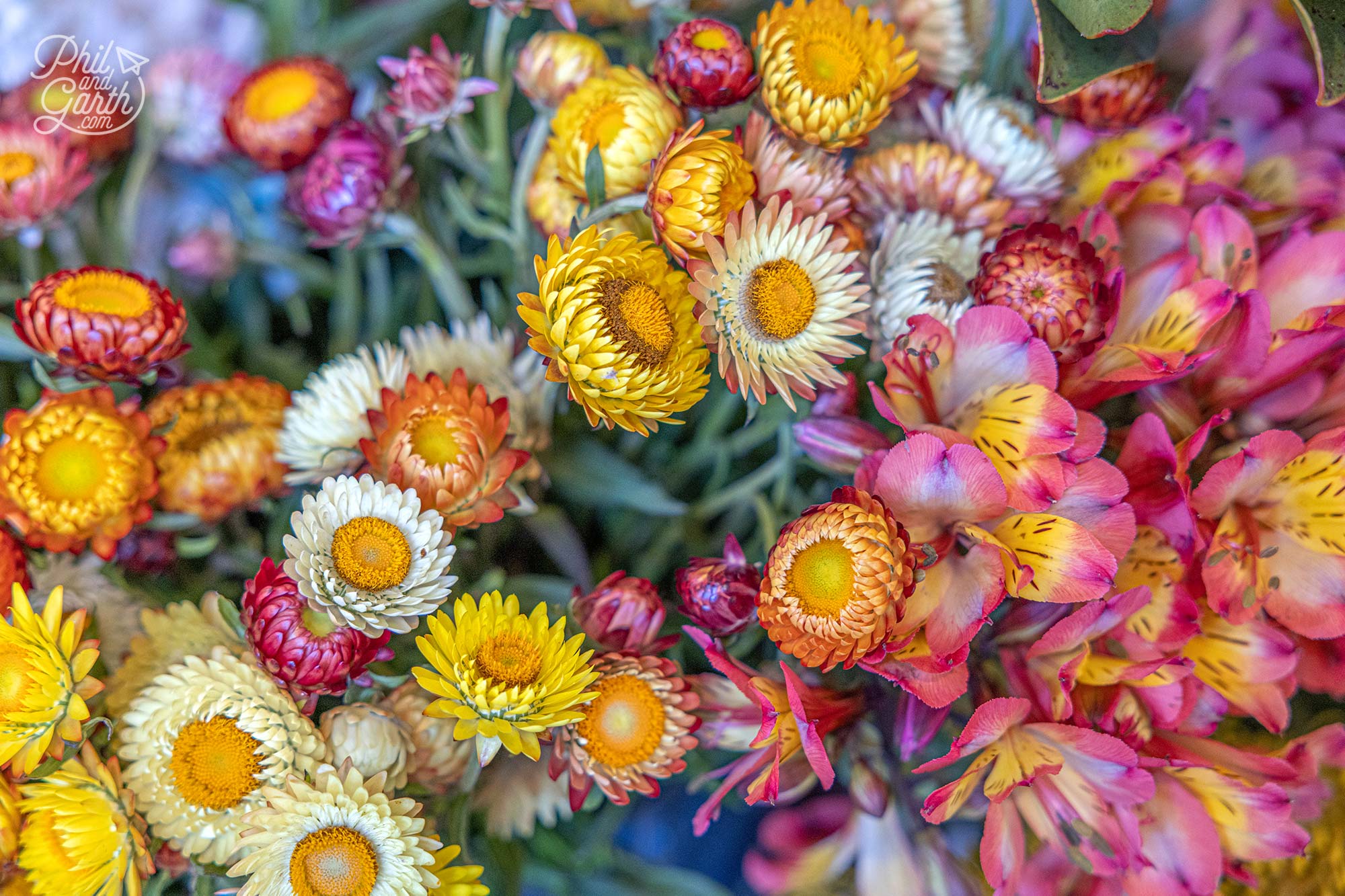
Colourful blooms of flowers for sale
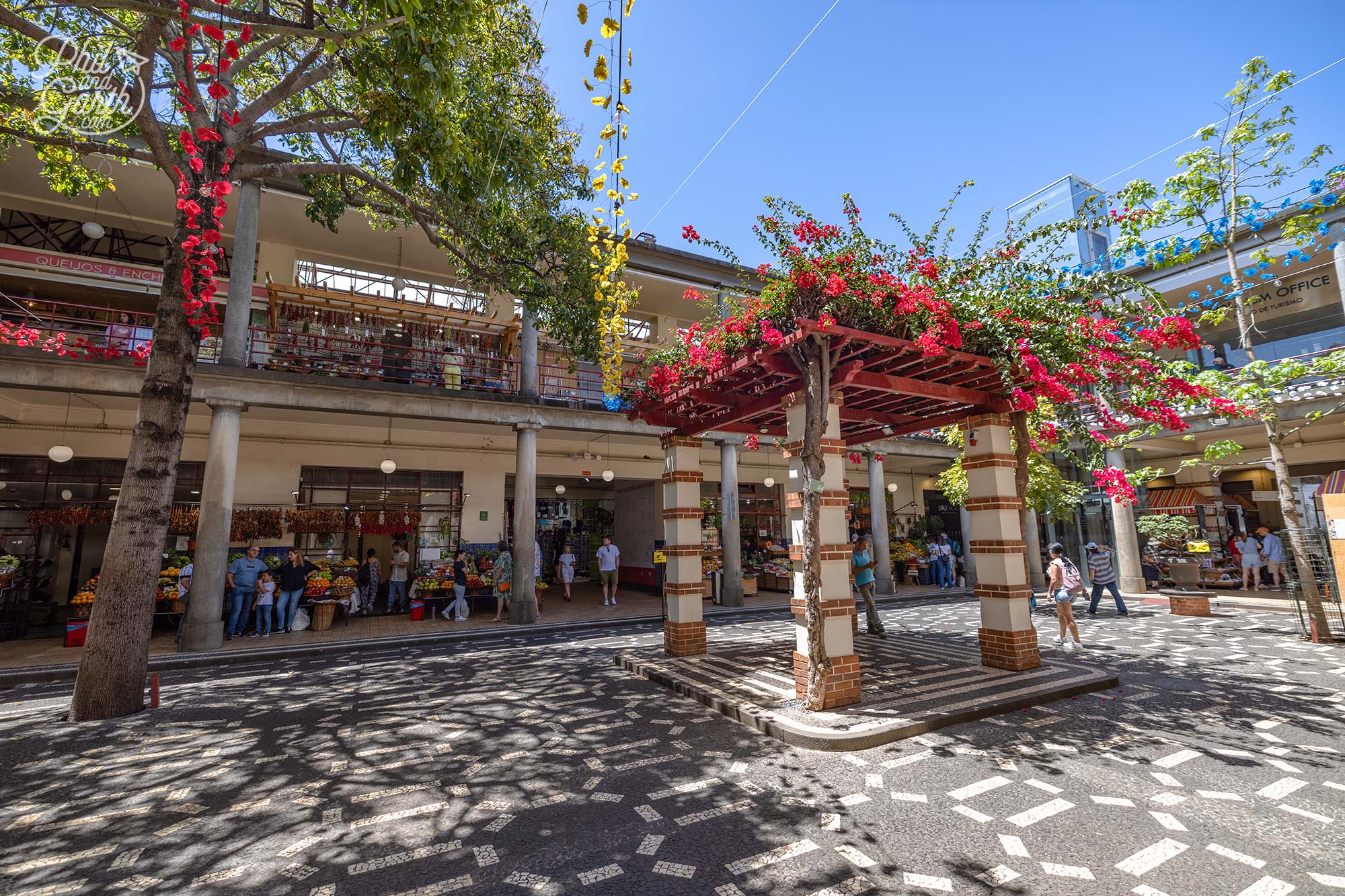
Across 2 floors, the market also sells local crafts and gifts
Whilst you’re here be sure to visit the pongy fishmonger and take a look at the local black scabbard fish called espetada. They are so ugly with huge eyes!
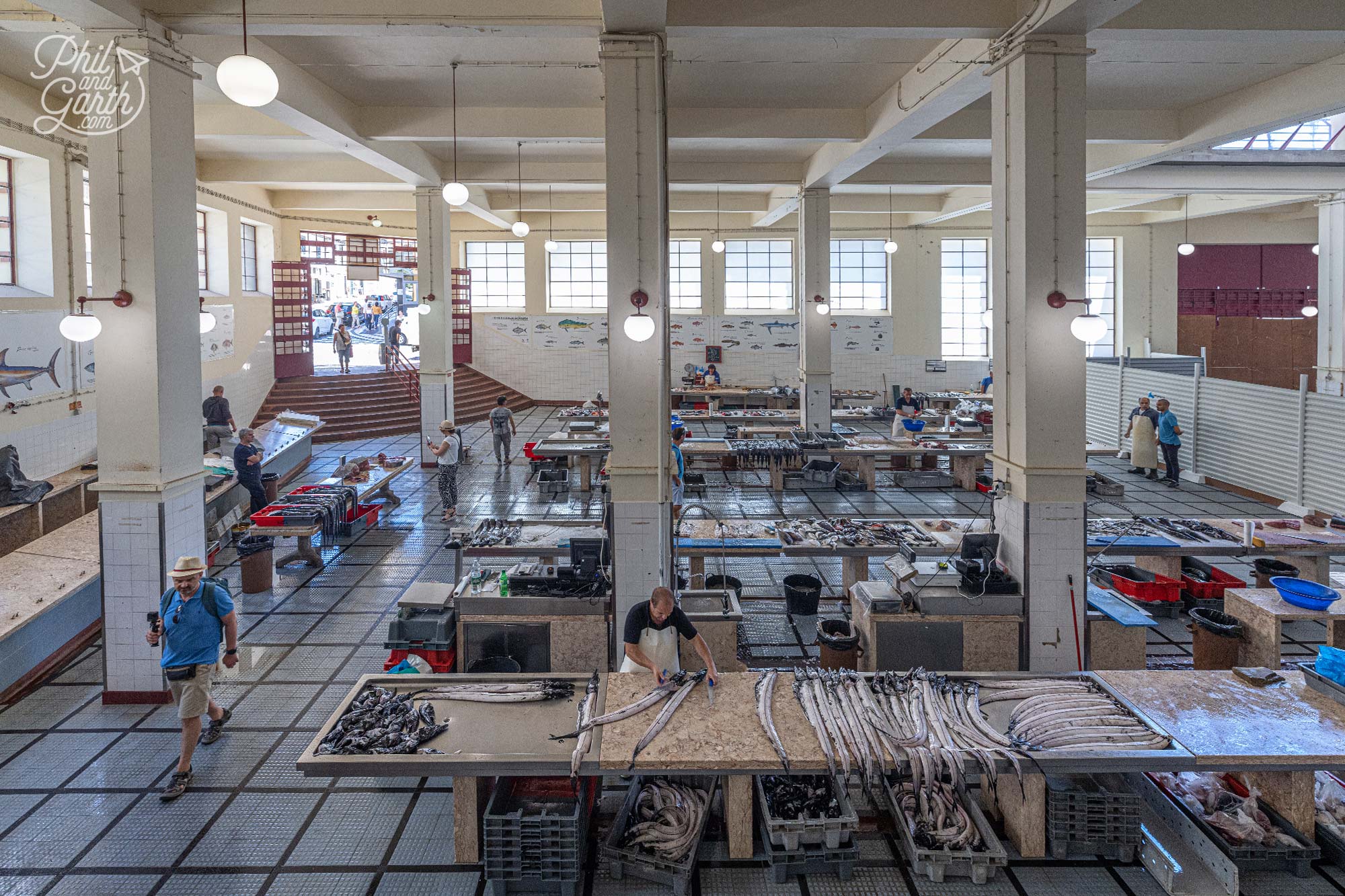
The fish market at Mercado dos Lavradores
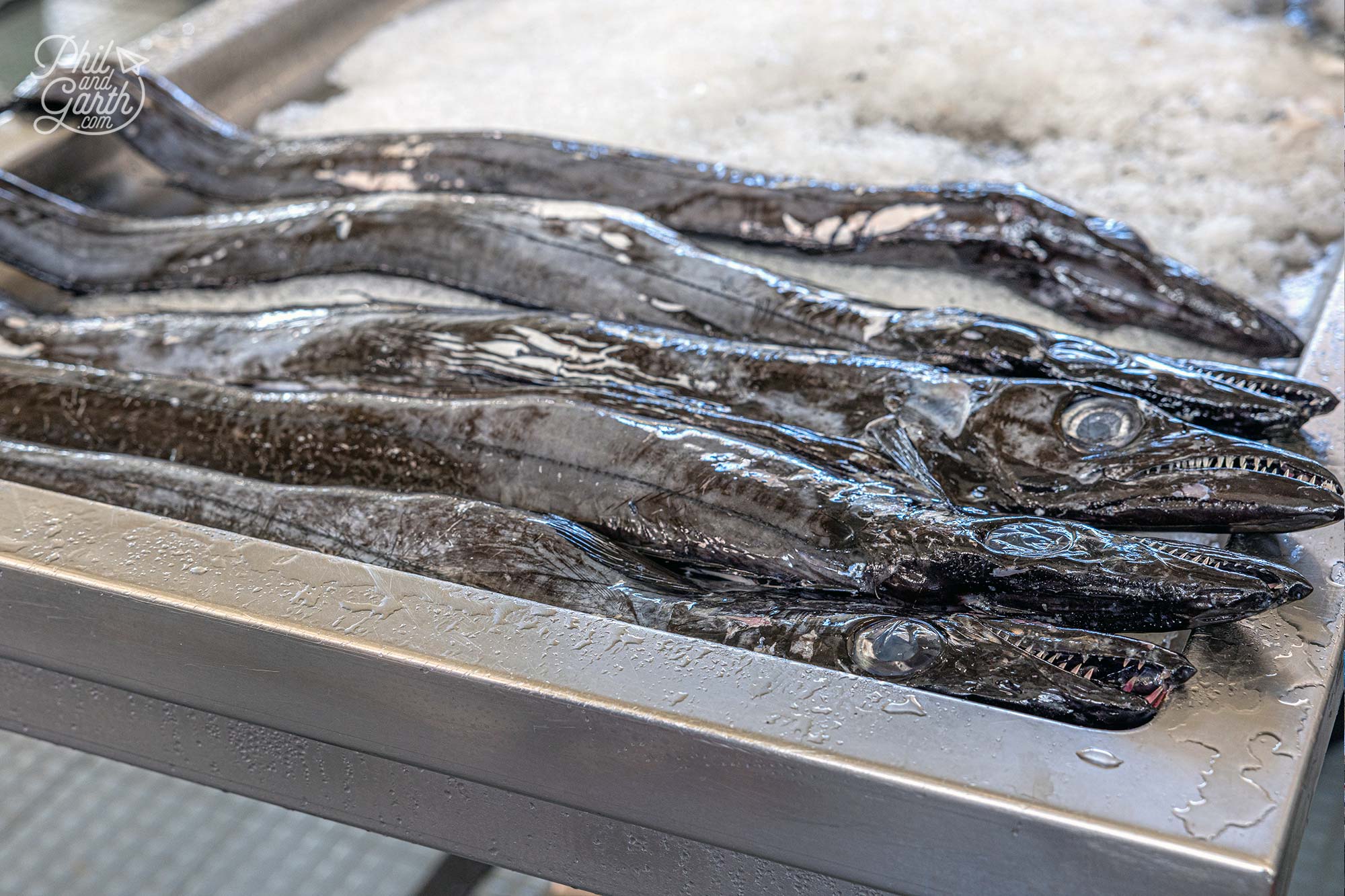
Espetada – the local black scabbard fish
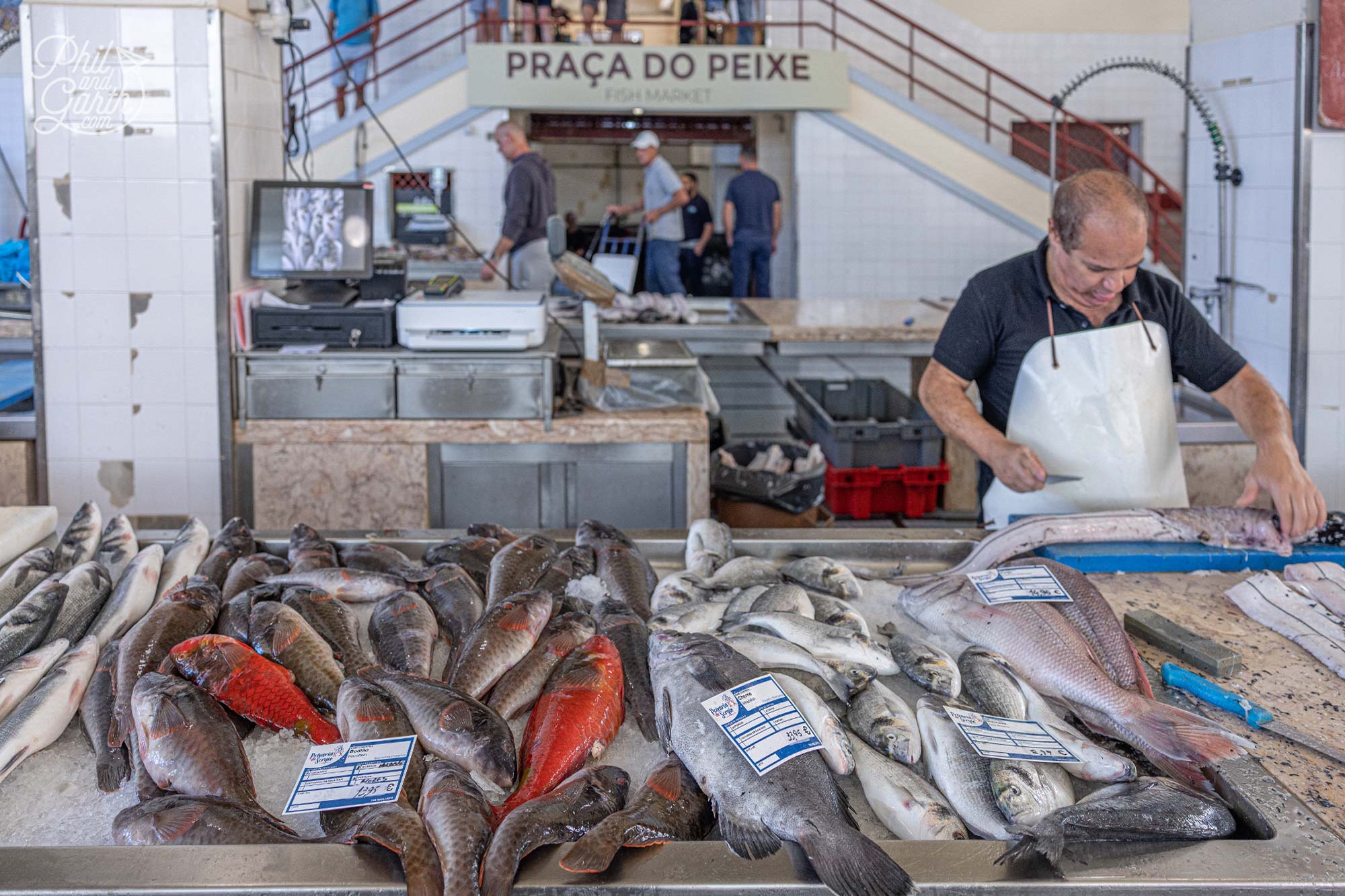
A fishmonger hard at work
Even if you don’t want to buy anything it’s a great place for a wander and a spot of people watching. We headed up the stairs to the nice rooftop terrace bar and relaxed with some local beers and wine before exploring more of Funchal. Mercado dos Lavradores is open Monday to Saturday and closed on Sundays and holidays. The best day to visit is Friday when the flower ladies wear traditional dresses.
4. Monte Cable Car Ride
From Funchal’s old town we caught Funchal’s cable car to get to the hilltop neighbourhood of Monte to see Madeira’s famous tropical gardens. The first cable car ride from the seafront promenade takes 15 minutes and offers fabulous 360-degree birds-eye views of Funchal. It’s an exciting way to see Funchal and the spectacular scenery and beauty of the lush hillside. Phil liked the glimpses into people’s gardens and Garth enjoyed spotting small banana plantations on the way up.
Each cable car seats 8 people, a one way adult ticket costs €12.50 to reach Monte. Expect lengthy queues when a cruise ship is docked. There is a second cable car that takes you to the Botanical Garden, more on that later.
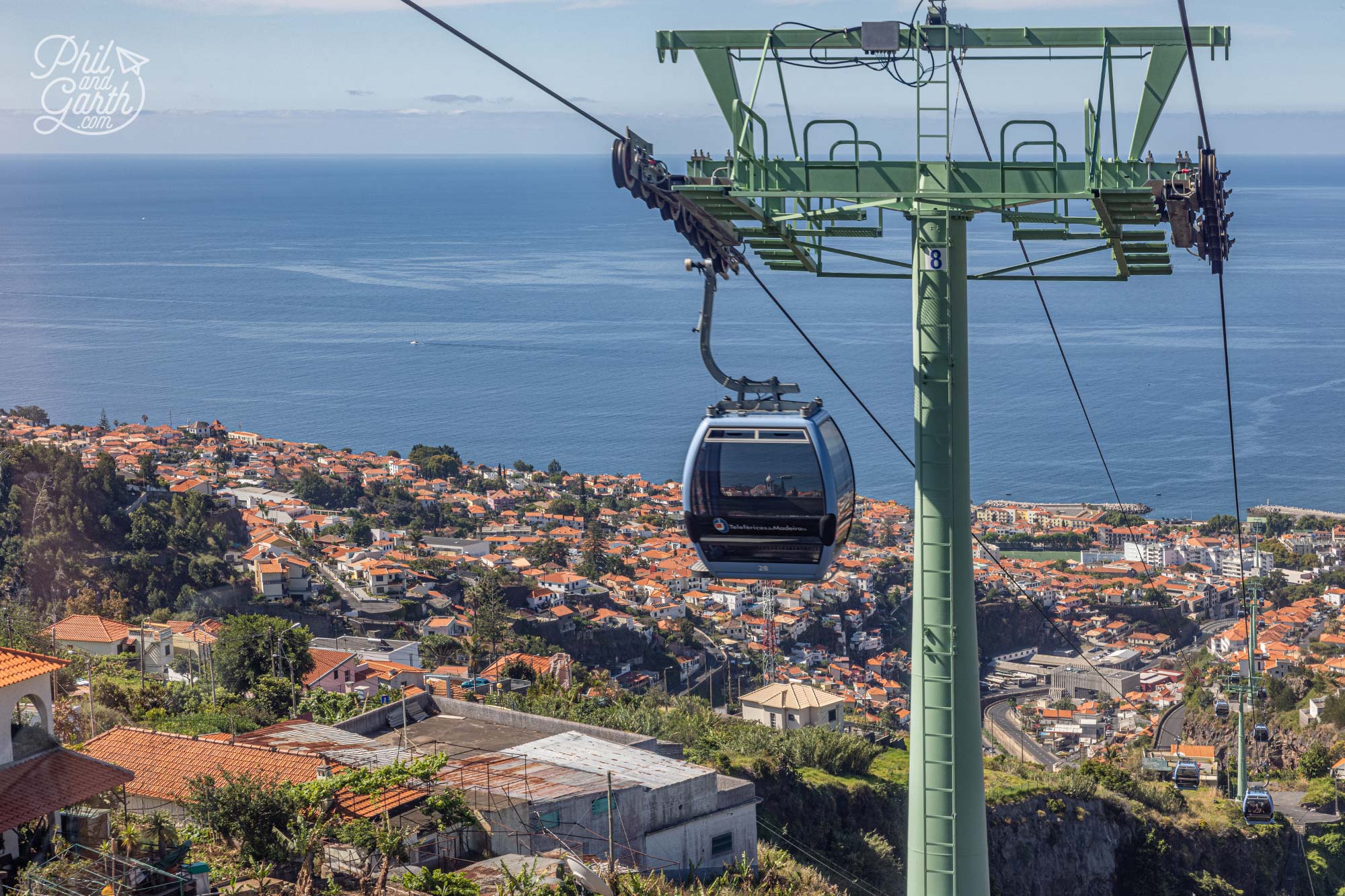
Funchal’s cable car ride takes you to the hilltop neighbourhood of Monte
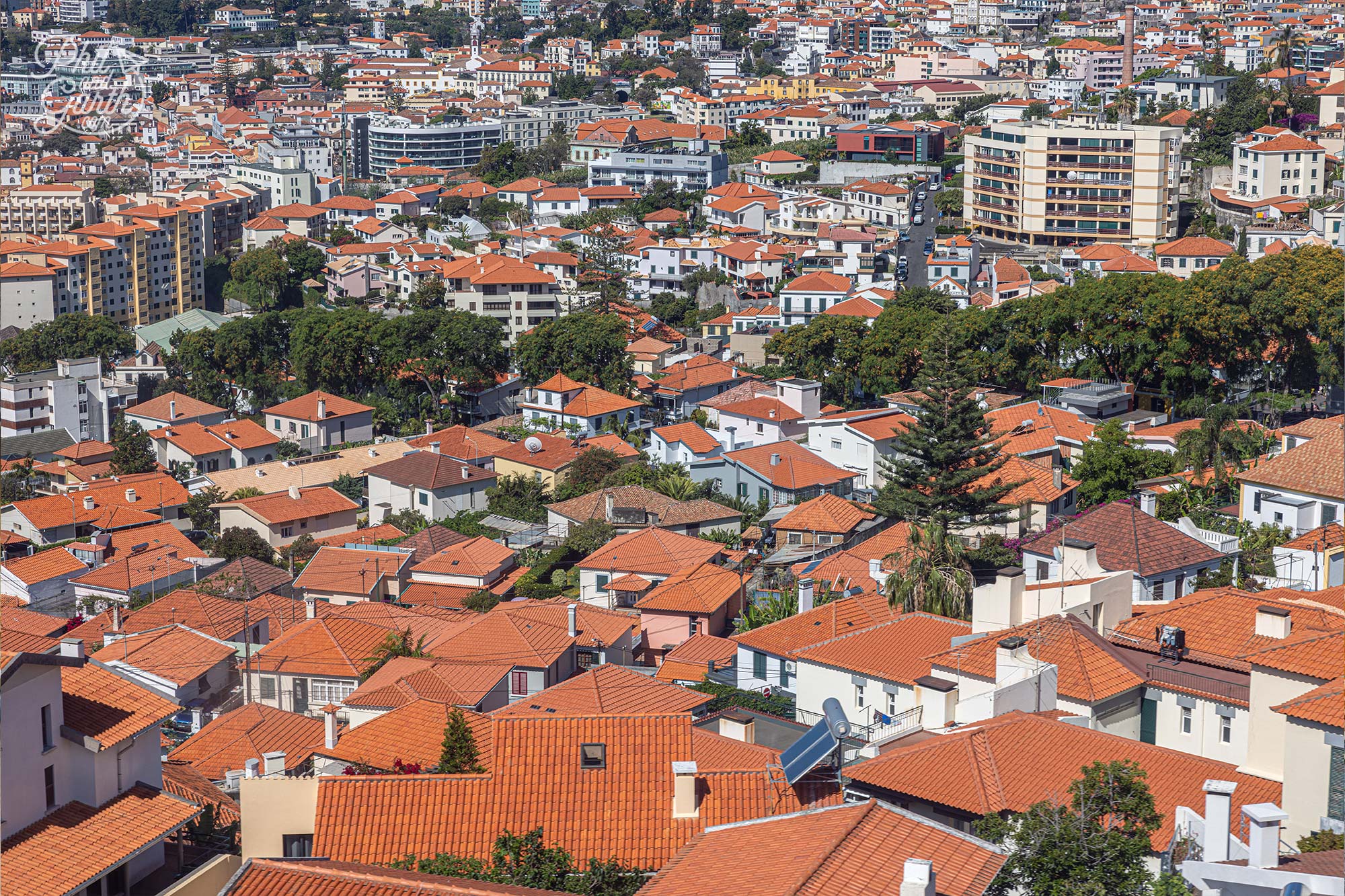
Gliding 600 metres above sea, level above so many traditional orange rooftops
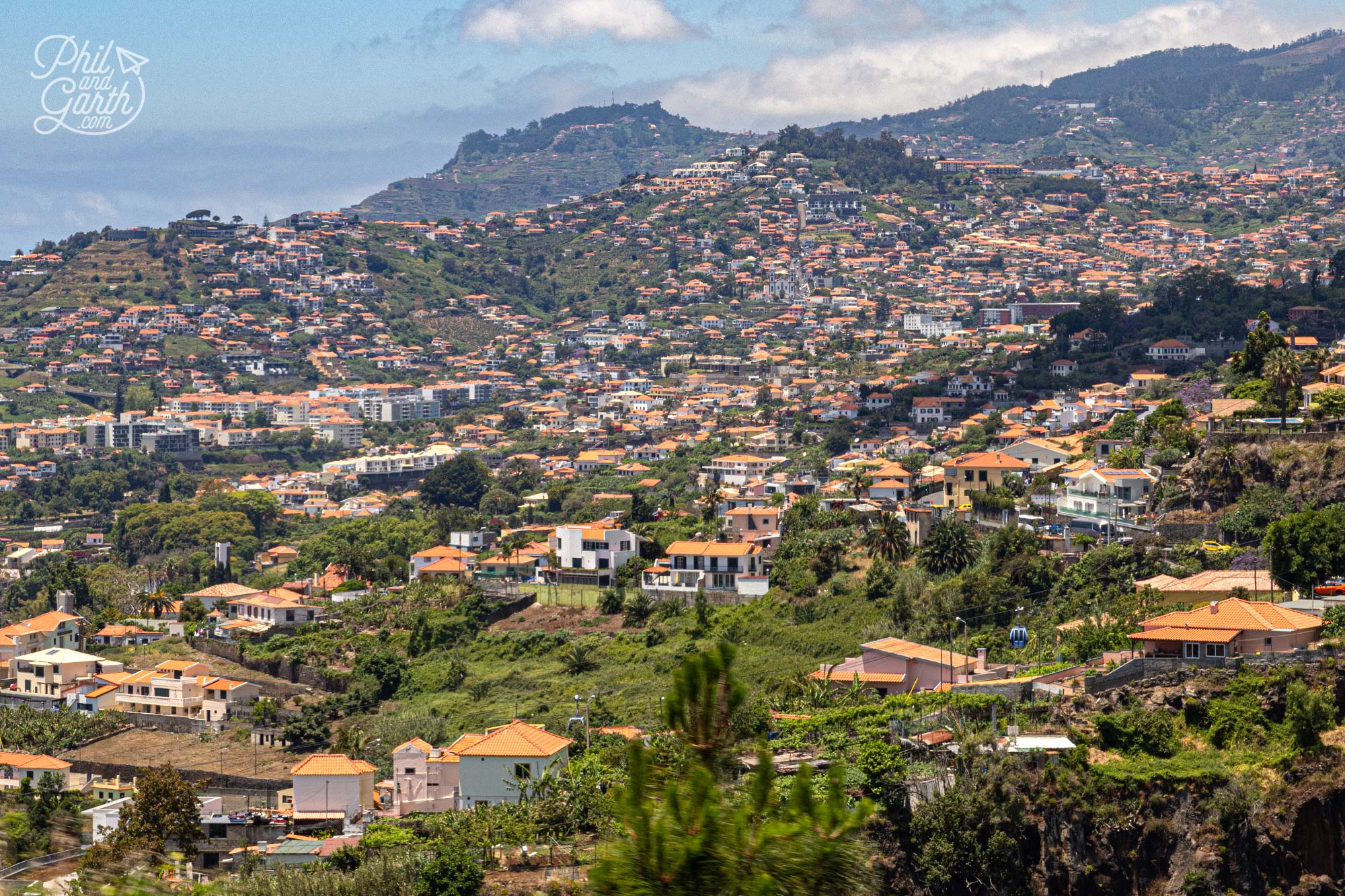
Amazing views of Funchal’s lush green landscape
5. Monte Palace Tropical Gardens
The cable car from Funchal drops you right outside the Monte Palace Tropical Gardens which is one of the most unique places to visit in Funchal. It dates back to the 18th century when it used to be a luxury hotel. Entrepreneur José Berardo transformed the grounds into tropical gardens with art installations and a museum which opened to the public in 1991. We loved wandering around here, the gardens feature over 100,000 species of exotic plants, flowers and huge soaring trees.
There are 3 different walking routes – the flower walk, art walk and a combined walk. Our favourite part were the two Oriental Gardens inspired by the far east style of Chinese and Japanese gardens. Garth enjoyed photographing the red tori gates and koi carp ponds.
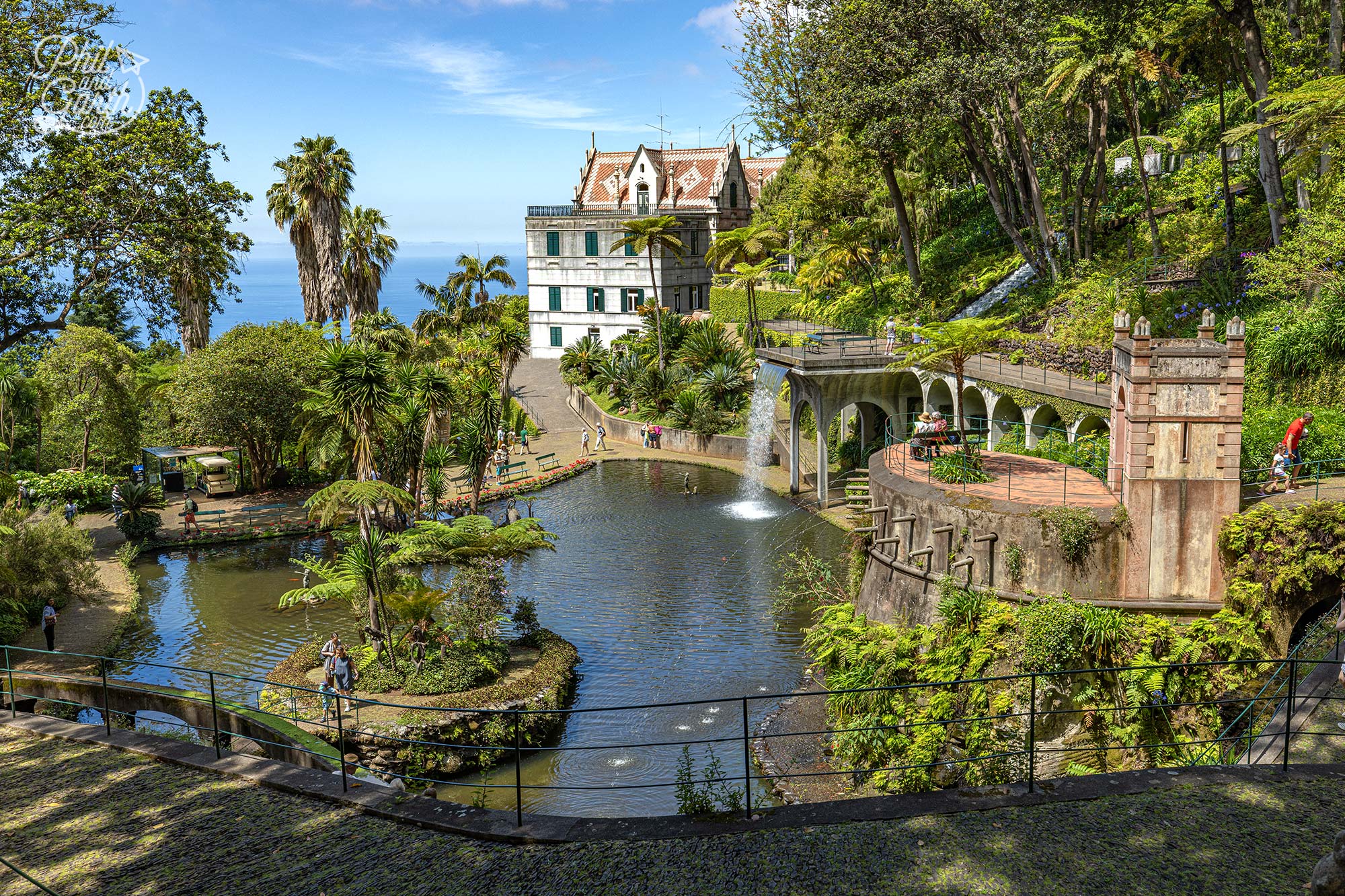
The central lake at Monte Palace Tropical Gardens
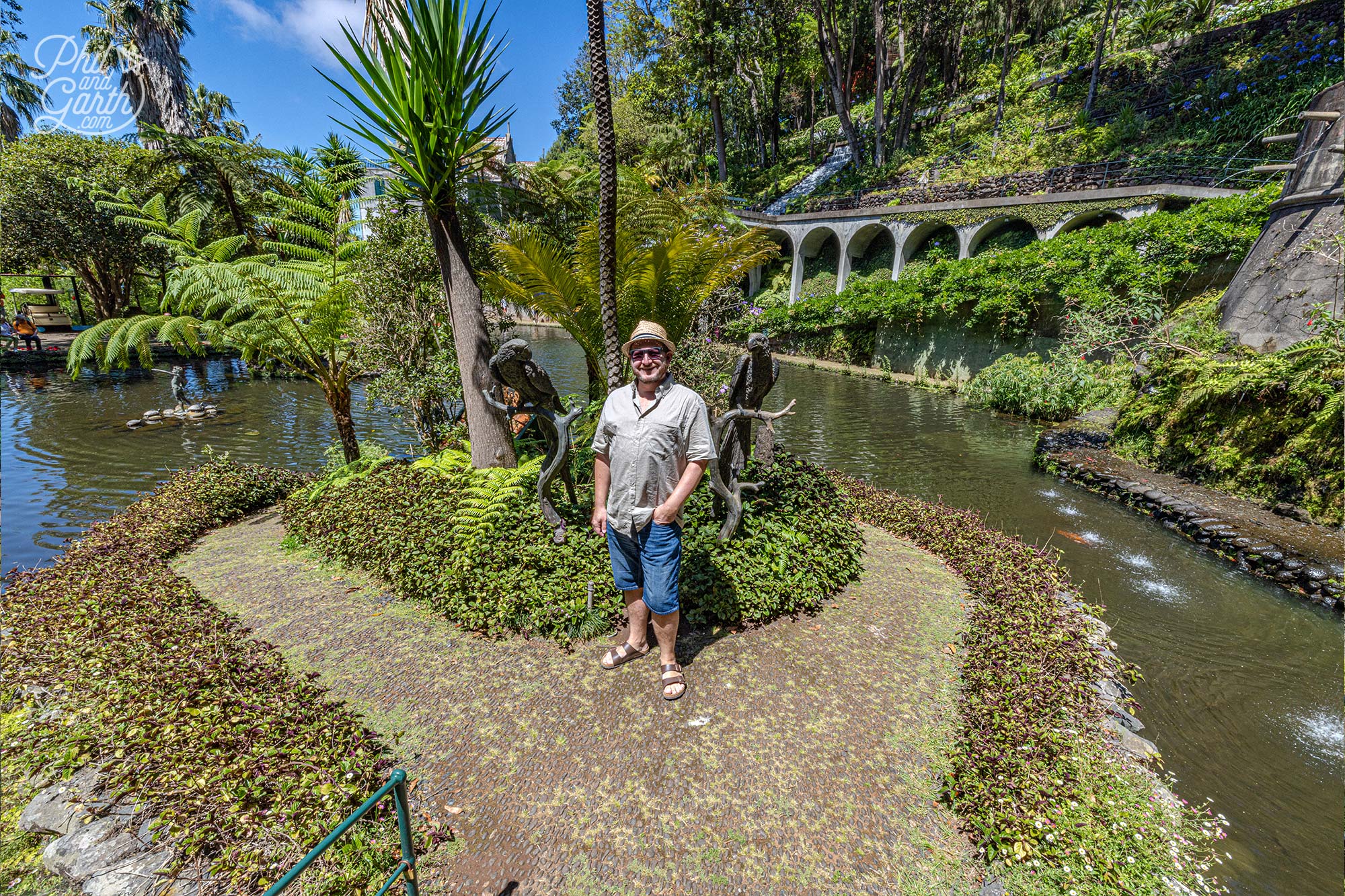
Garth on the island at the central lake
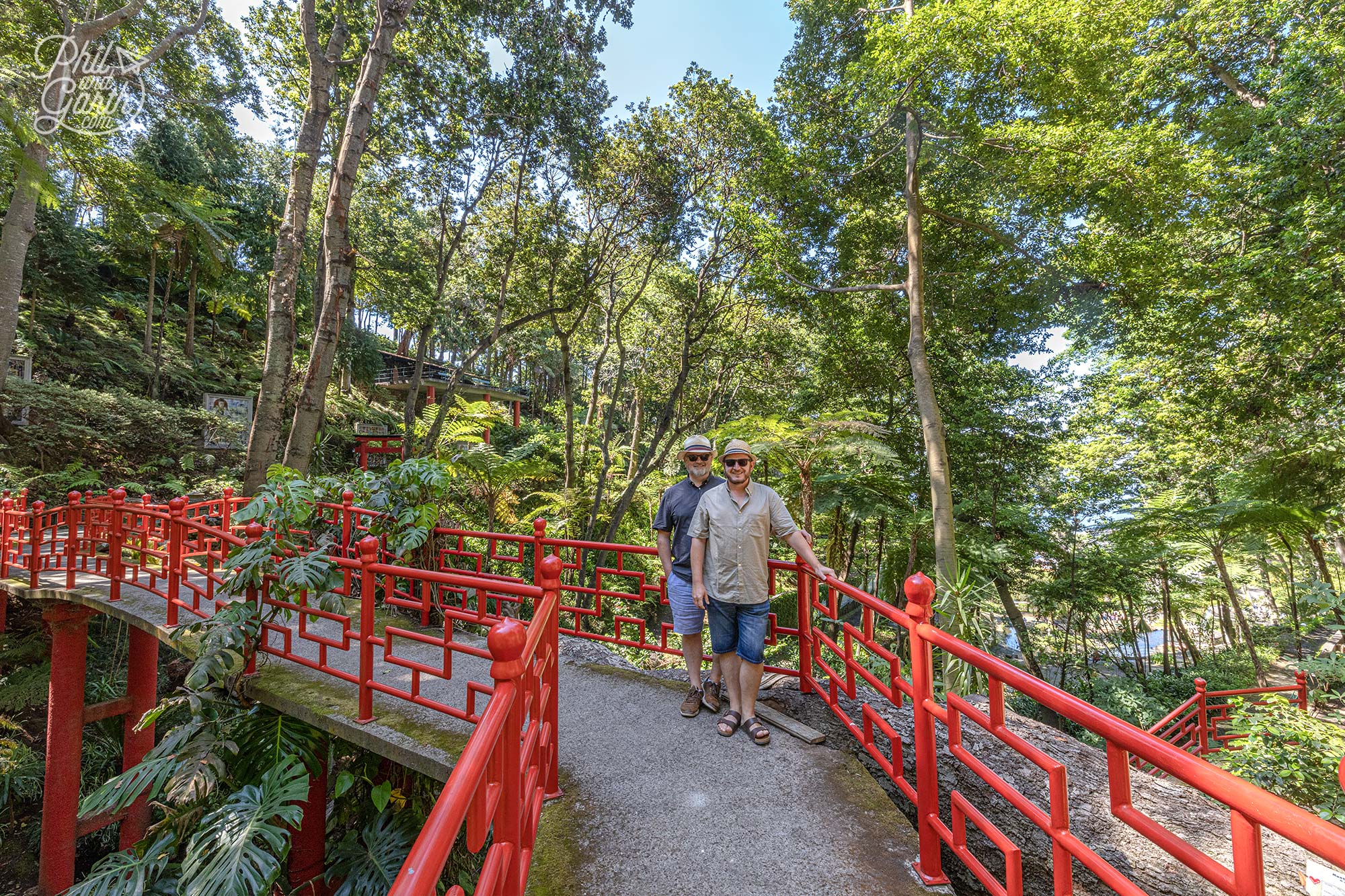
Phil and Garth in the Oriental Garden
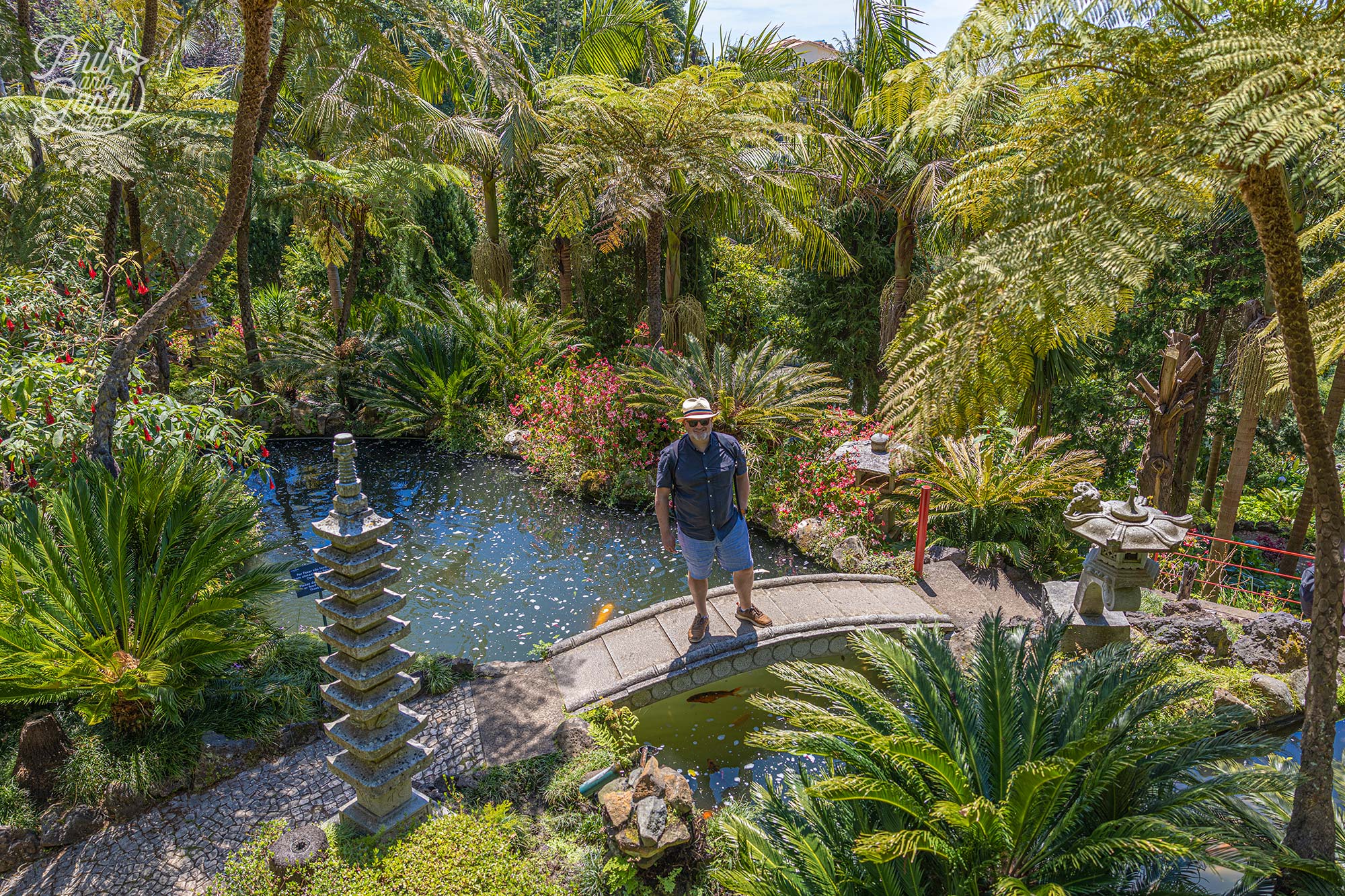
Phil in the Oriental Garden
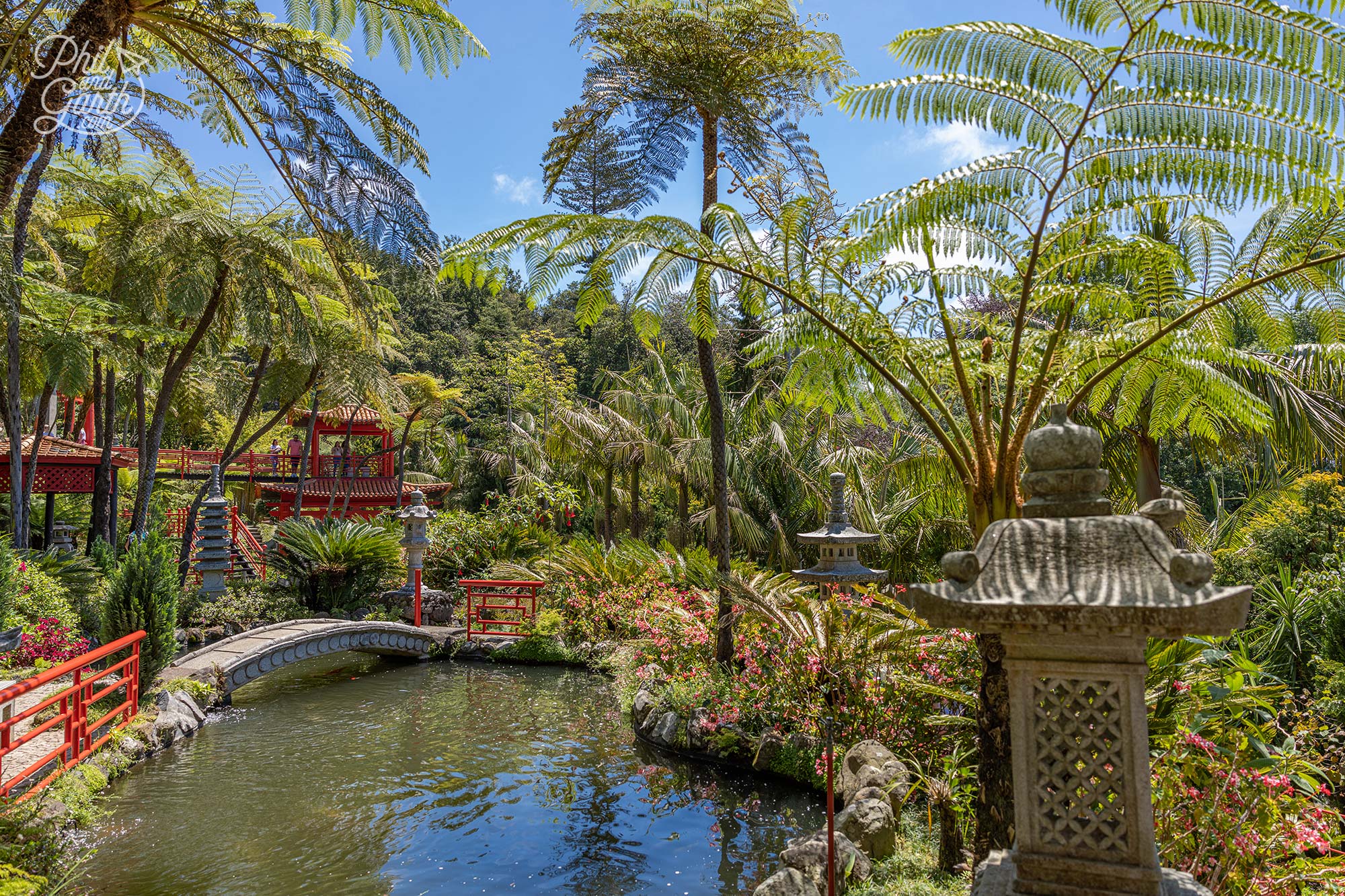
The fabulous Oriental Garden
The gardens also have 2 replicas of Madeira’s traditional ‘Santana’ triangular thatched roof houses. Apparently, lots of people propose here because of the stunning setting. We thought the central lake is more picturesque.
There are all sorts of artworks, we enjoyed walking along the pathways past the blue Portuguese tiles called ‘azulejos’ which depict Portugal’s events from different periods of history. The Monte Palace gardens have the largest collection of tiles in Portugal from palaces, churches and private homes.
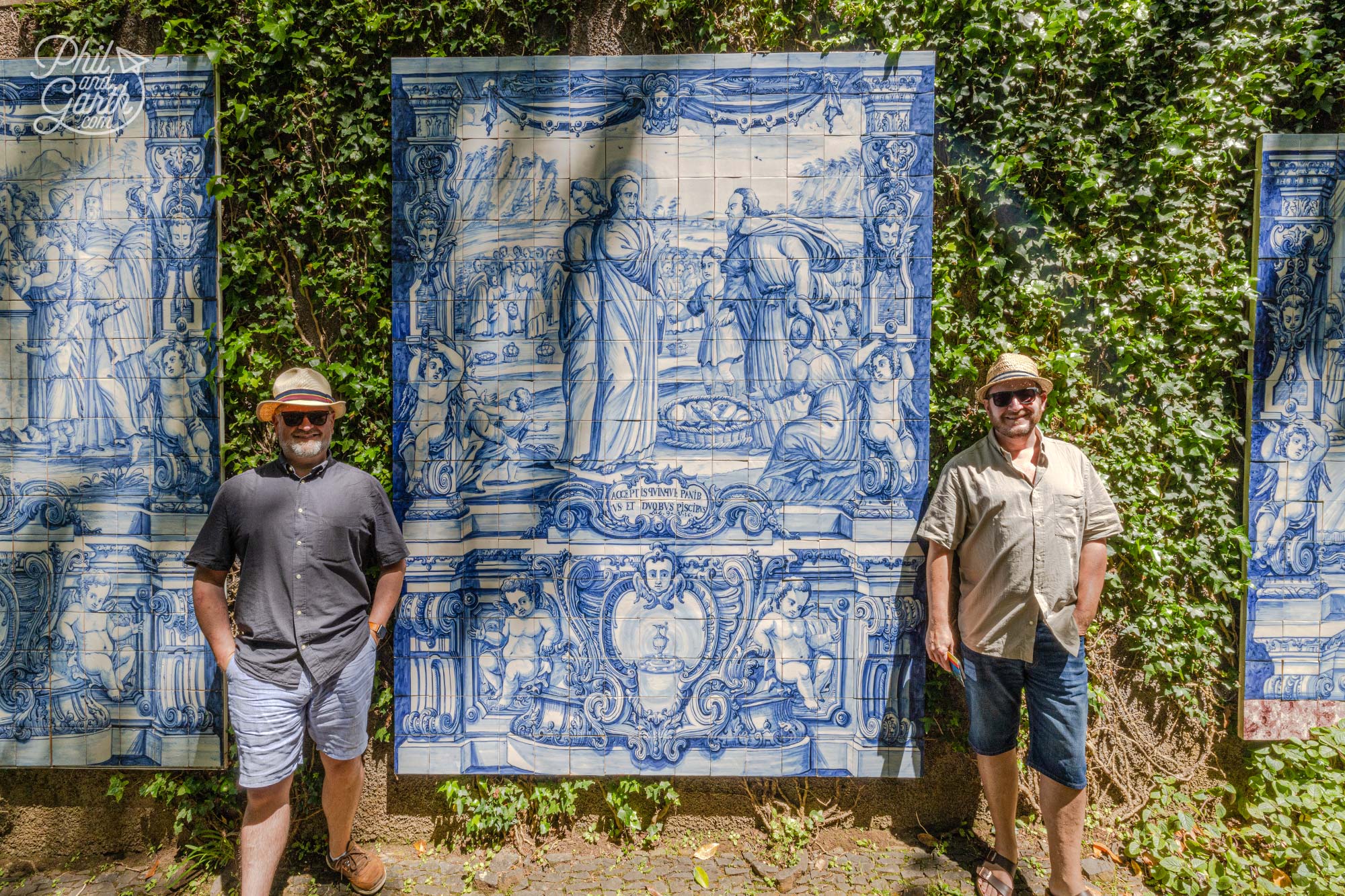
Monte Palace Gardens contains some of the best azulejo tiles in Portugal
Also within the grounds, you’ll find the Monte Palace Museum which has 2 large collections. On the upper floor is an exhibition full of Zimbabwean stone sculptures whilst the ground floor has a collection of 700 minerals from around the world. You’ll need a few hours to fully explore the Monte Palace gardens, we spent 3 hours here.
6. Madeira Botanical Garden
To get to the Madeira Botanical Garden from the Monte Palace garden simply walk back to the cable car station you got from Funchal and past it to another cable car station about 5 mins away. We took this one for a 10-minute ride up to Madeira’s more formal Botanical Garden. It dates back to 1881 and was created by the Reid family in 1960. There’s a huge variety of plants to see in 5 distinct areas of the garden:
- Indigenous & Endemic – Plants exclusive to Madeira and other Atlantic islands, like the Azores, Cape Verde and the Canary Islands.
- Succulents – Thick fleshy plants mostly from South America known for their ability to retain water in arid environments.
- Tree Garden – A collection of palms and trees from the Himalayas and the tropics.
- Medicinal & Aromatic – Plants here include sugar cane, mango, papaya, avocado and coffee plants.
- Loiro Park – For exotic and rare birds.
It’s a very peaceful place, We loved all the exotic plants, which are all labelled. Garth especially loved the geometric shapes and patterns of the clever planting created in the ‘mosaic garden’. It must take so much work to keep them looking immaculate. Phil loved the scents in the aromatic garden and the dramatic-looking cactus plants in another part of the gardens.
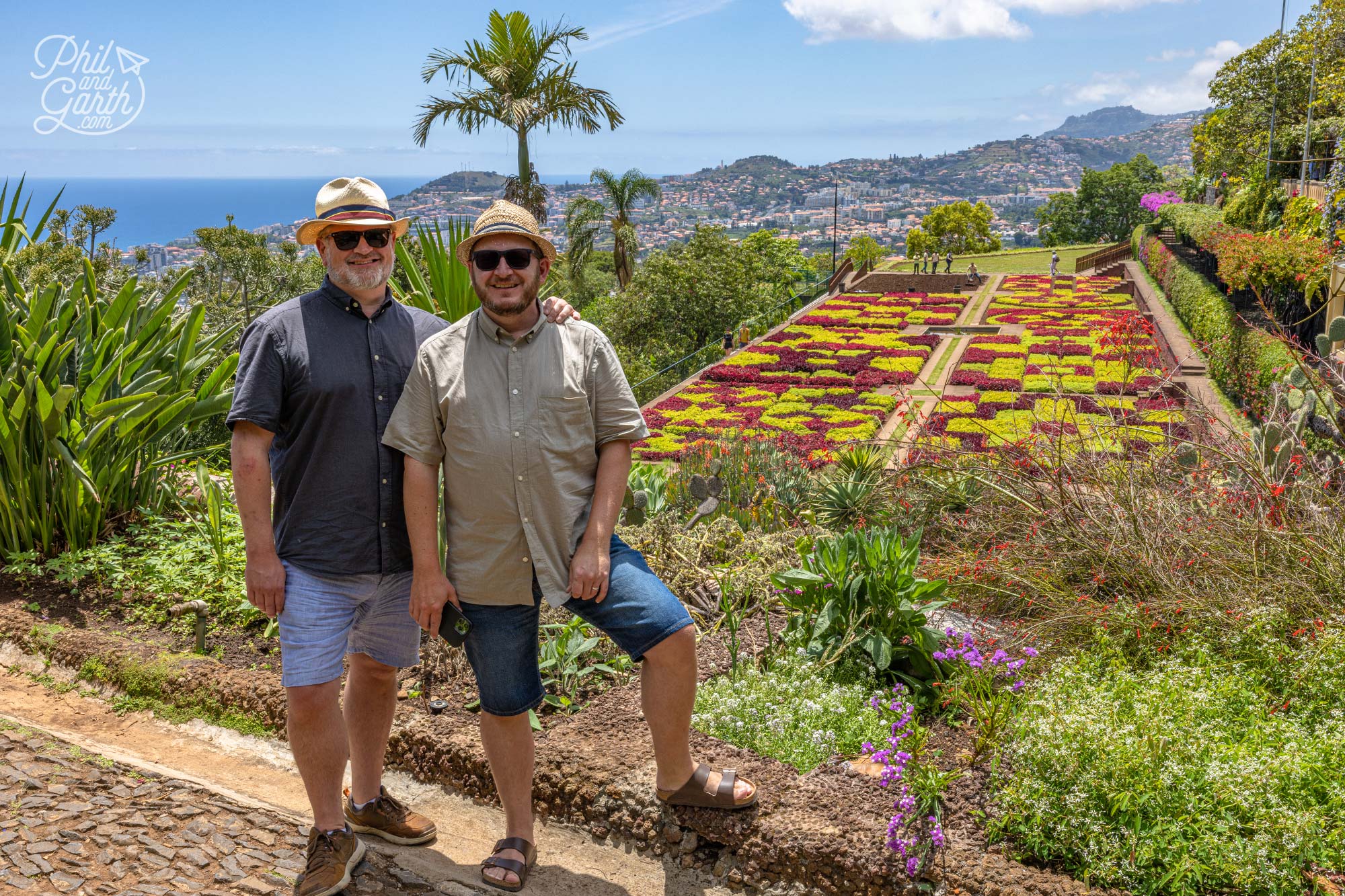
The geometric shapes and patterns of the mosaic garden
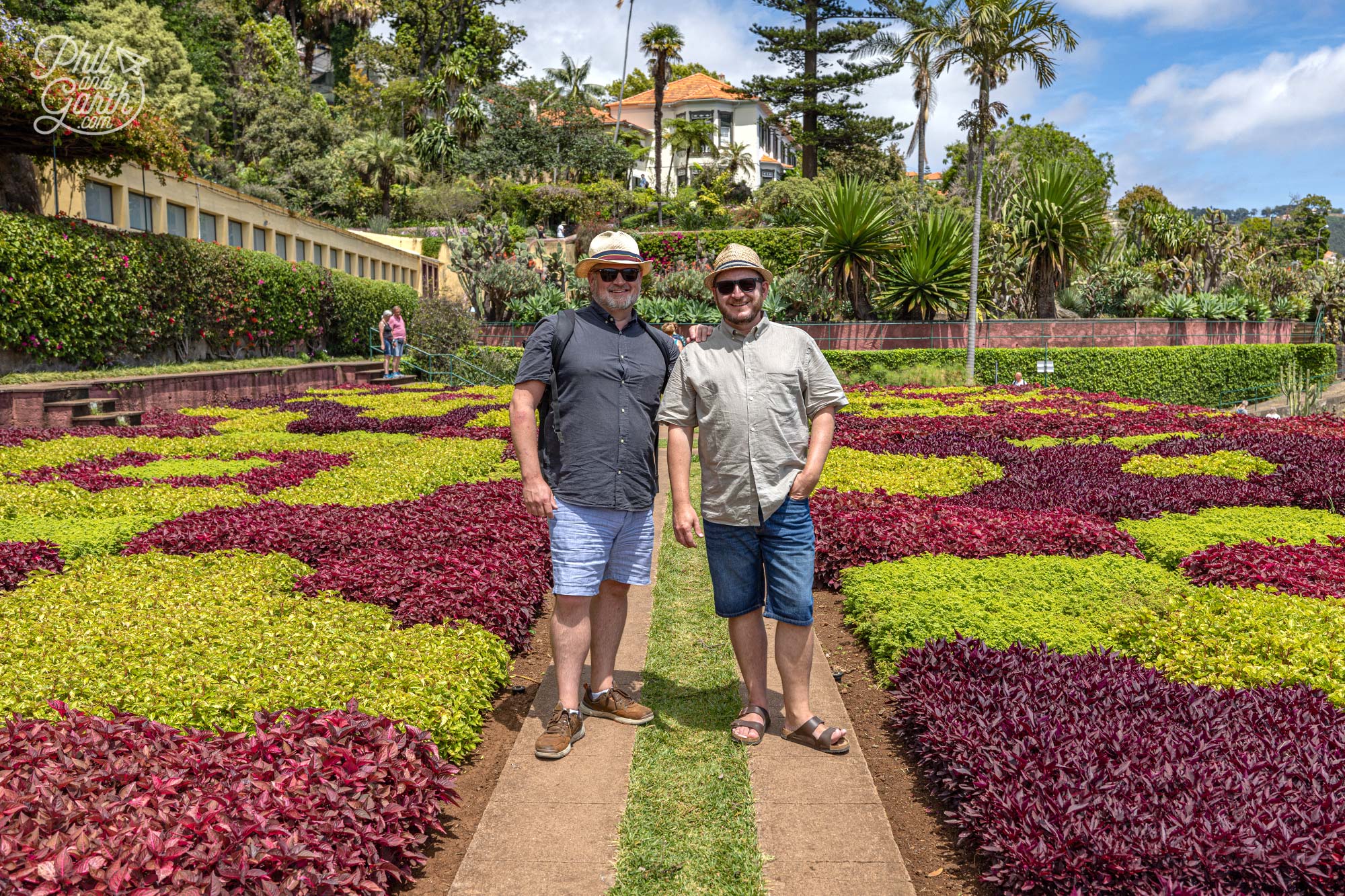
The green and purple signature colours of the mosaic garden
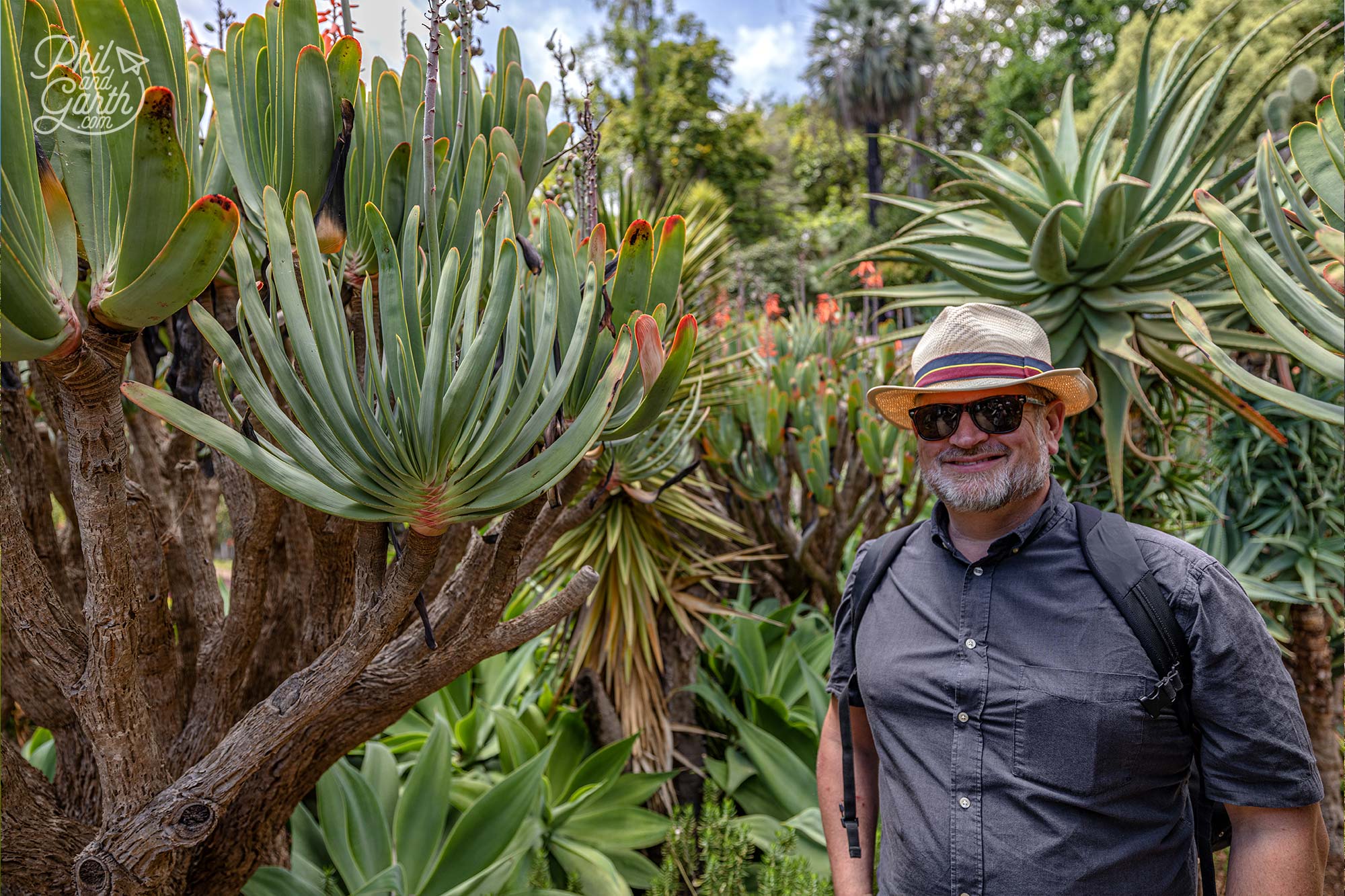
Madeira’s Botanical Garden features over 2,000 exotic plants
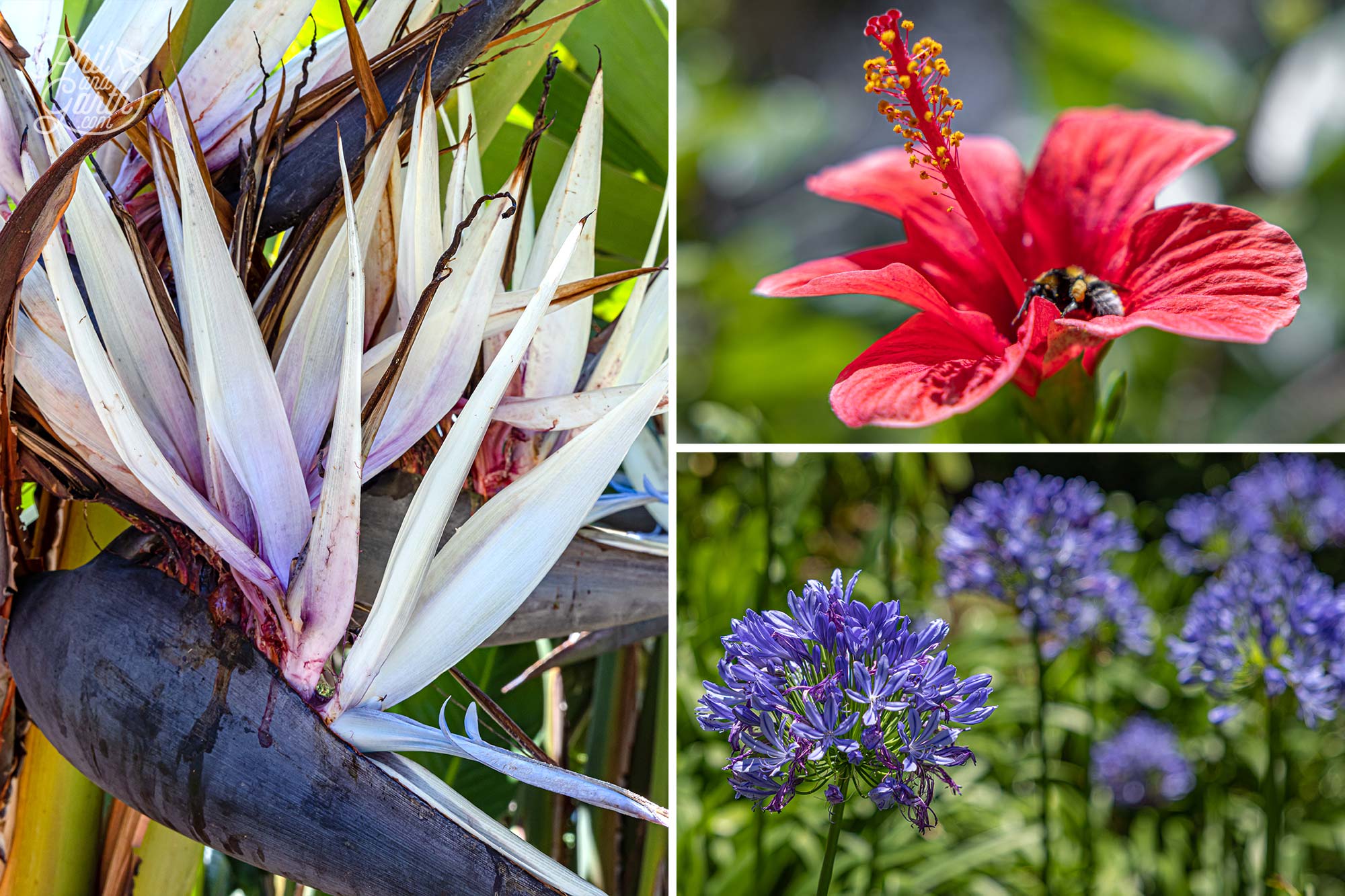
Blue agapanthus flowers grow like weeds on Madeira
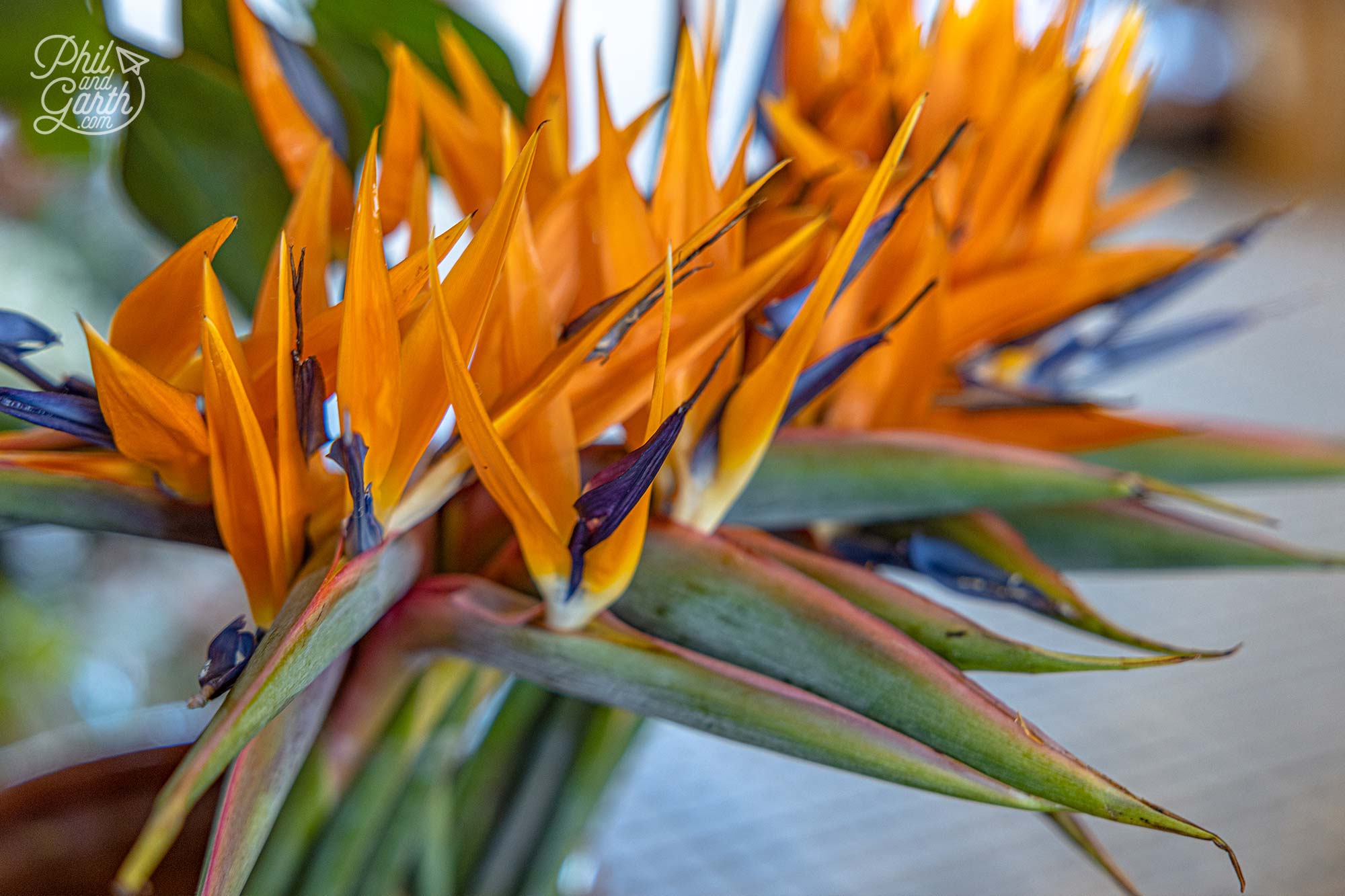
Admire the Bird of Paradise – Madeira’s national flower
Even if you’re not into gardening It’s a lovely place to come and relax, have lunch in the nice cafe or take a walk and use all the flower backdrops to snap some cool photos.
Another highlight are the views from here over Funchal which are amazing. It’s definitely the best place for a panoramic photo of Funchal. Madeira’s Botanical Garden is open from 9am to 6pm. However, if want to get the cable car back to Monte the last one is at 4.50pm, so plan ahead. We spent 2 hours here to see everything.
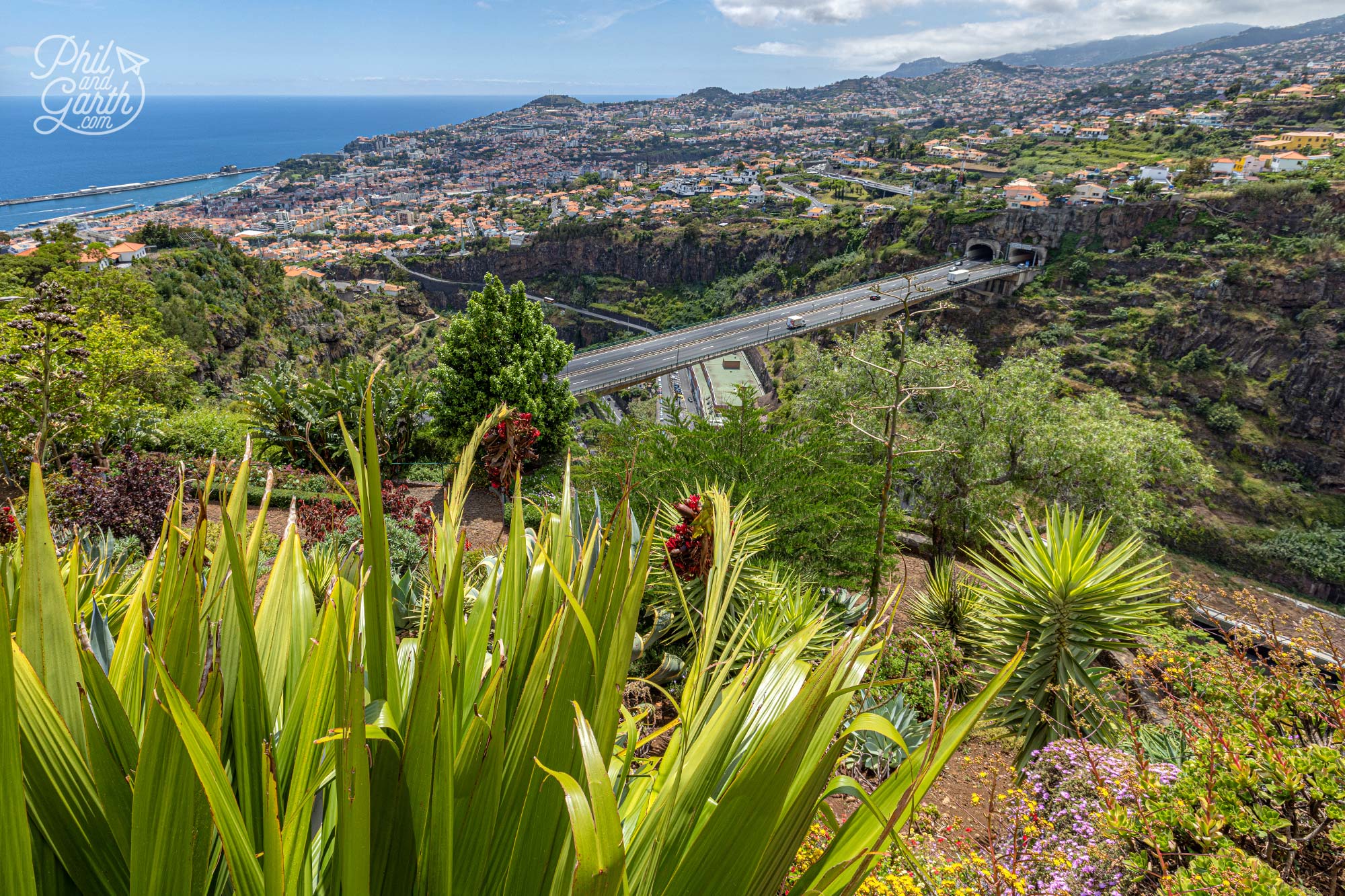
The views from the Botanic Garden over Funchal are amazing
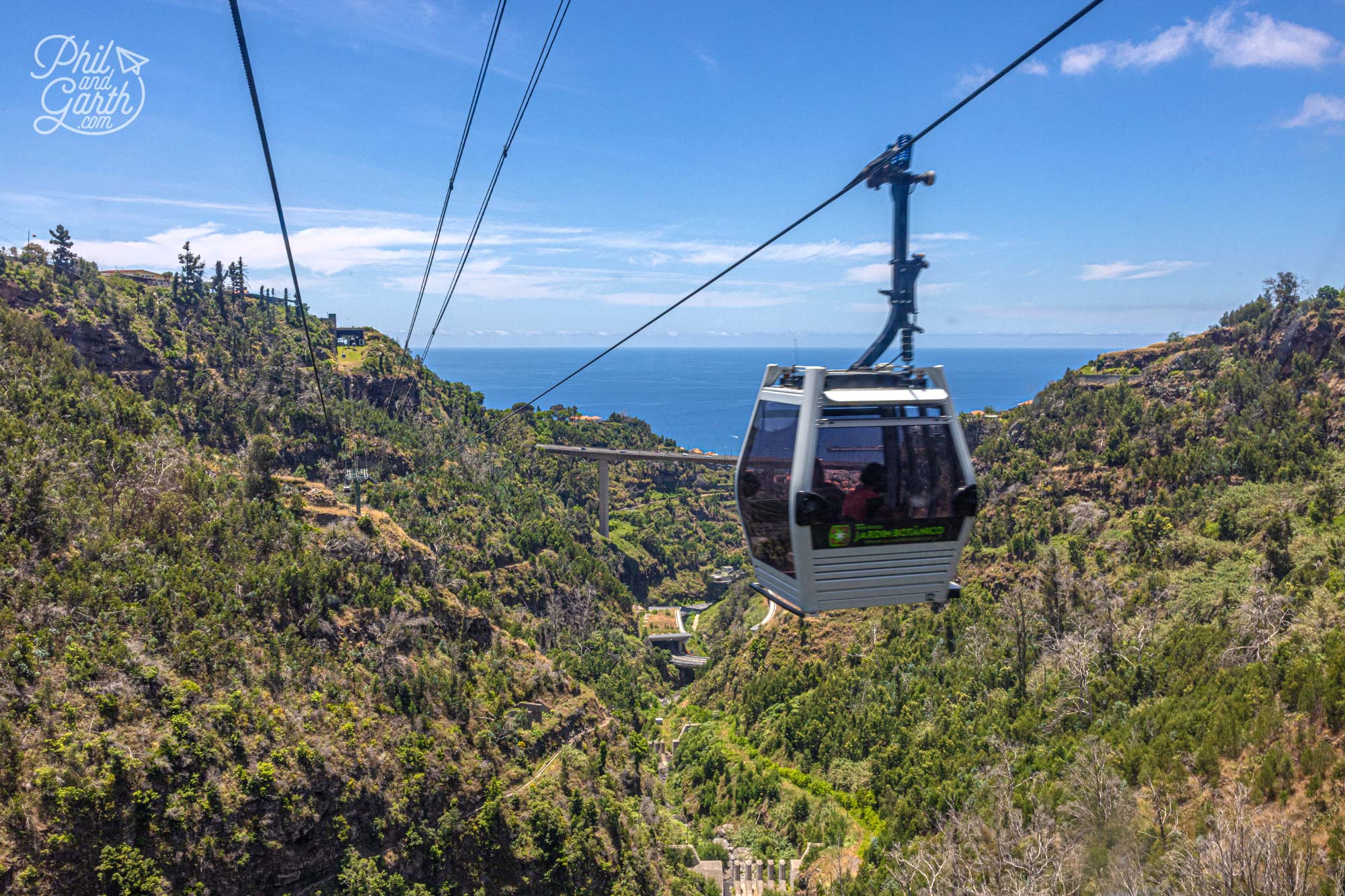
You need to take a second cable car from Monte to reach the Botanic Garden
7. Wicker Toboggan Sledge Ride
Since 1850 traditional wood and wicker toboggans called ‘carros de cesto’ have been used to slide people down from the pretty hilltop town of Monte down to the city of Funchal. These wicker baskets used to be the fastest way to get down to Funchal from Monte. It’s Madeira’s number 1 tourist attraction, yes it’s touristy but we had to give it a go! The toboggan ride starts just below the steps of the Monte Church Sanctuary and is a short walk from the Monte Palace Tropical Gardens. It costs €30 for two people or €25 for one person and can seat up to 3 people, simply buy a ticket from the booth just before the start of the long queue. Click here for the Carreiros do Monte official website.
The downhill ride lasts around 15 minutes and gets up to speeds of 20mph! so cool! Yes, it’s slightly bonkers, but really good fun and it’s quite fast with the wind, so hold onto your hats like we had to! Ernest Hemingway described it as “exhilarating”. We felt totally safe in the hands of our 2 toboggan drivers called ‘carreiros’ who wear traditional straw boater hats. They steer the basket from behind and use their feet as brakes!
They don’t actually go all the way down the hill to Funchal instead it arrives at Livramento, where you can get an expensive taxi to Funchal’s centre or walk down the rest of the hill which takes 30 minutes. Be warned it’s an absolute killer on your calves because it’s so steep! Garth was in agony at the end of it! We’re so unfit!
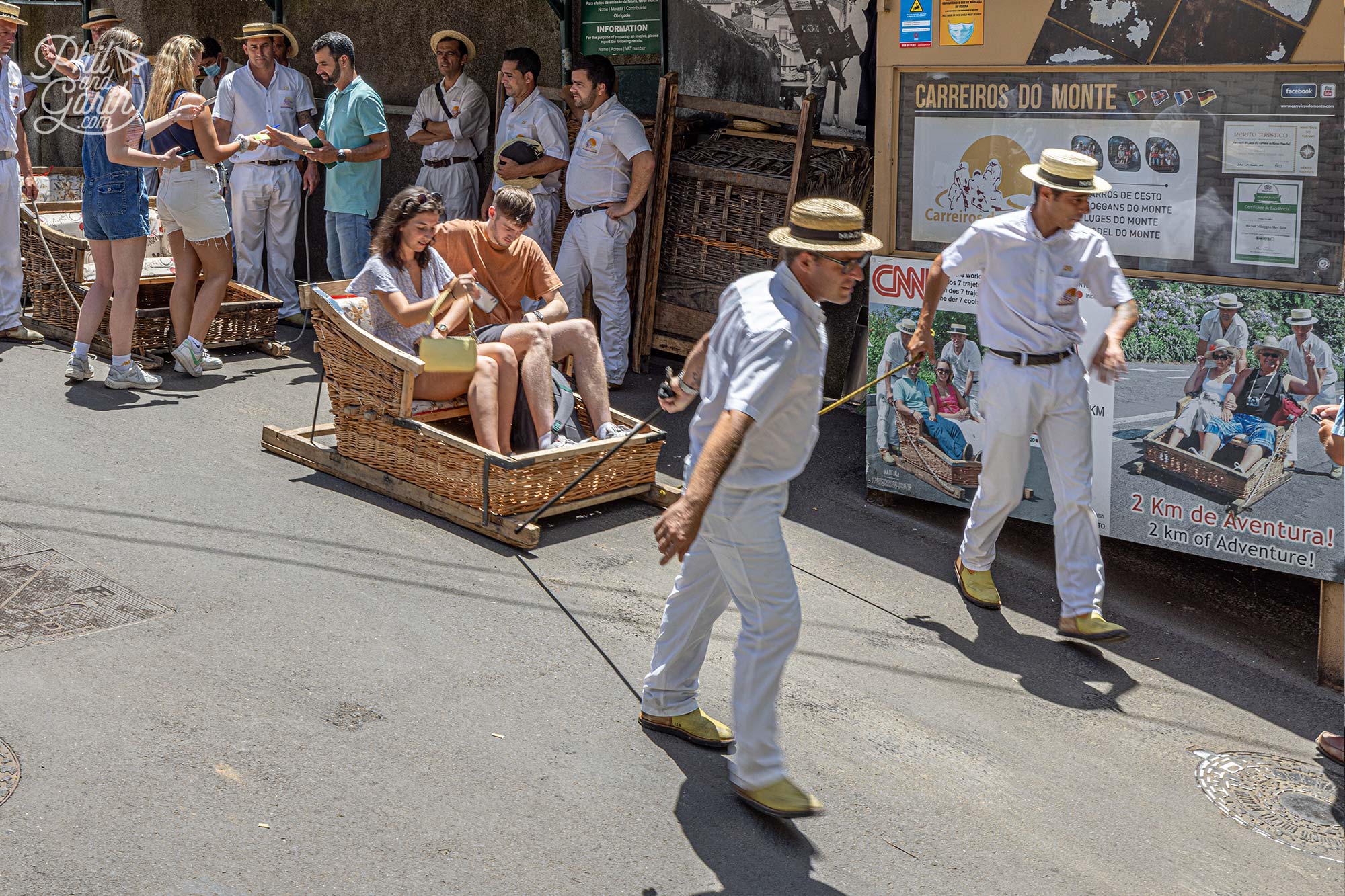
The drivers who drive the toboggans are called carreiros
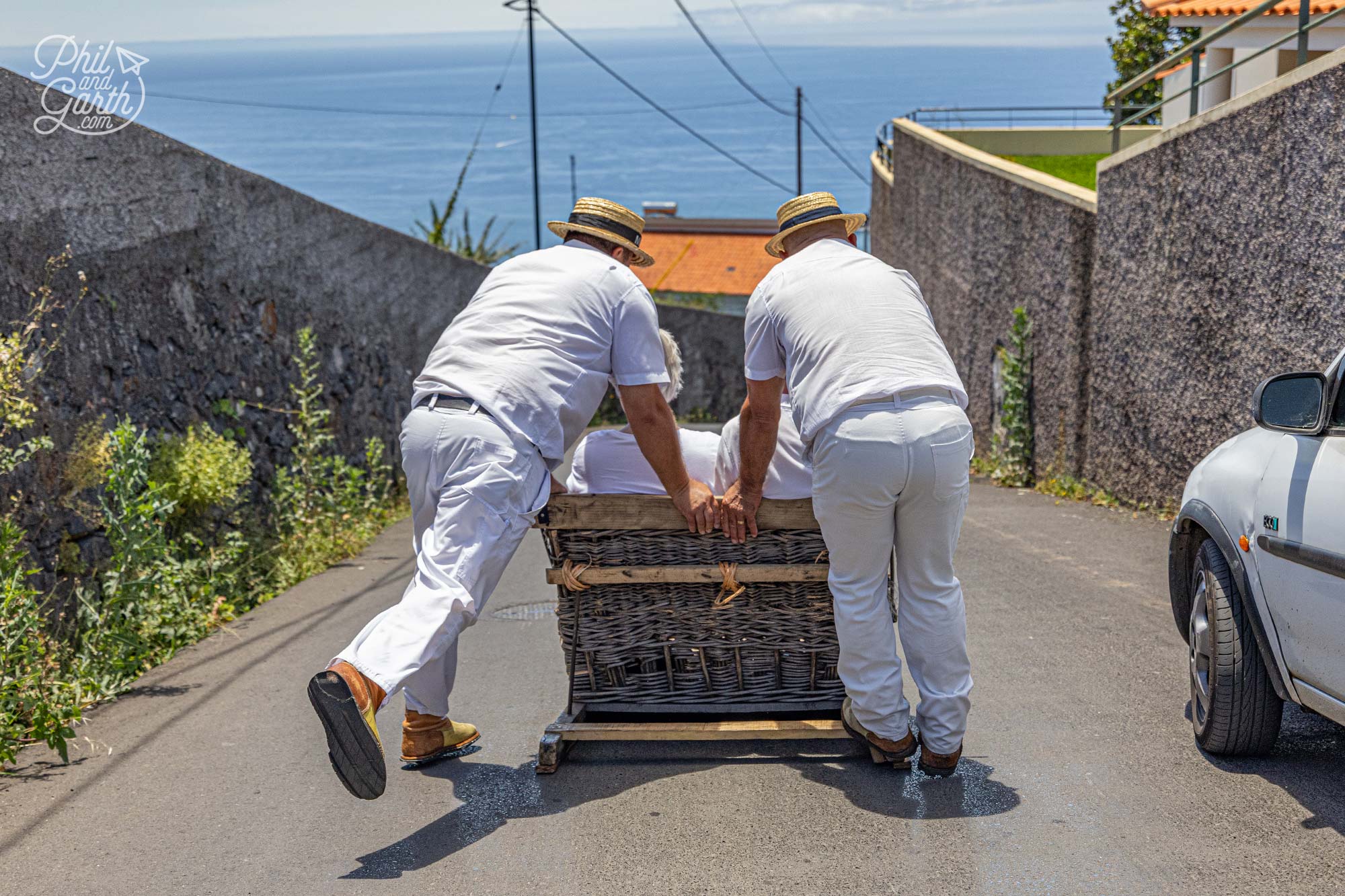
The most novel form of transport in Madeira
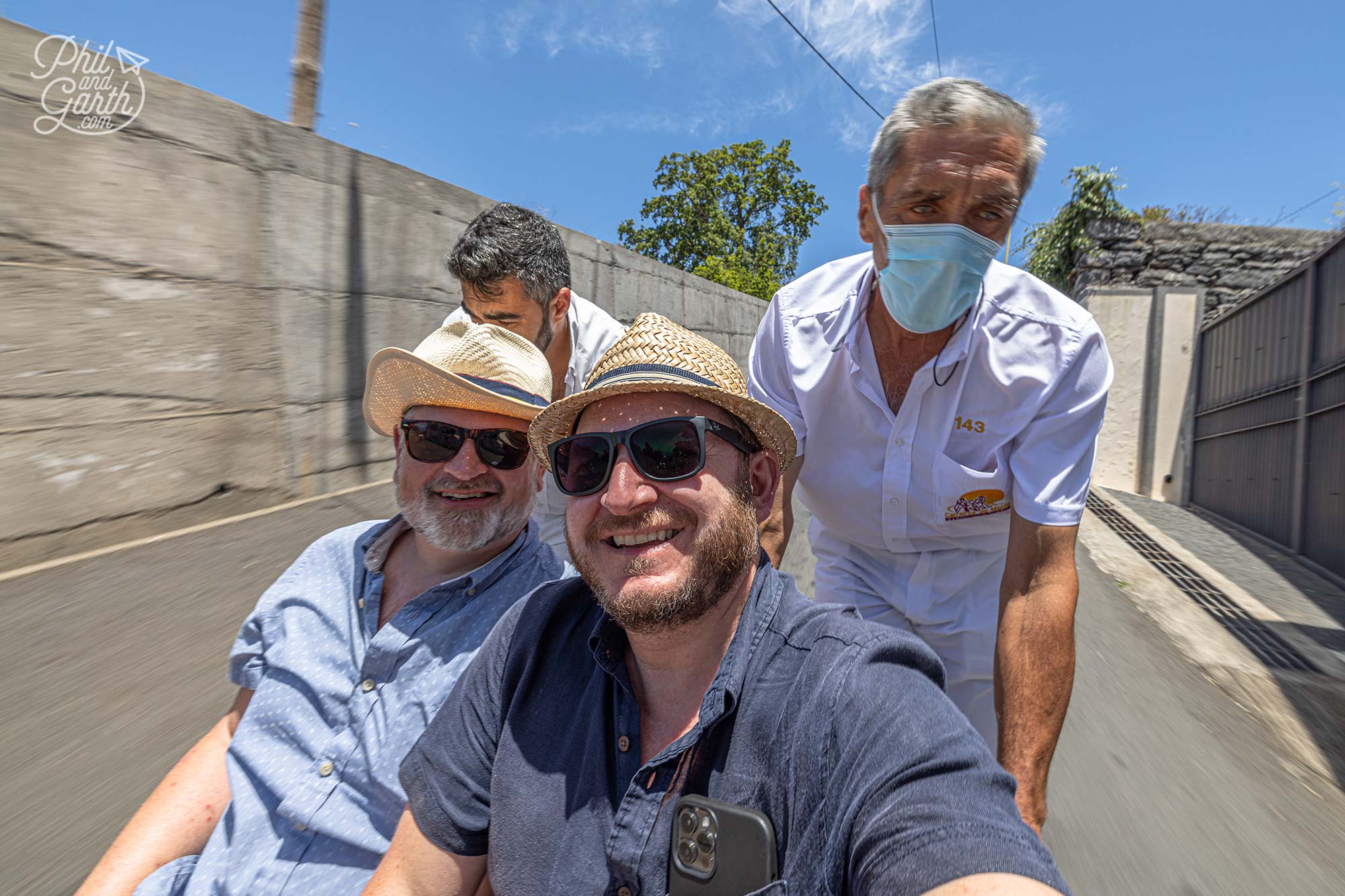
These wicker baskets used to be the fastest way to get down to Funchal from Monte
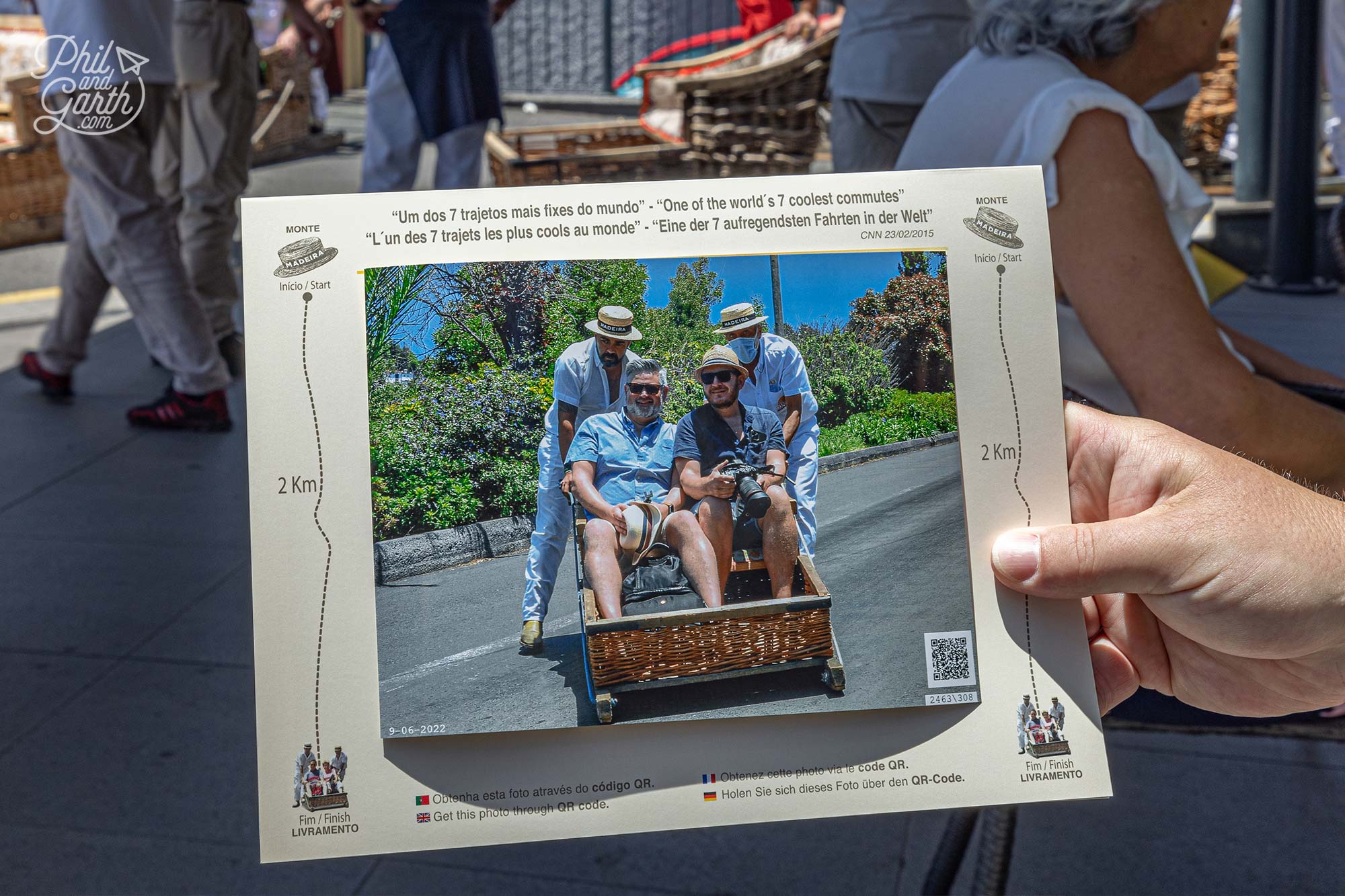
At the end of the ride you can purchase a souvenir photo
8. Blandy’s Madeira Wine Tour & Tasting
You’ll probably have heard of Madeira’s famous sweet wine, well Madeira’s most famous wine producer is Blandy’s Wine Lodge located in the centre of Funchal. We took their distillery English language guided tour and couldn’t wait for the opportunity to sample a couple of wines at the end of the tour, included in the ticket price.
Madeira wine was actually invented by accident just like Coca-Cola. Back in the day sugar cane was added to bottles of wine to prevent the wine from spoiling for sailors on long sea voyages. The wine fermented in the heat of the boat as they reached hotter climates which created a more alcoholic version – what we know now as Madeira wine.
Today the process is recreated by adding a grape spirit to increase the alcohol content and the wine is left to age in casks on the upper floors of Blandy’s distillery where it is warm, not in cellars where other spirits mature in a cooler environment.
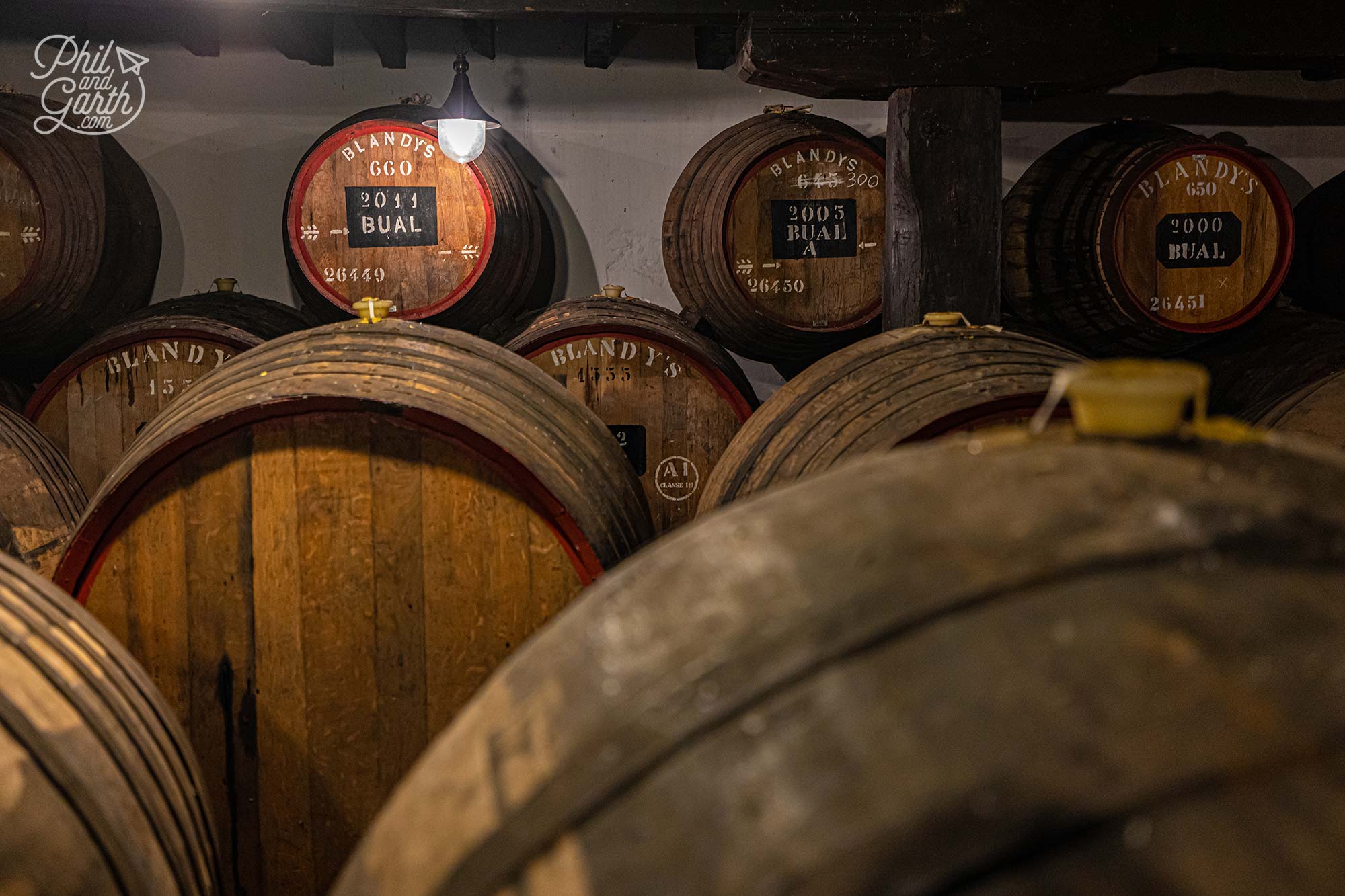
Some of the barrels are over 100 years old
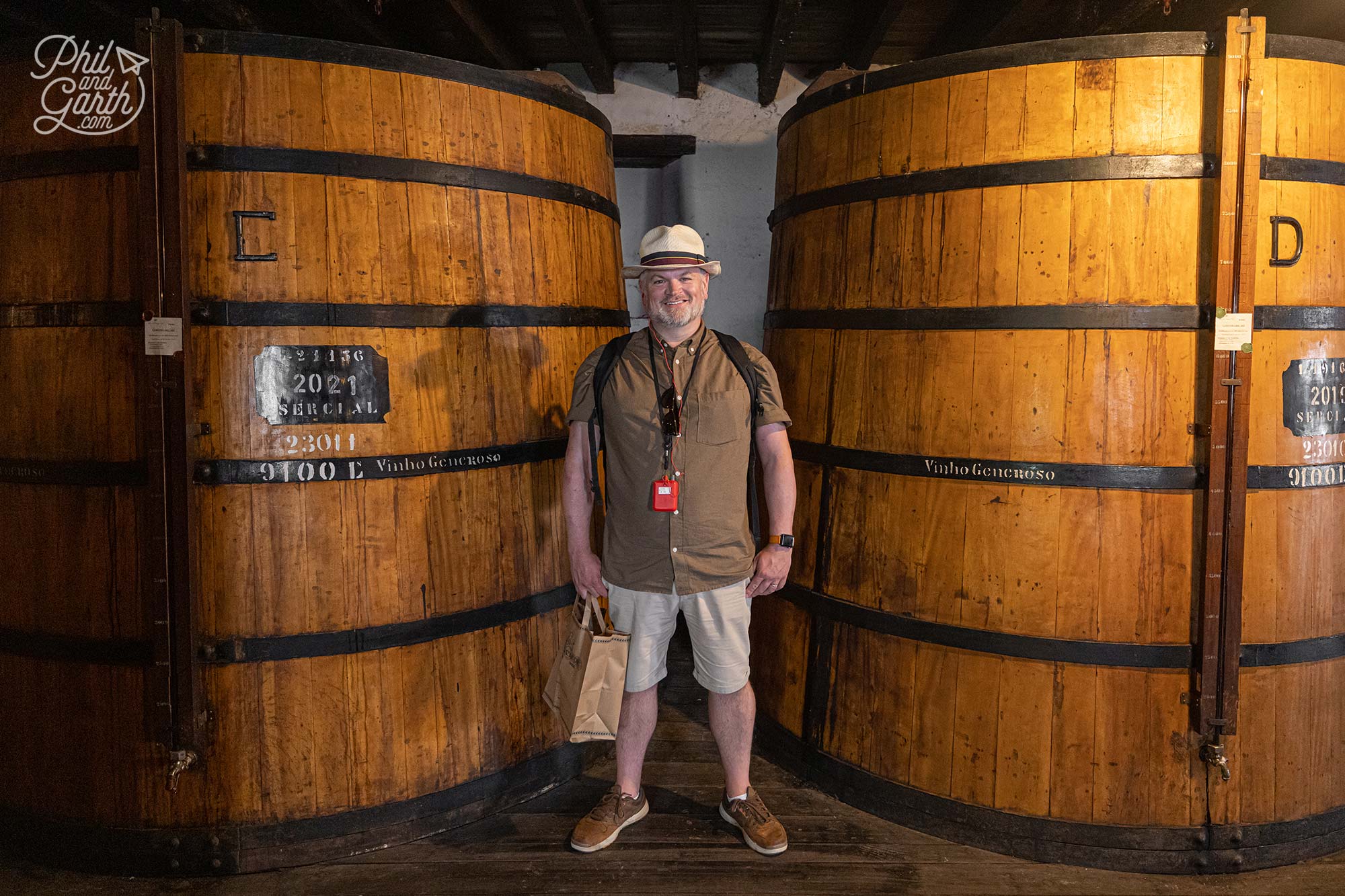
Phil stood next to the some of Blandys giant wine barrels
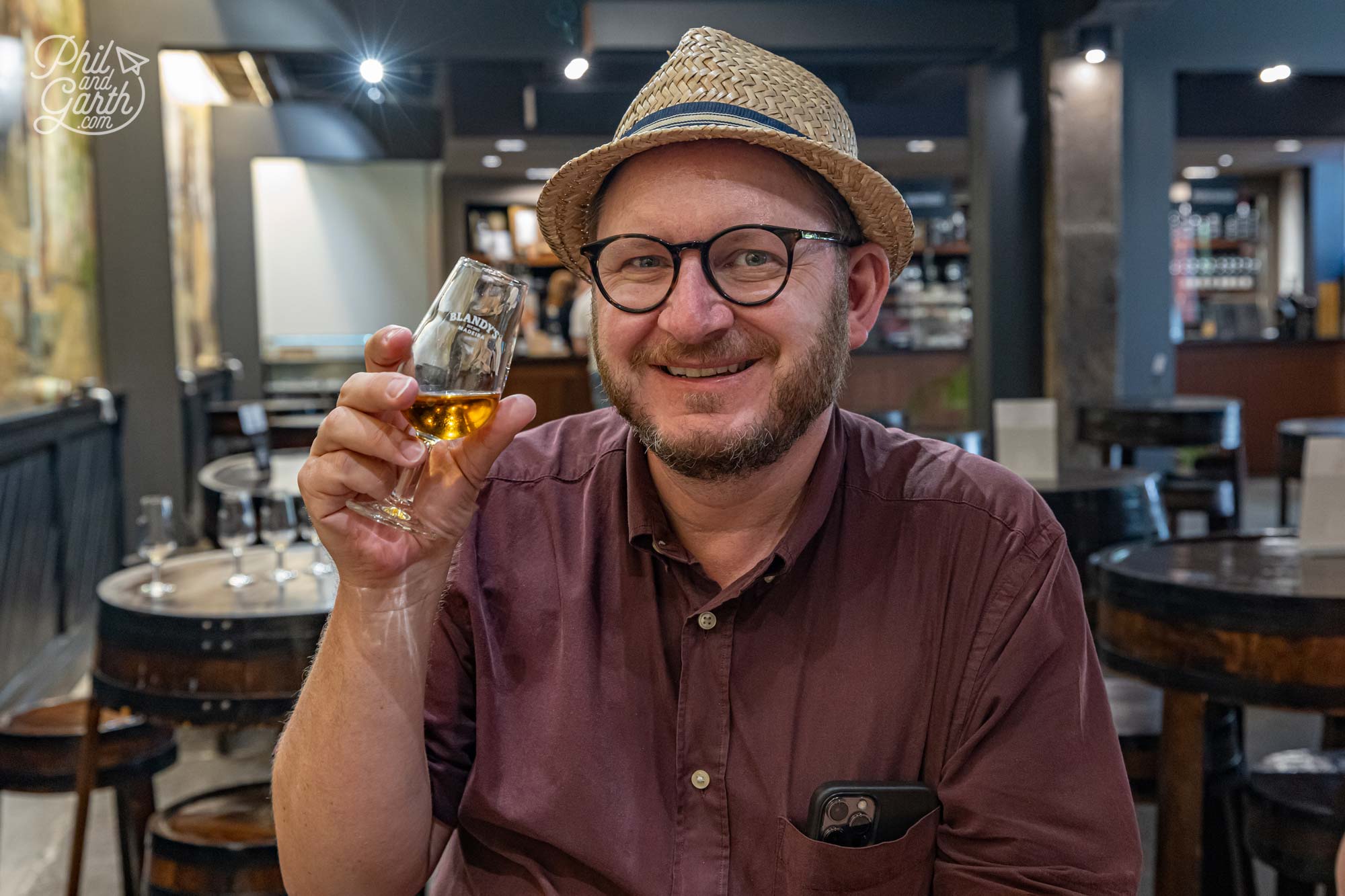
Garth trying some of Maderia’s sweet wines
As for the actual wine tasting – being honest we couldn’t taste any difference between the 5 and the 10-year-old wines. Phil being the wine connoisseur is clearly not as cultured as he makes out! 😂
The tour was really comprehensive, our guide explained all the different wines they make and explained there are not as many vineyards as there once were on the island. The 45-minute tour costs €11pp, try and check if there’s a cruise ship in port otherwise it will be packed. It’s also one of the best things to do on a rainy day in Funchal because it’s all indoors.
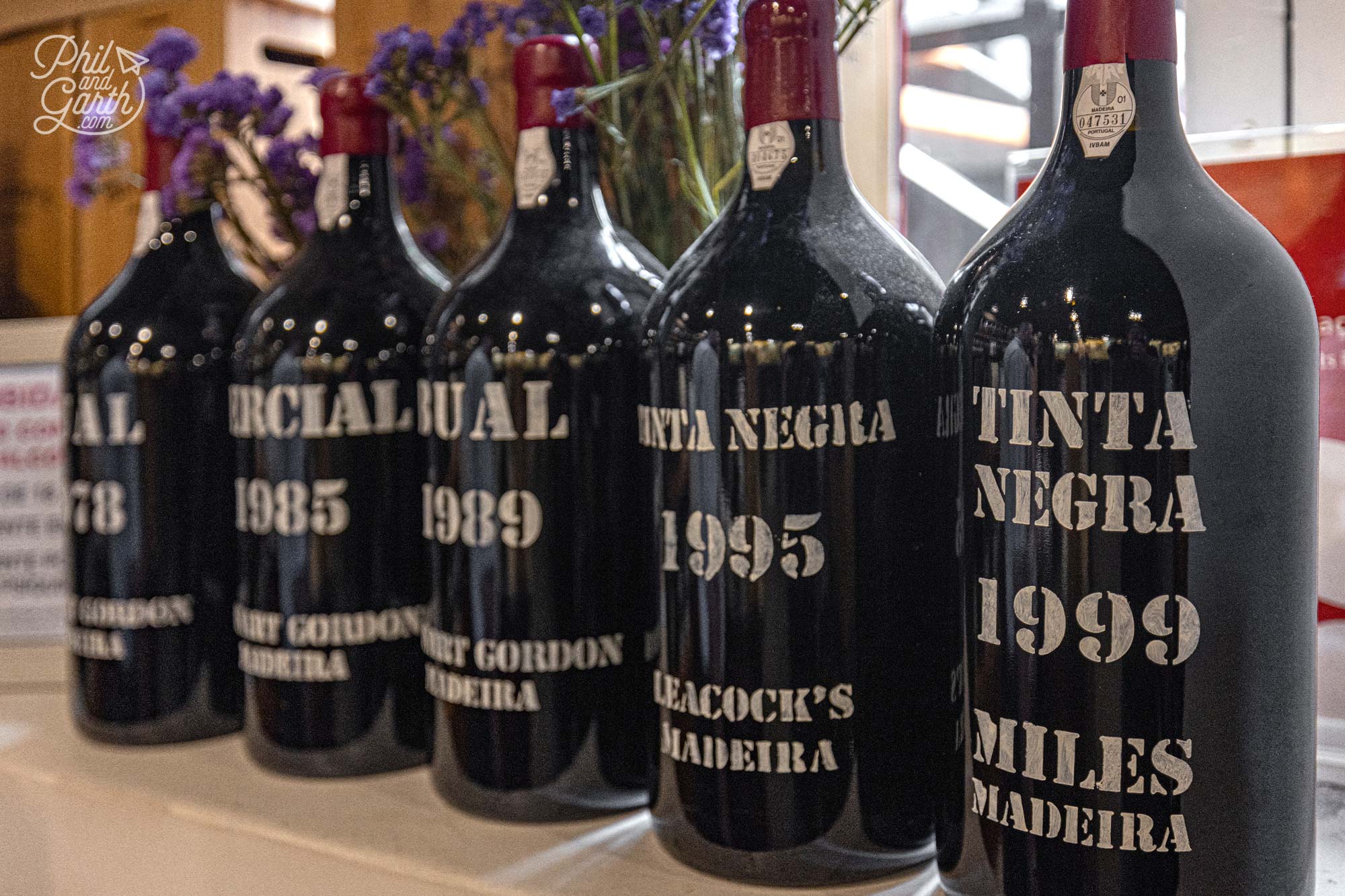
Blandy’s Madeira Wine Tour
9. Drink Poncha & Eat Local Dishes
When you’re done with your glass of Madeira wine, then you have to try a poncha! It’s Madeira’s national drink – a zesty alcoholic drink made with rum from the island’s sugar cane, honey, lemon and sugar. Poncha comes in different flavours with orange being the most popular. Our favourite was easily poncha made with freshly squeezed passion fruit.
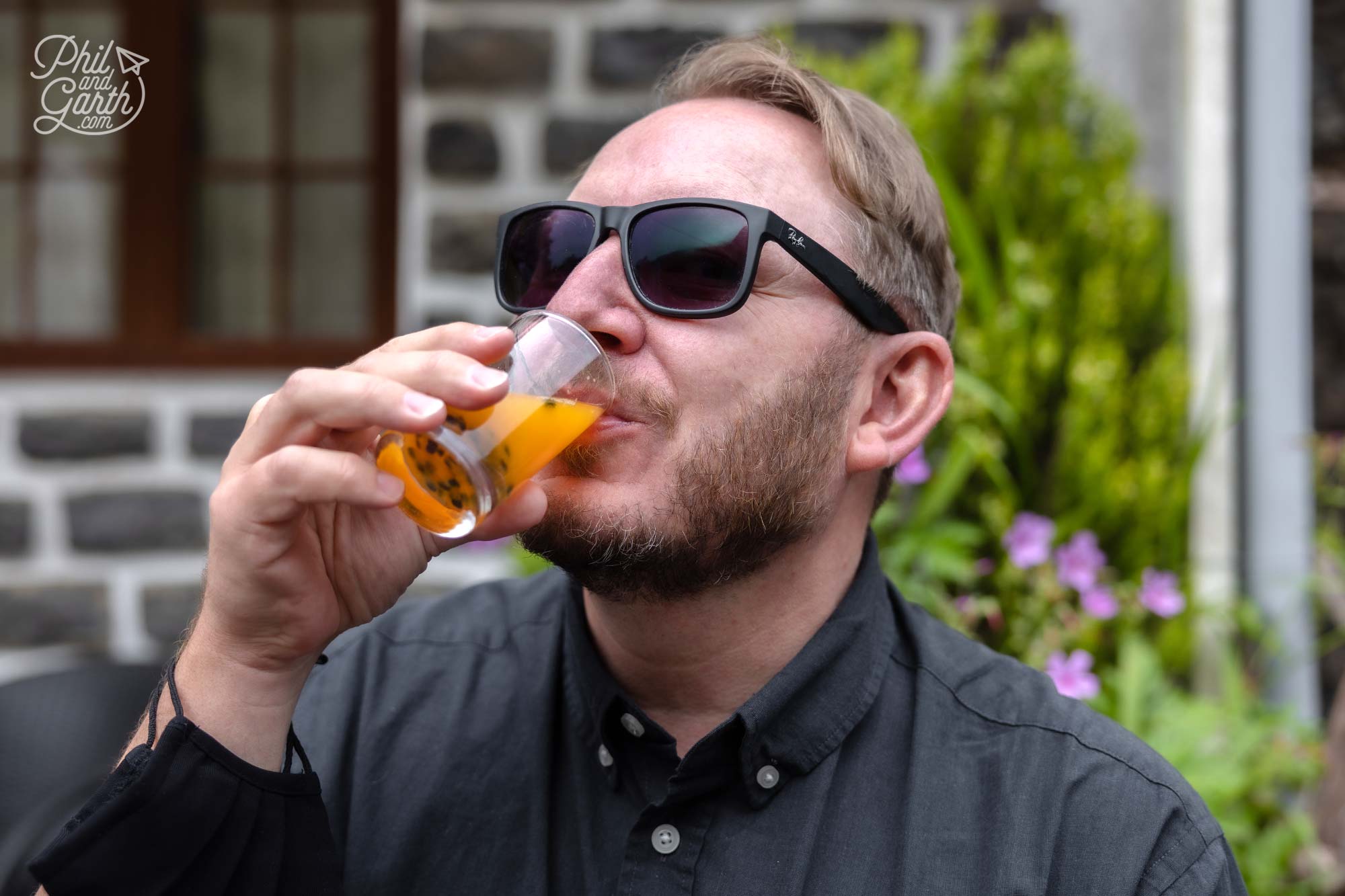
Garth enjoying a fresh passion fruit poncha
So what about the local food? well being an island, Madeira is big on seafood. Here’s 6 local dishes we tried:
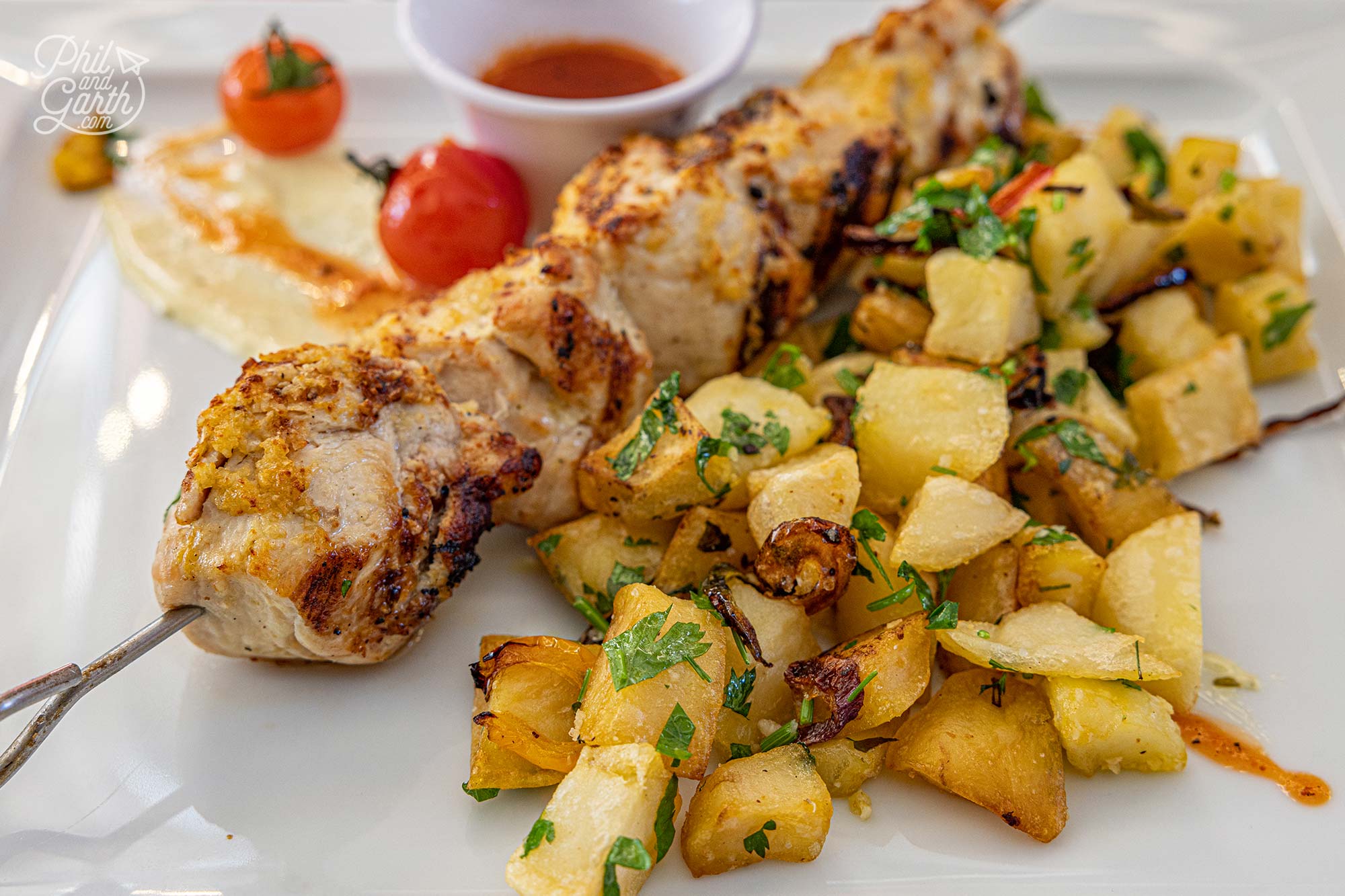
Chicken Espetada – Madeira’s favourite dish
- Espetada – Top of the list, is Madeira’s favourite dish, Espetada. Chunks of beef or chicken roasted over charcoal on skewers with bay leaves and usually served on a hook at your table. A bit like an Indian shashlik, traditionally skewered with a laurel stick.
- Espada Com Banana. Fried fish served with bananas, passion fruit and potatoes. Espada is a black scabbard (see photos above) – a common fish to Madeira found in the Atlantic Ocean and some islands in Japan. There’s also a sword-fish version called Filete de Espada com Banana.
- Bolo de Caco – A garlic flat bread made with sweet potato, usually served hot with garlic butter, yum!!
- Milho, Cebolada e Atum – A tuna steak served with fried cubed maize, onion and potato.
- Lapas – Grilled limpets (similar to clams) cooked in lemon and butter, sprinkled with fresh lemon.
- Sopa de tomate e cebola – A tomato and onion soup topped off with a poached egg.
If like us you’ll have seen Madeira cake in English supermarkets (which Phil says is the most boring cake in the world). Well, we didn’t see any for sale on Madeira, that’s because it’s a British sponge cake that got its name from Madeira wine which used to be served with the cake in the 1800s. Try Bolo de Mel instead – a cake made with honey, orange and dried fruits, much nicer! Every day Garth couldn’t get enough of the Pastel de nata – they are sweet and delicious! but avoid the ones with cinnamon on them! yuk.
10. Full Day East Island Tour from Funchal
Whilst staying in Funchal, go see a bit of the island with a full-day island tour that conveniently picks you up and drops you back directly to your Funchal hotel. There are dozens of choices available.
We booked the Madeira East Island tour with MB Tours. It was a brilliant way to get a flavour of what else Madeira has to offer on a whistle-stop coach tour. We started at the largest monument in Madeira – Sanctuary of Our Lady of Peace taking in some great views of Funchal.
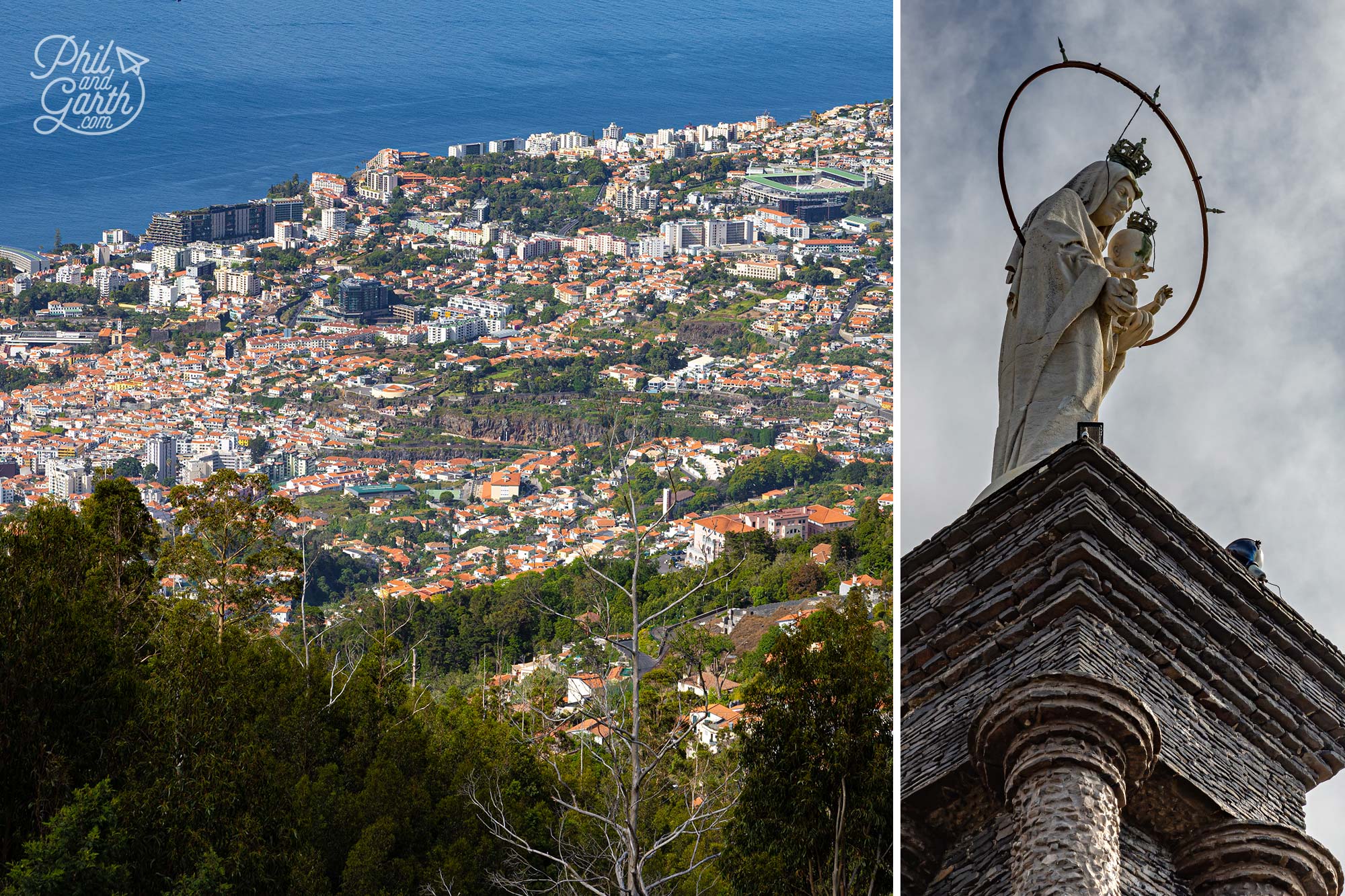
First stop at the Sanctuary of Our Lady of Peace for some epic views over Funchal
We then headed up the mountains to the spectacular viewpoint of Pico do Arieiro – Madeira’s third highest peak. The views from here are epic looking down on the clouds. On a clear day, you can see the neighbouring island of Porto Santo, 30 miles away.
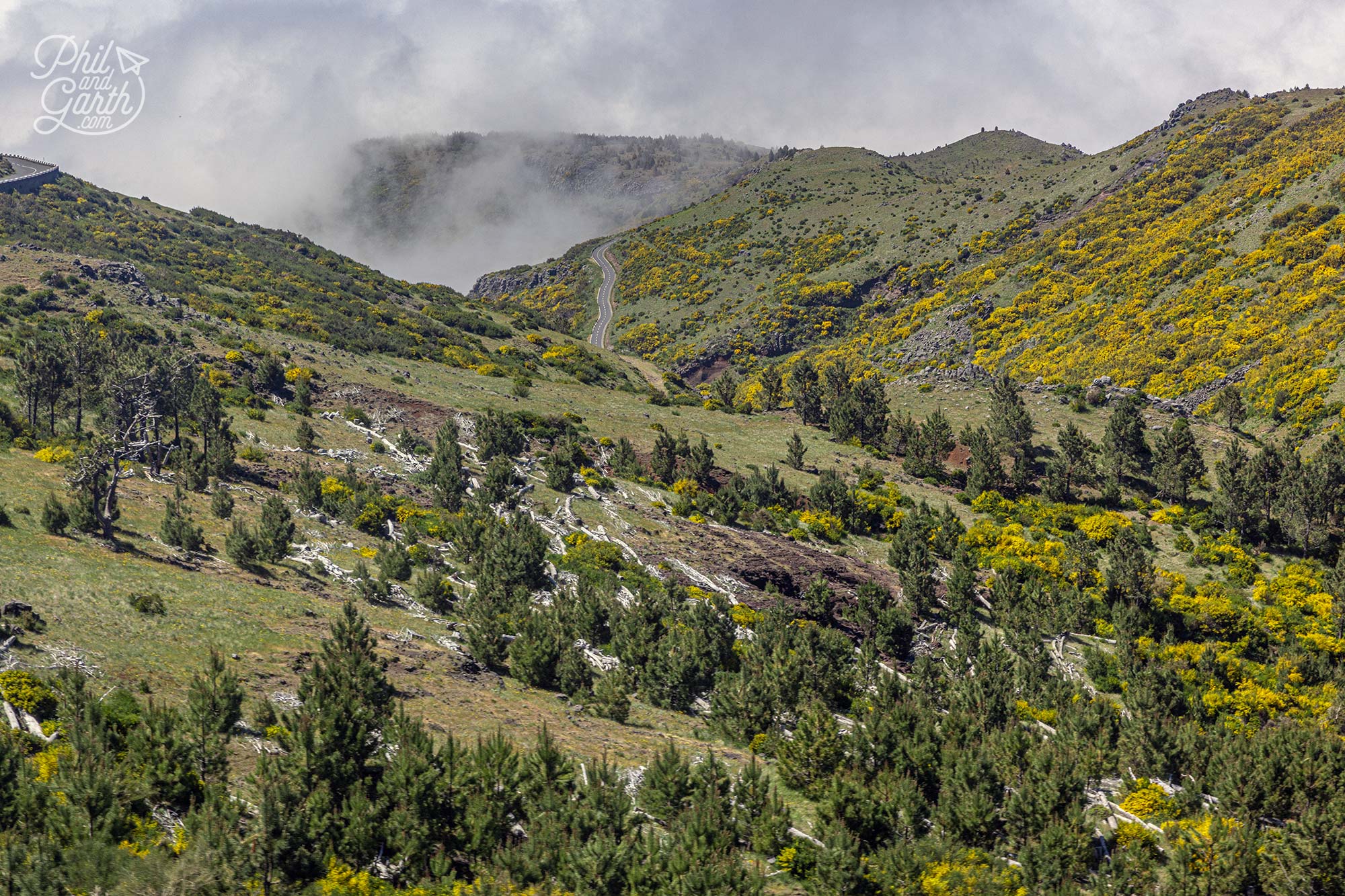
The road up to Pico do Arieiro
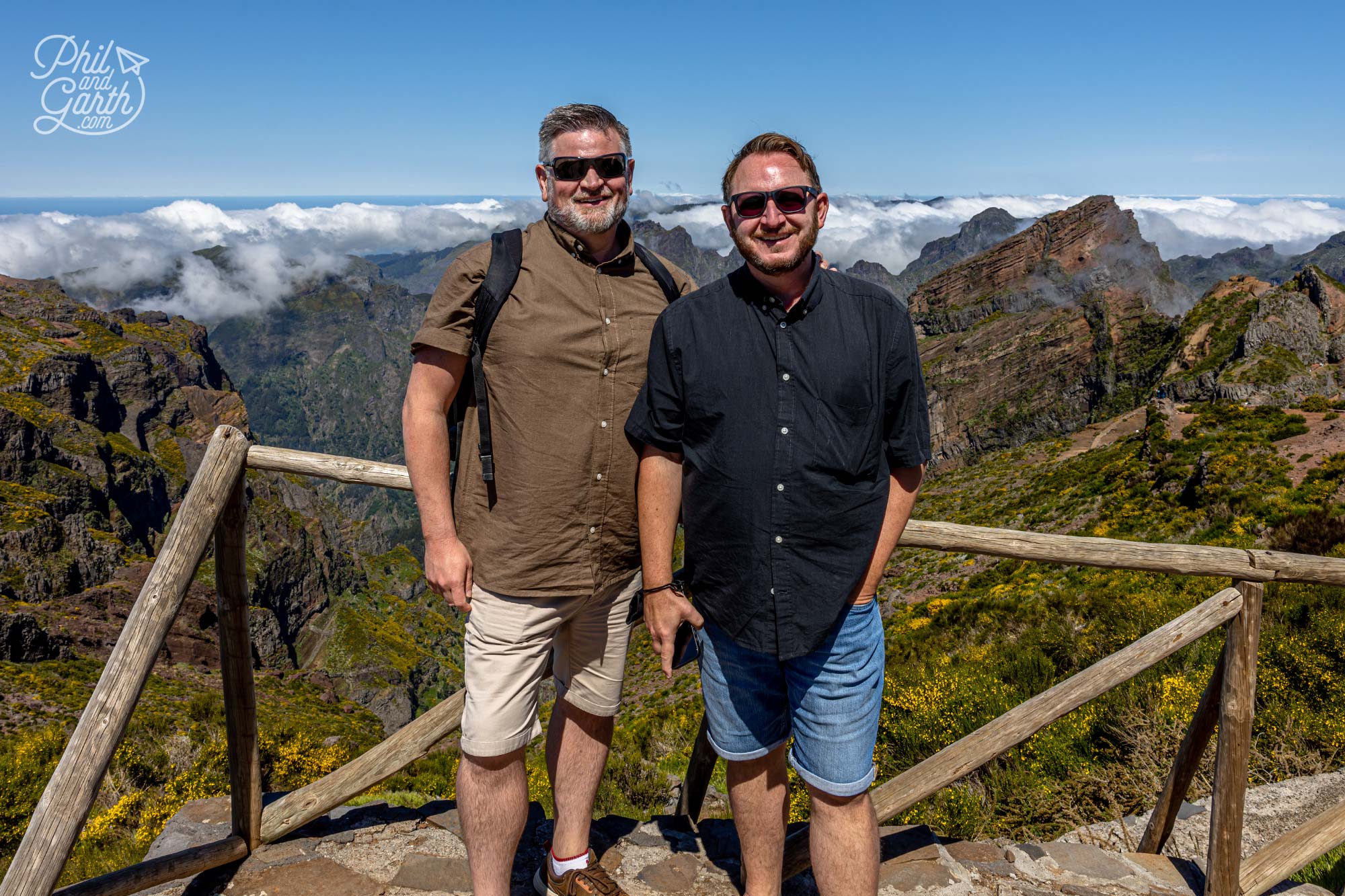
Phil and Garth at the spectacular viewpoint of Pico do Arieiro
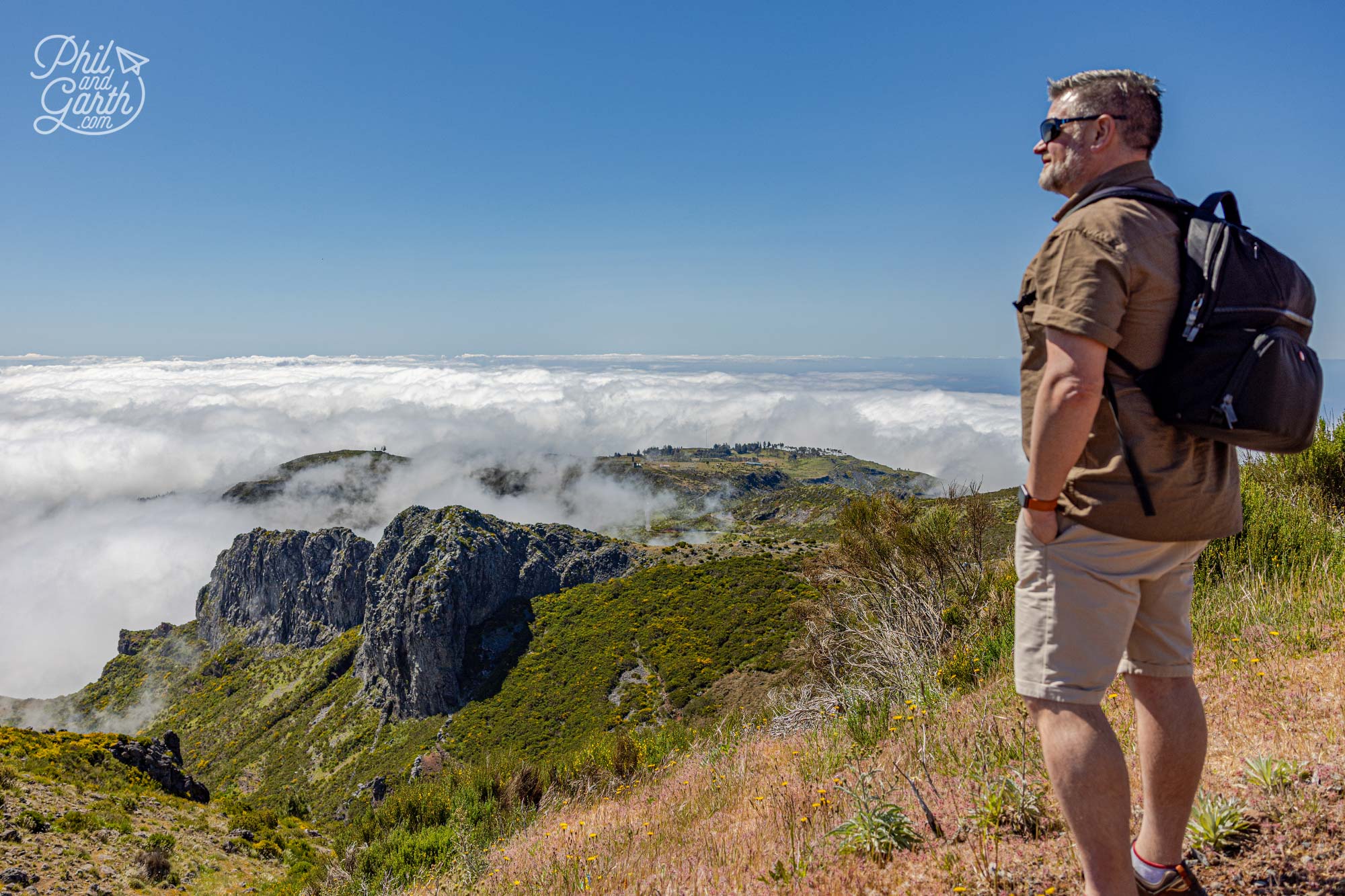
Phil taking in the panoramic views at Pico do Arieiro
Then it was on through the forest to the small village of Ribeiro Frio known for its small trout farms. We stopped off at a local bar to drink some fresh passion fruit poncha, it’s super alcoholic but delicious! This village is popular with hikers as it’s the starting point for many Levada walks.
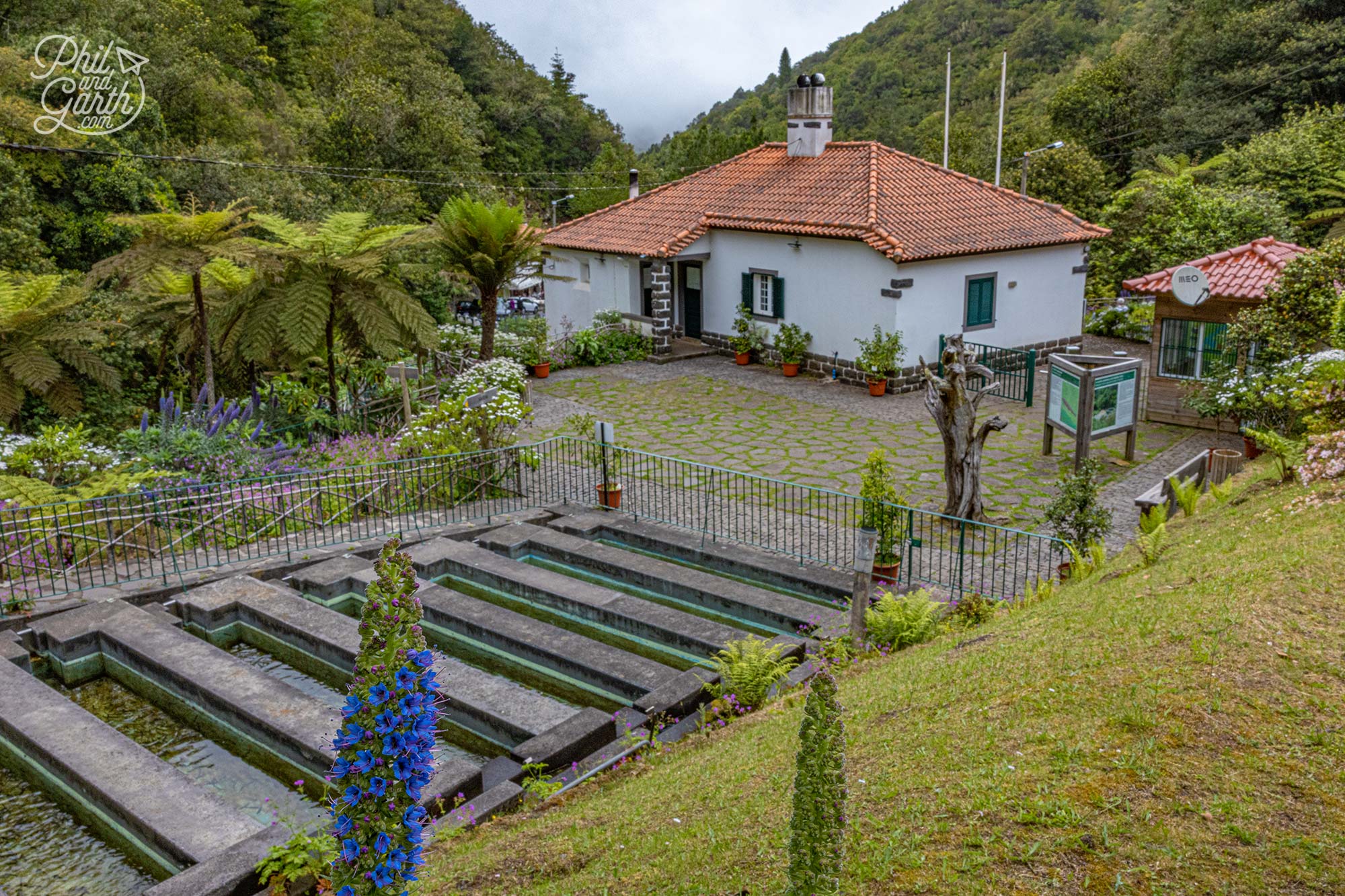
A trout farm at the small village of Ribeiro Frio
The next stop was the spectacular viewpoint of Eagle Rock, it’s kinda what we imagine Hawaii looks like, Garth thought it looked like a scene from Jurassic Park. Then 5 minutes later we arrived at Santana to see the traditional Madeira triangular thatched cottages and stop for an organised group lunch.
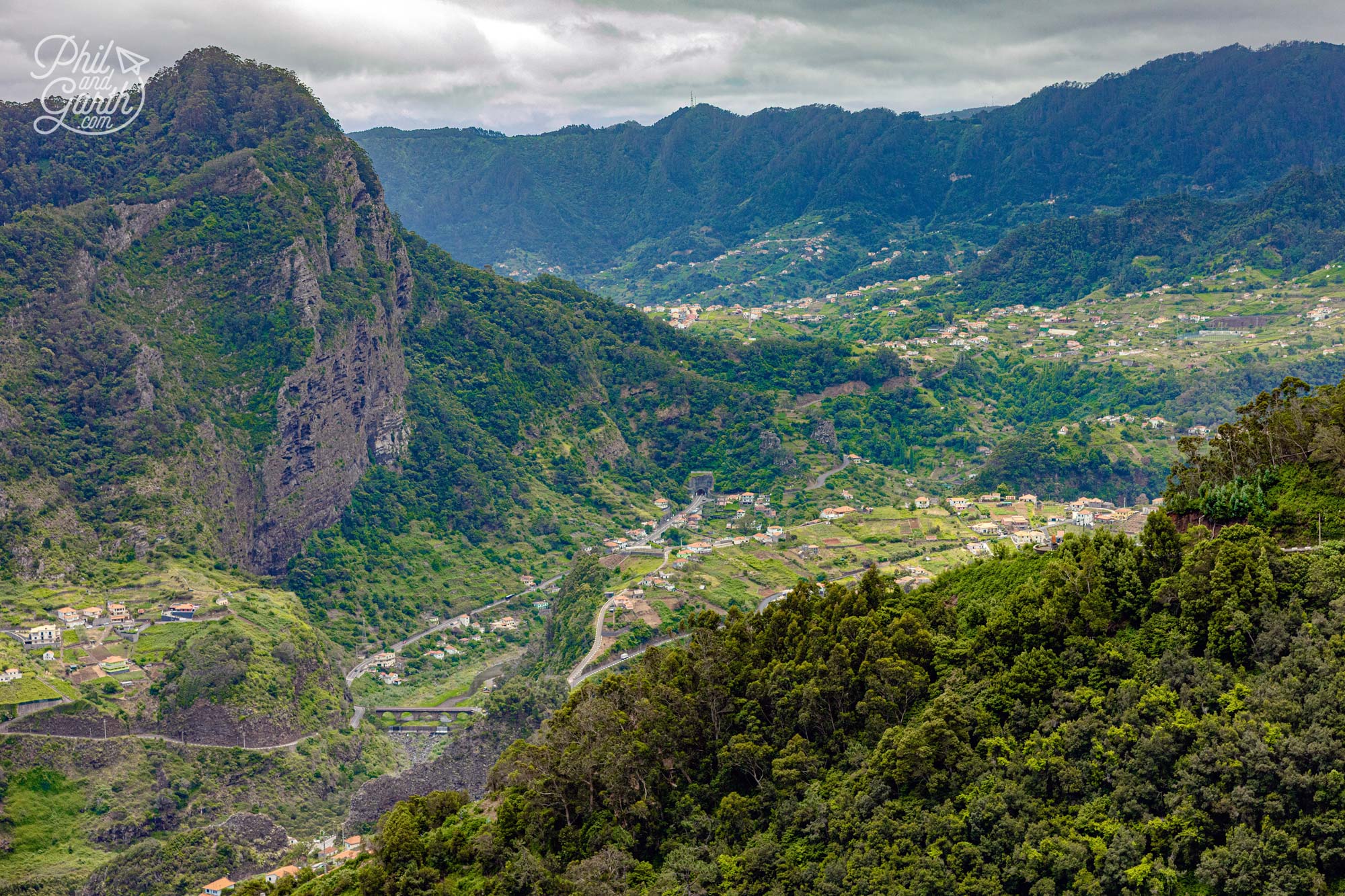
Eagle Rock and Madeira’s stunning countryside
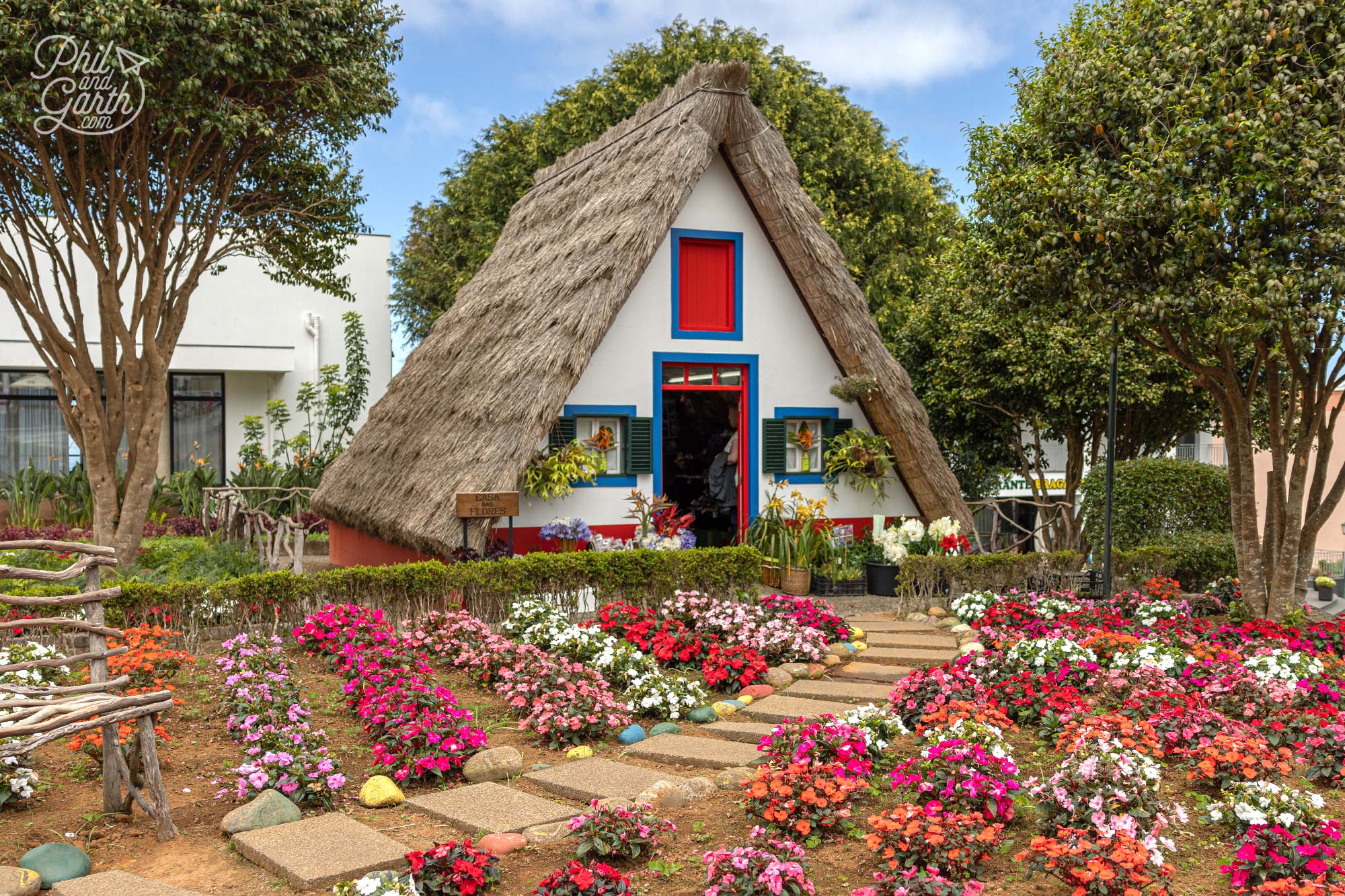
Madeira’s traditional triangular thatched cottages at Santana
After lunch, it was onto the pretty coastal village of Porto da Cruz to visit the sugar cane rum factory on a self-guided tour, where we bought some orange juice poncho to take back to the hotel for nightcaps. 😊
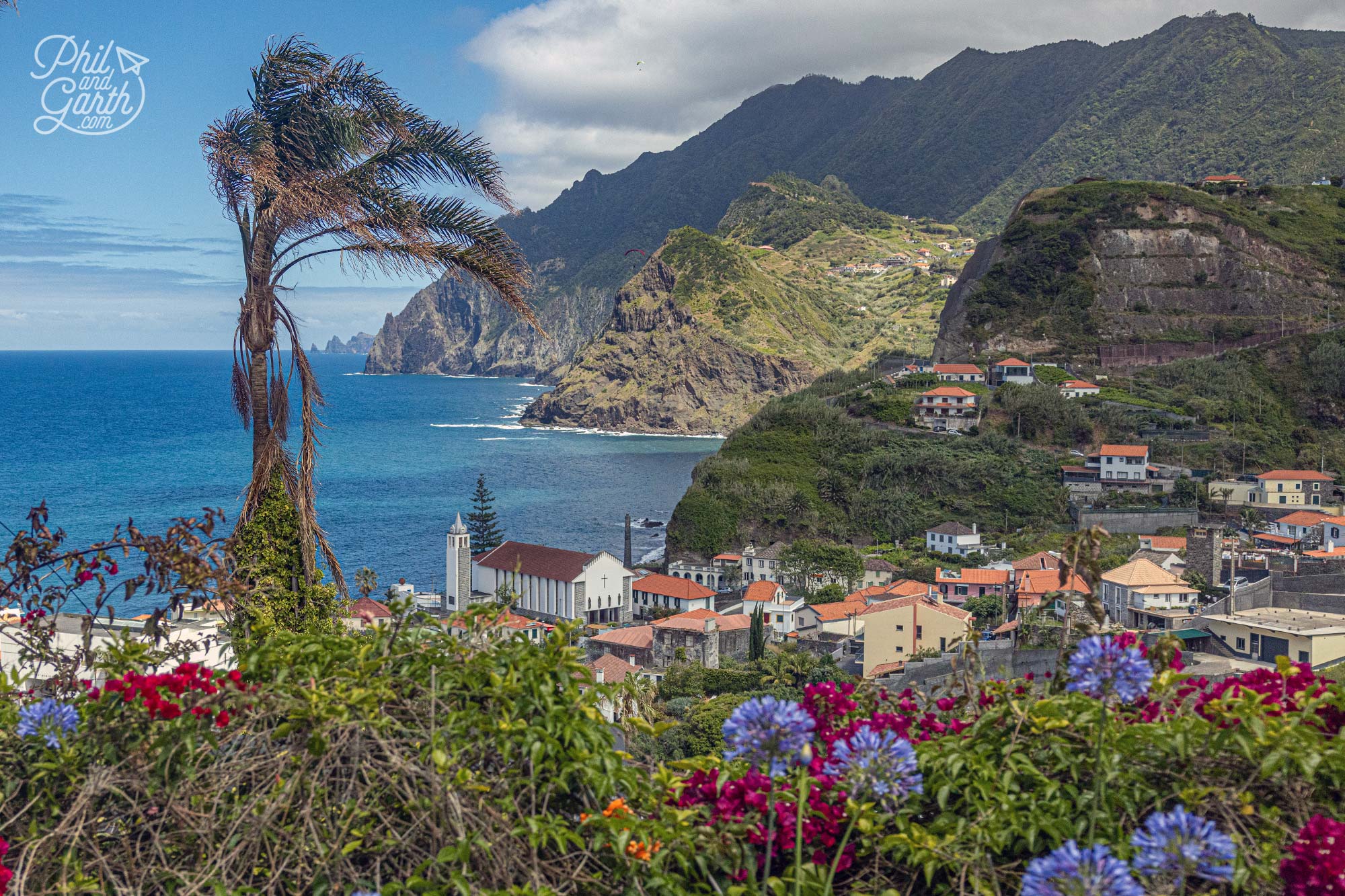
Stunning views from the coach on our way to Porto da Cruz
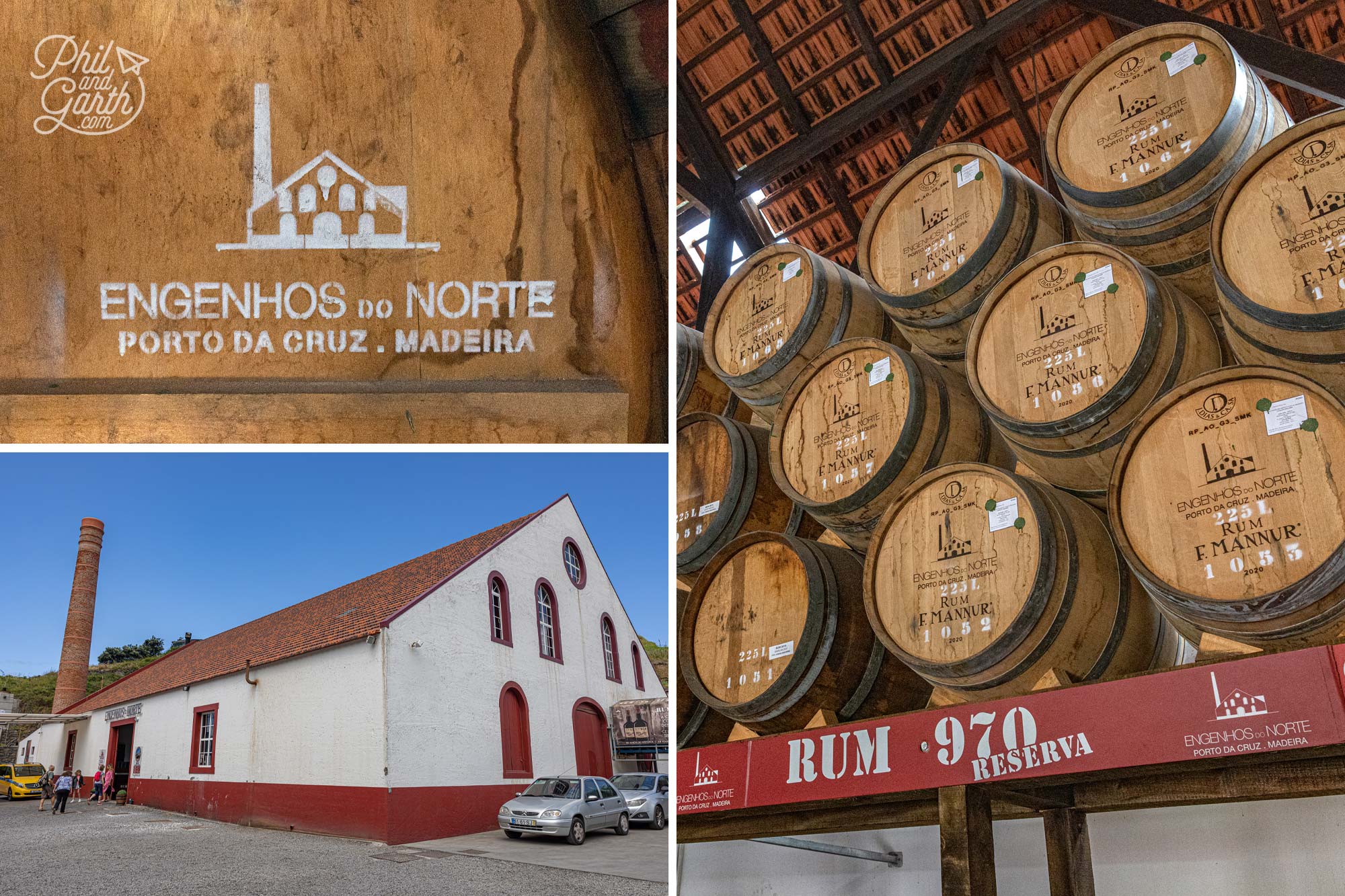
Engenhos do Norte
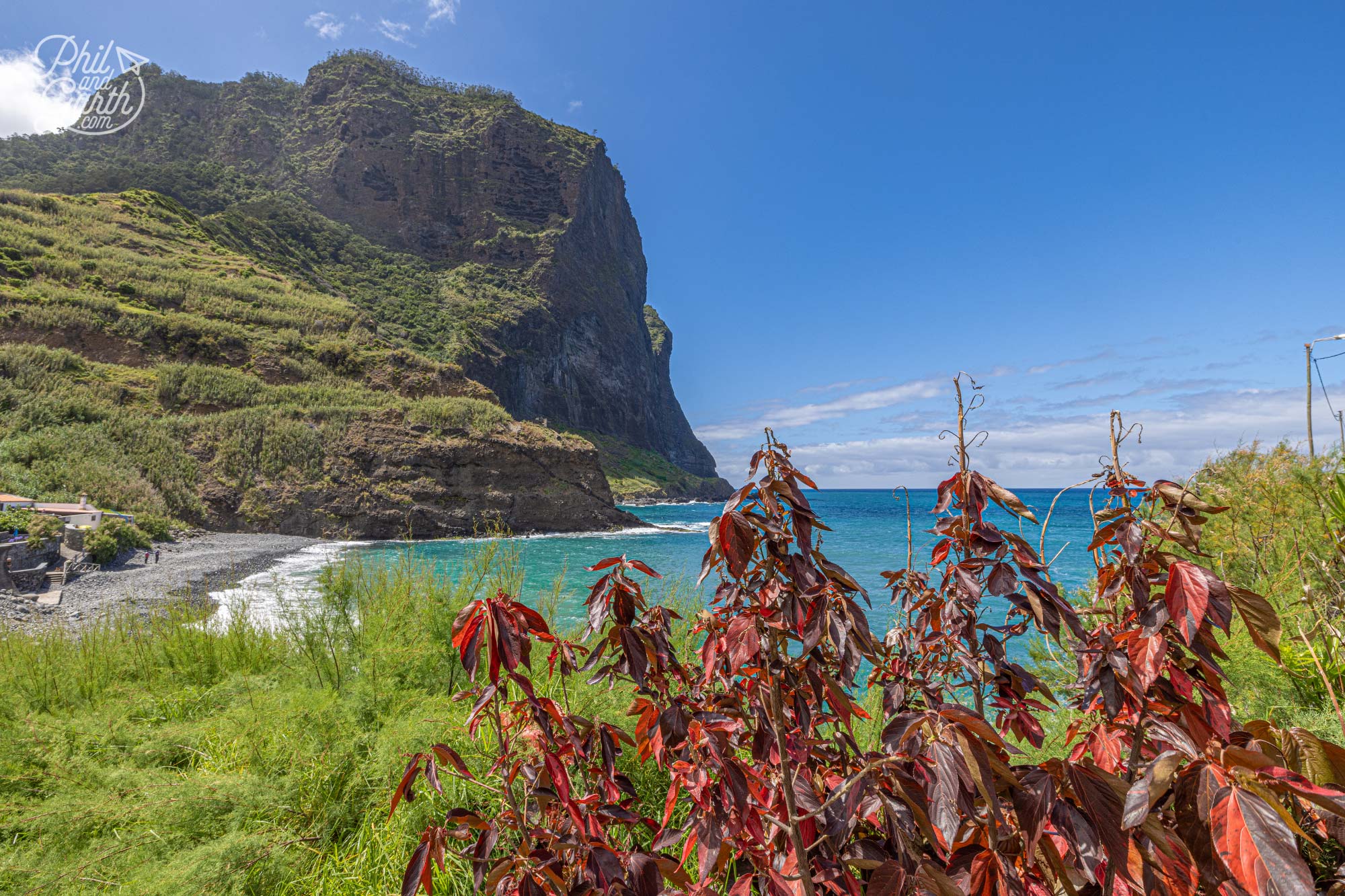
The pretty waterfront at Porto da Cruz
Our last stop was the mostly easterly point on Madeira – Ponta de São Lourenço. It’s a nature reserve and very different from the lush interior of the island. Instead, it’s sparse with little greenery, reminding us a little of the rugged English coastline like Cornwall.
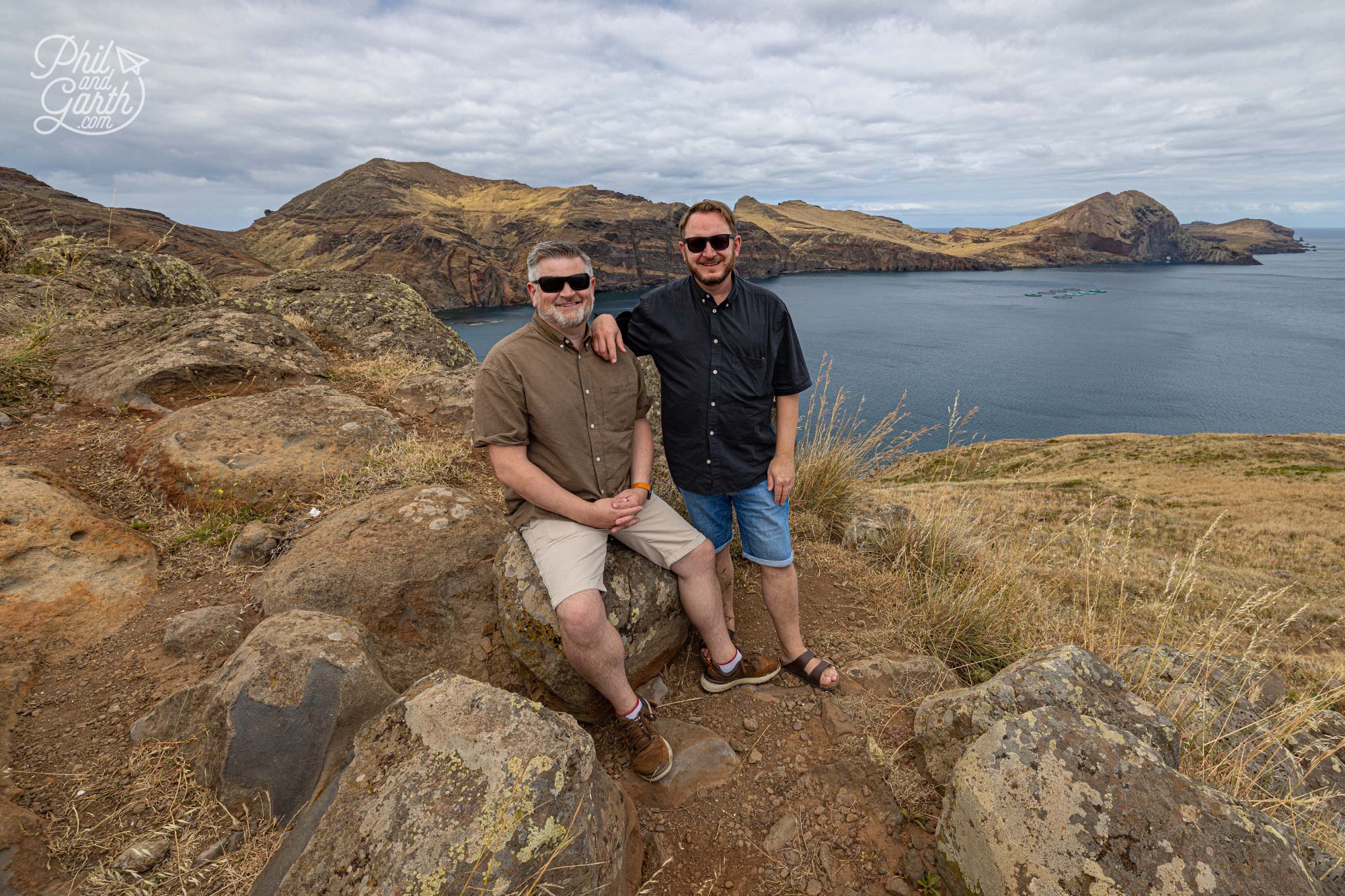
The headland and nature reserve of Ponta de São Lourenço
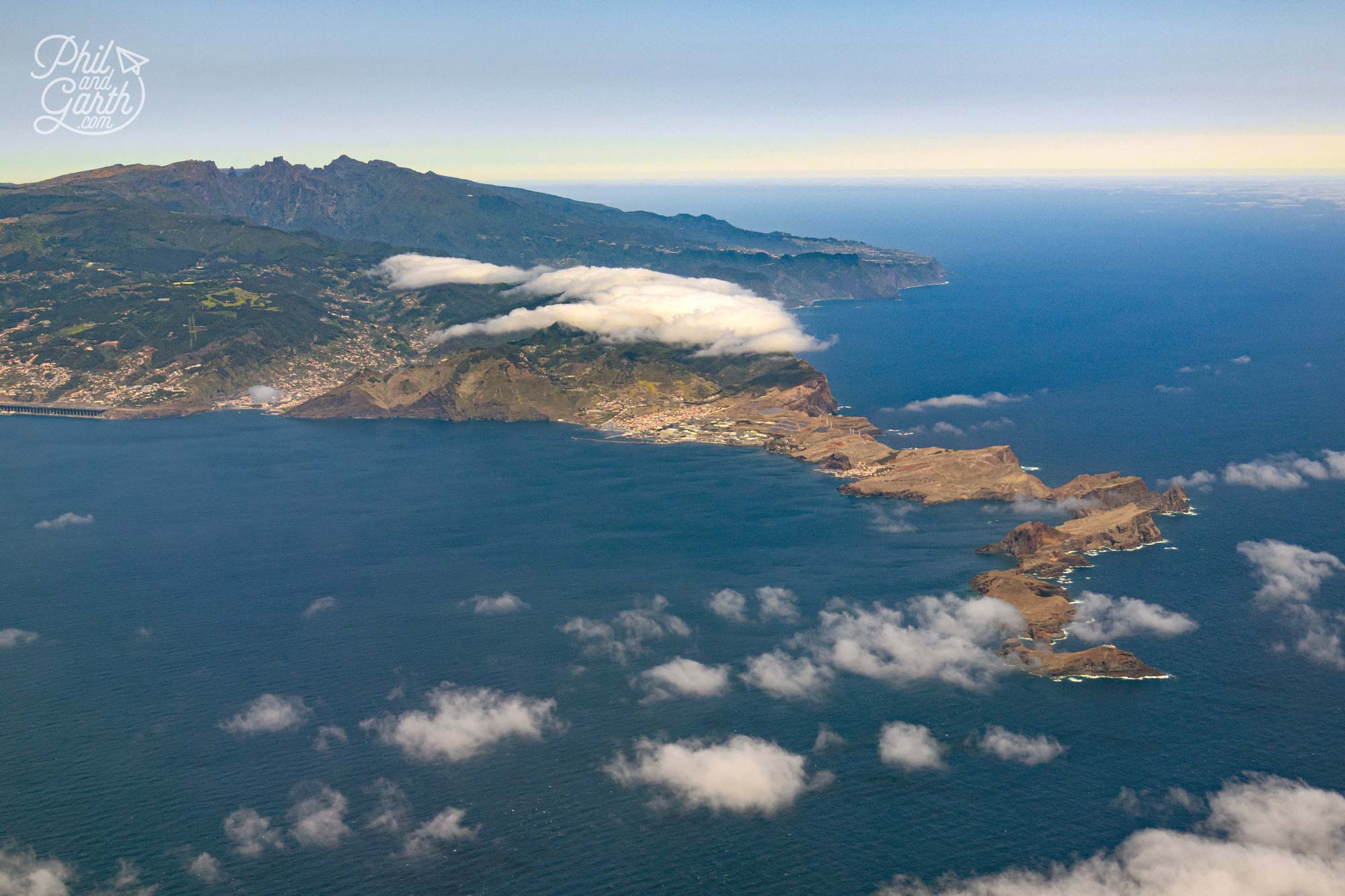
Ponta de São Lourenço as seen on the plane home
Madeira Practical Information and Useful Advice
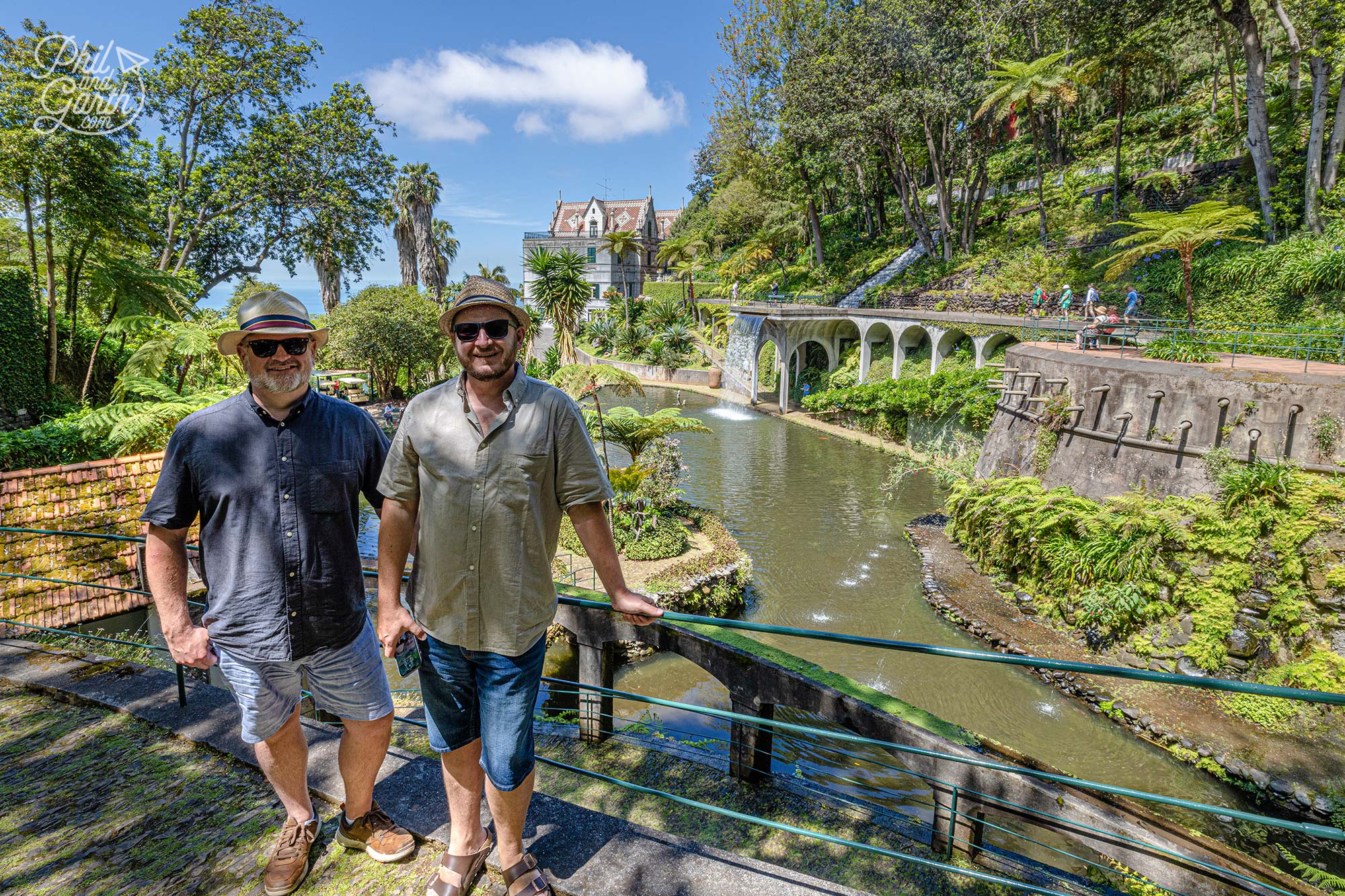
Phil and Garth’s Top 5 Madeira Travel Tips
Phil and Garth’s Top 5 Madeira Travel Tips
- Tip #1: April to October is the best time to spot whales and dolphins.
- Tip #2: If you are going swimming off the lava rocks wear plastic sandals.
- Tip #3: Because of all the mountains it can take a while to get anywhere so plan ahead.
- Tip #4: Madeira has lots of mosquitos, so take some repellent spray.
- Tip #5: Be prepared for unexpected downpours anytime. Madeira’s sub-tropical climate means showers can happen at any time. In February 2010 Madeira suffered some deadly floods.
Google Map of Madeira – 10 Great Things To Do In Funchal
Madeira FAQ
- What is Madeira’s airport code? FNC – Formally Santa Catarina Airport and officially Cristiano Ronaldo International Airport.
- How long is the flight to Madeira from the UK? 4 hours
- How long does it take to transfer from Madeira airport to Funchal? 1 hour.
- What time zone is Madeira? GMT +1 hour.
- What currency is used in Madeira? Euro (symbol: €)
- What language is spoken in Madeira? Portuguese
- What is the population of Madeira? 270,000
- What number should I call in an emergency? – 112.
- What plug type is used in Madeira? The island uses plug types C & F. Voltage is 230V / 50Hz.
- When is the best time to visit Madeira? The end of July to mid-September offers the best temperatures around 25ºC and very little rain.
- When is the worst time to visit Madeira? June can be cloudy and Winter and Spring can have some heavy rainy days. December is the wettest month.
- What is Madeira famous for? Gardens, wine, towering cliffs and hiking.
- What is the best way to get around? A hire car is the best way to get around and to make the most of your time.
- What’s a fun fact about Madeira? Every New Year’s Eve Funchal holds one of the world’s biggest fireworks shows.
- What movies have been filmed on Madeira? Ronaldo (2015), Moby Dick (1956), Porto Santo (1997).
- Where is the best photo spot? Madeira Botanical Garden.
- Where is a hidden gem in Funchal? São Tiago Beach.
- What’s the best souvenir to buy in Madeira? A bottle of Madeira wine or bolo de mel (honey cake).
- What is the official Madeira tourism website? Click here for the official tourist website.
Our 7 Day Funchal, Madeira Itinerary
- Day 1 – Fly to Madeira
- Day 2 – Relax at your hotel.
- Day 3 – East Island Tour – full day.
- Day 4 – Start early and visit Monte Palace Tropical Gardens, and Botanical Garden then take the Toboggan ride back.
- Day 5 – Explore the old town and take the wine distillery tour.
- Day 6 – Visit the farmers market & street art.
- Day 7 – Relax at your hotel.
- Day 8 – Fly home.
How We Did It
We visited Madeira at the beginning of June and paid for a package holiday with Jet2.com and stayed at the Quinta da Bela Vista 5-star hotel.


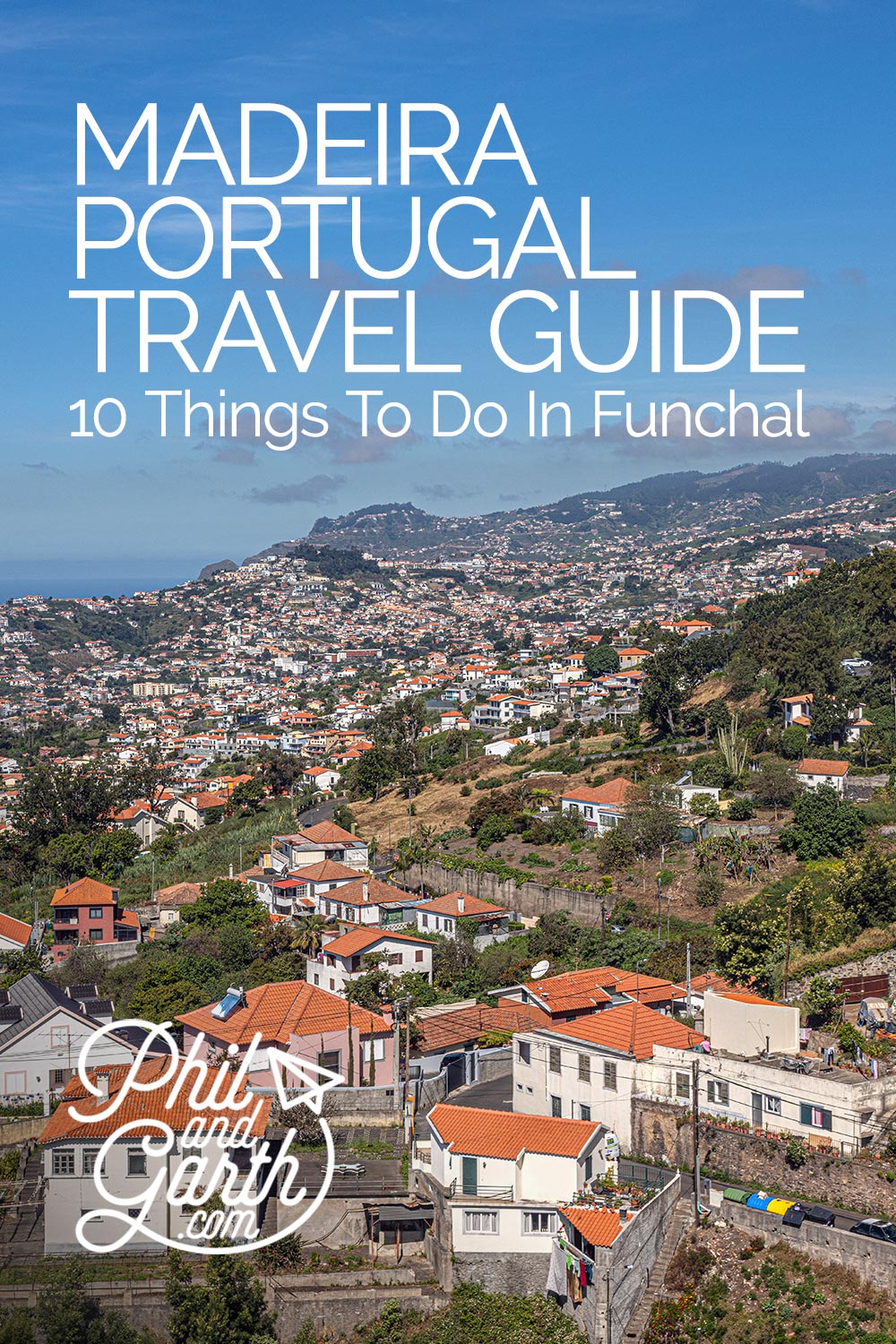
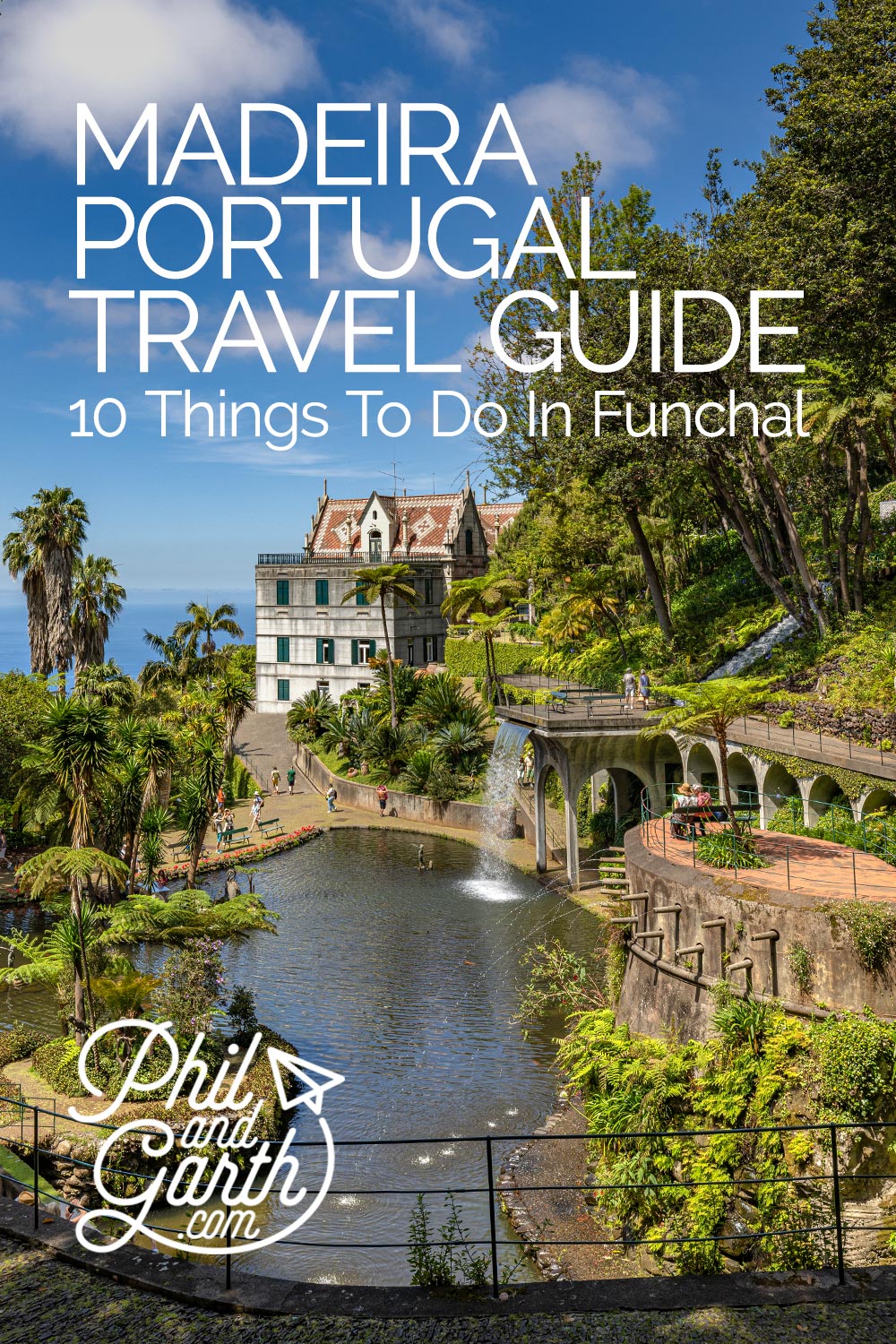
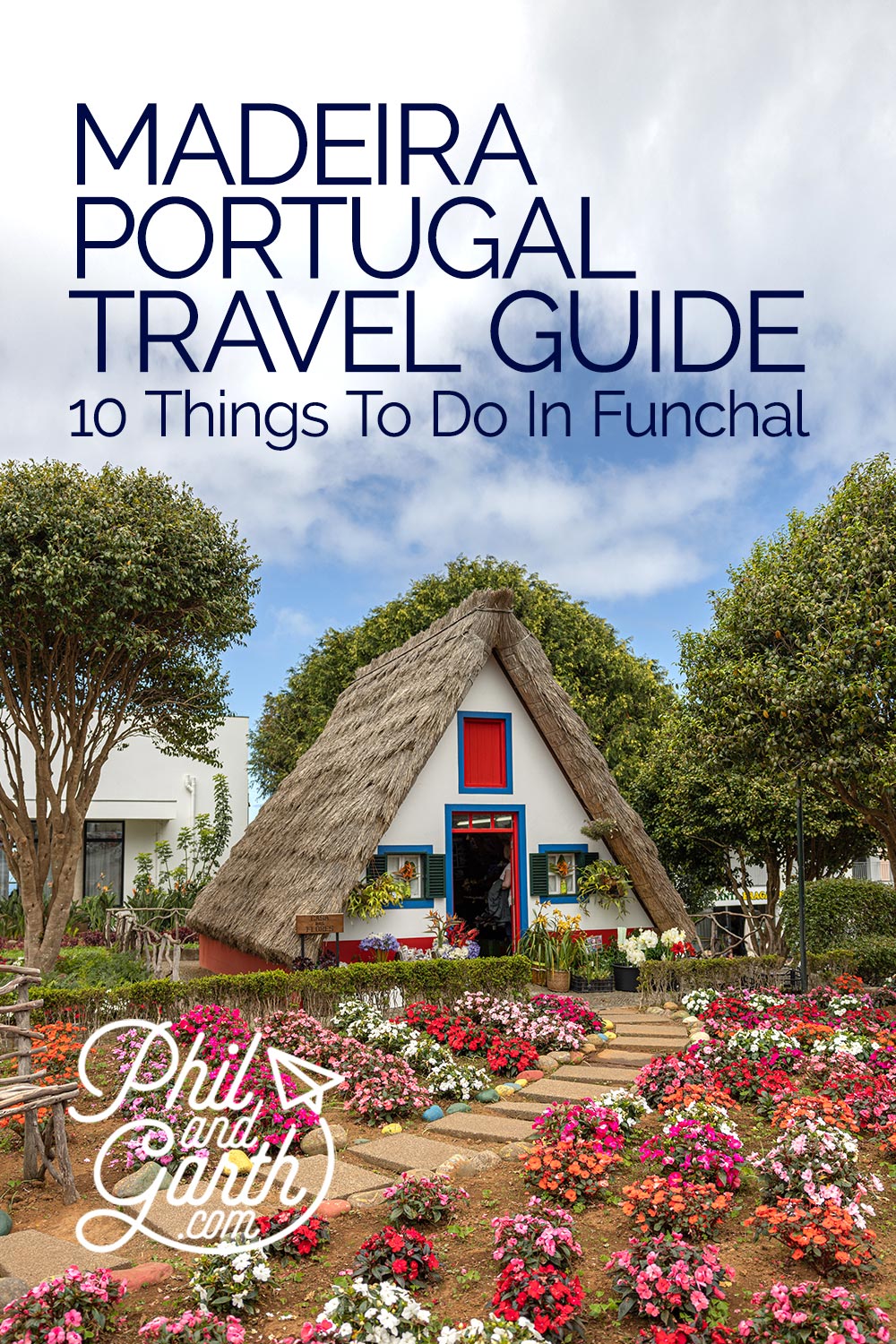
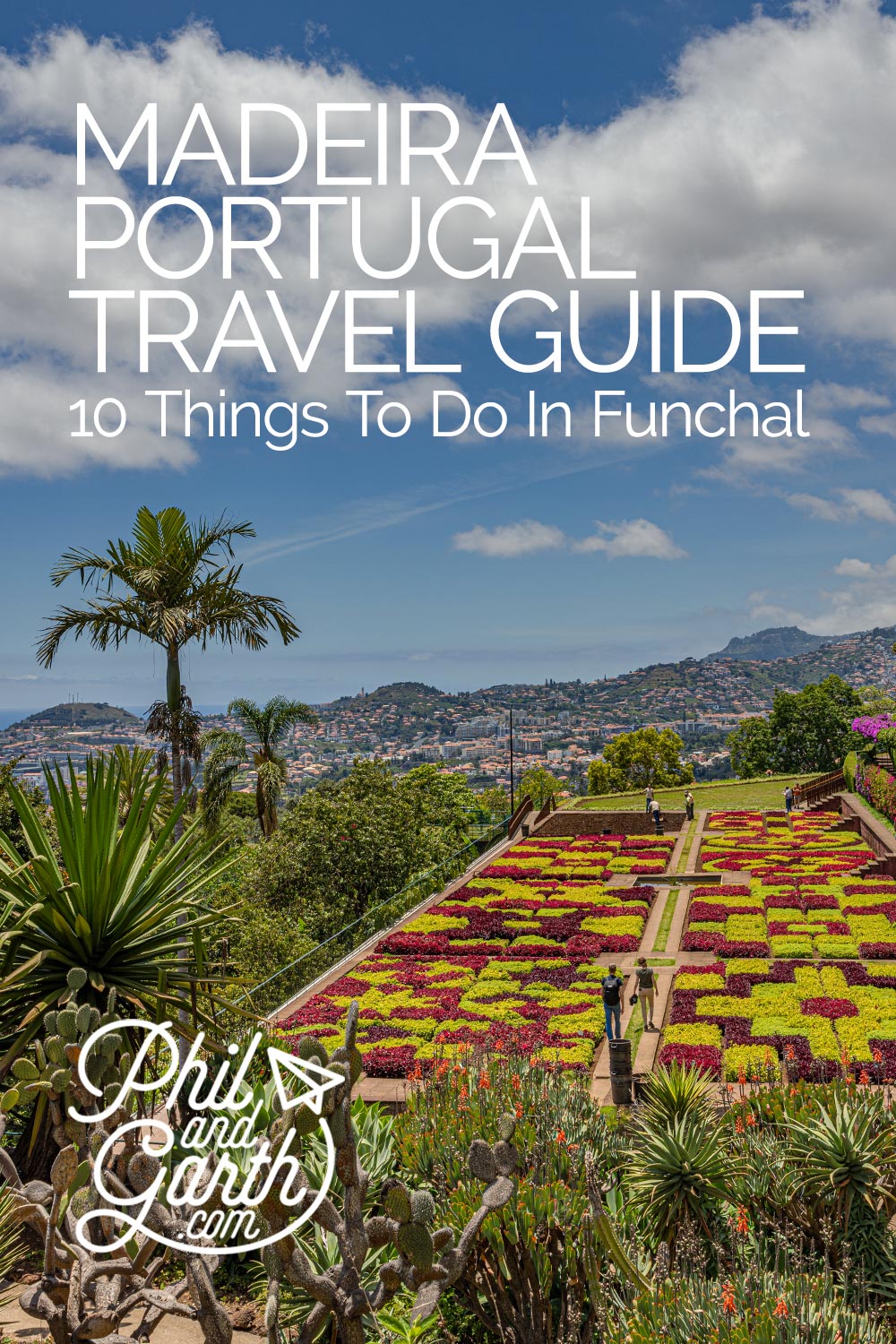
1 comment
What an amazing destination! As always, you’ve captured it so well with your beautiful photography. We’ve seen the wicker toboggans, which of course went right on our Must Do list! Of course, that list is longer now. 😉 This will come in handy when we finally make our way to Portugal!